Foreword
“The Zhang Clan Odyssey” is the intimate pursuit by Raymond Douglas Chong (Zhang Weiming) at Gold Mountain (America) to discover his Zhang clan ancestral roots in Cathay (China).
Since January 30, 2003, after the suicide of John Thomas Killip in Monterey, California, the bamboo rod (American Born Chinese (ABC)) learns and grasps the epic saga of his Zhang forefathers in Cathay.
Since 2003, a mystical metamorphosis has enveloped Raymond Douglas Chong. Before, an American Born Chinese and professional engineer pursuing the American Dream in Gold Mountain. Now, a proud American with deep ties to China, while transmuting to writer, poet, and lyricist. He has discovered sad stories, huge legends, and dark secrets in Cathay.
Its climax is the return of a fallen leaf (sojourner) from Gold Mountain to Yung Lew Gong (Long Gang Li) - Village of Dragon Hill, in Hoyping (Kaiping) - Land of Peace in Kongmoon (Jiangmen) City in Kwangtung (Guangdong Province) in Cathay. The mystical allure of the Yung Lew Gong with its Diaolou (stony watchtower) near Mountain of Eight Immortals Crossing the Sea along Tam Kiang (Tanjiang) river lures the heart and soul of a fallen leaf from Gold Mountain.
420-618 AD, Zhang Shouli and Junzheng: A Beginning
Birth of Zhang Shouli: The Tail End of Turmoil
Let us go back, way back. It is the second half of the sixth century AD, and China is in a continuous state of chaos and civil war. The once unified and powerful Chinese Empire has become a ravaged, divided, ragtag group of warring states and dynasties led by different ethnic groups. At the same time, culture and arts are flourishing, technology is advancing, and Buddhism and Daoism are gaining a foothold.
The era became known as the “Northern and Southern Dynasties,” which saw so much social unrest that an overwhelming number of Han Chinese migrated from the north to the lands just south of the Yangtze River (in today’s central China).
It may be that your great (x51) grandfather Zhang Shouli was among the many thousands forced to migrate south, as we know that at some point, he lived in the lands around the Yangtze River. More specifically, your first known ancestor Shouli lived in a place called Tushan in Zhongli prefecture, around today’s Fengyang county in Anhui province.1
While we do not know where Zhang Shouli was born, in 570, the timing of his birth would have been during the latter stages of the Northern and Southern Dynasties (420-589 AD).2
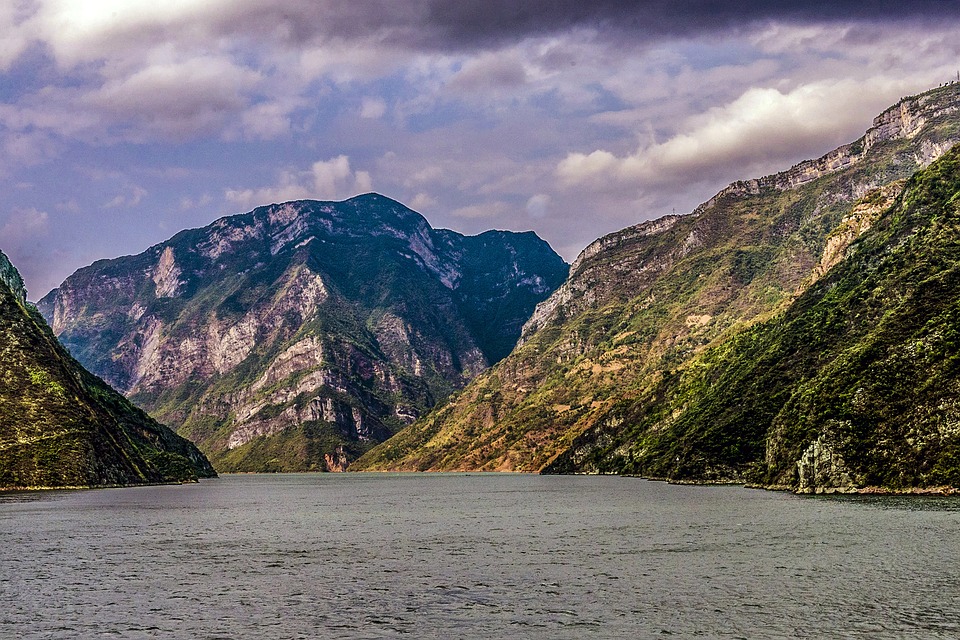 Yangtze River
Yangtze River581 AD: The Sui Dynasty and a Unified China
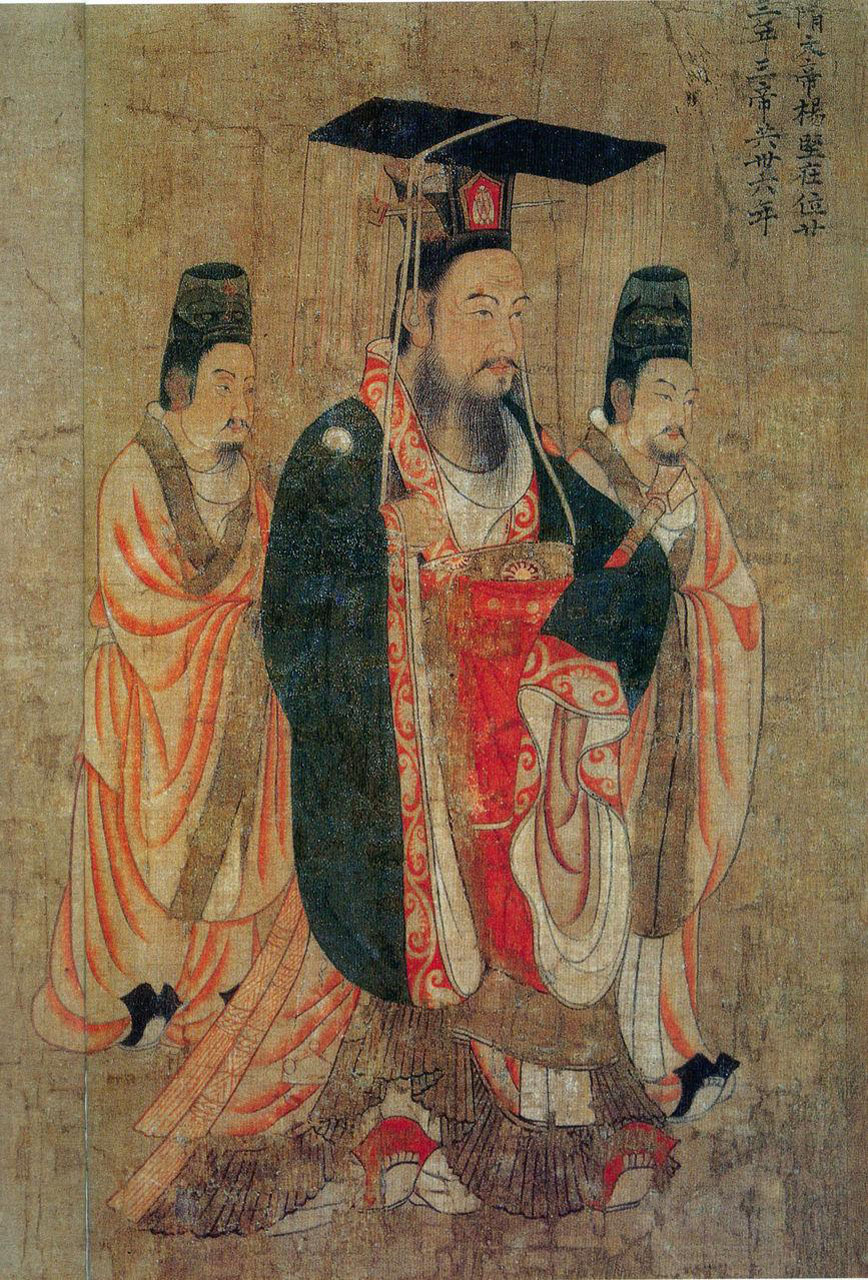 The Sui Emperor
The Sui EmperorAround the time Zhang Shouli was a boy, possibly a young teenager, a bloody purge was taking place up north that brought a stop to centuries of chaos. In the Imperial Palace in the Empire’s capital of Chang’an (today’s Xi’an in Shaanxi province), the Duke of Sui had 59 princes of the royal family killed.
And so it was that in 581 AD, the duke proclaimed himself the first Emperor of the Sui Dynasty and cultivated a public persona known as the "Cultured Emperor." The new Emperor reunified Southern China – ruled by impromptu courts of aristocratic families who had fled there from the north – and Northern China, previously controlled by foreign rulers, thereby reinstalling the rule of ethnic Han Chinese to the entirety of China.
The Grand Canal
Zhang Shouli had three sons, the youngest of whom was your ancestor Zhang Junzheng. Junzheng was likely born around 600 AD, against the backdrop of a newly unified empire entering a golden age of prosperity. Agricultural surpluses supported rapid population growth and wide-ranging reforms and mega-construction projects were undertaken that still has impact on Chinese society 1400 years later.
Living in Fangcheng in Fanyang (today’s Beijing, Tianjin and Baoding prefecture), Junzheng will have noticed at least one of these mega-construction projects while growing up: the building of the Grand Canal.3
The Grand Canal connected the Yellow and Yangtze Rivers, the two most important rivers in China’s history. With the eastern capital of Luoyang at the center of the network, the Grand Canal linked the west-lying capital Chang'an (today’s Xi’an) to the economic and agricultural centers of the east towards Hangzhou, as well as to the northern border near modern Beijing, where your forefather Junzheng lived.
While the initial key goal of the Grand Canal was to ship grain to the capital and transport troops and military equipment, the canal was to facilitate domestic trade, the flow of people and cultural exchanges for over a millennium to come.
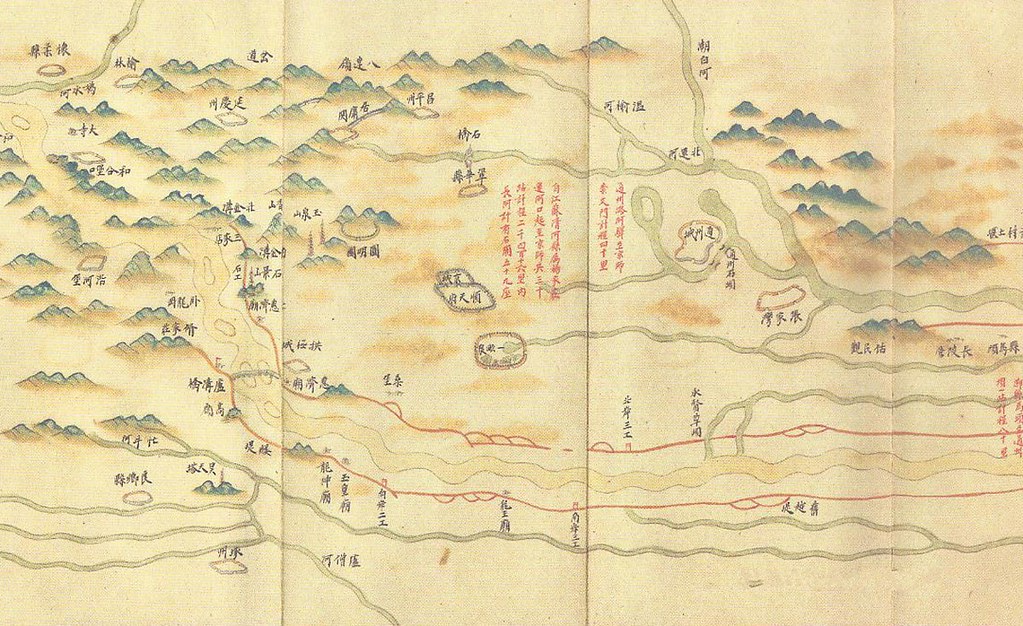 Ancient map of the Grand Canal
Ancient map of the Grand CanalFall of the Sui Dynasty
But the mega-construction projects, which in addition to the Grand Canal also included parts of the Great Wall, were about to take their toll. Financing the projects strained the economy, and many of the millions of conscripted construction workers died due to the harsh working conditions, angering a resentful workforce. Rural rebellions further drained the military, the agricultural sector, and thus the economy.
Zhang Junzheng will likely have been coming of age when he heard the news that the Sui Emperor had been assassinated by a group of his own advisors in 618.
And thus, a mere 37 years after its establishment, the Sui Dynasty fell, leaving a legacy that far surpassed its tenure, and paving the way for perhaps the most celebrated of all dynasties in Chinese history: The Tang Dynasty.
618-678 AD, Tang Dynasty: Junzheng Arrives in Guangdong
Junzheng Sows the Seeds for the Guangdong Zhang Clan
Zhang Junzheng was to build a successful career in government under the Tang rulers, who hailed from an aristocratic, northern Han Chinese family.
Your great (x50) grandfather Junzheng managed to climb his way up to become a vice-mayor, a position he obtained during the reign of Taizong, the second Tang Dynasty emperor, who ruled from 626 to 649 AD. The prefecture that Junzheng presided over was called Shaozhou and located in Guangdong province, a relatively remote area of the Tang empire at the time.
Emperor Taizong
Taizong, whose reign lasted from 626-649 AD, is often seen as one of the greatest emperors in China's history. His reign became the model against which future emperors were measured and was literally treated as required study material for future crown princes. Under Taizong’s reign, China flourished economically and militarily, largely enjoying prosperity and peace across a territory stretching to today’s Vietnam in the south, and Xinjiang and eastern Kazakhstan in the west.
Uncommon for nobility at the time, Taizong was a rationalist who valued logic and scientific reason, openly scorning superstitions and claims of signs from the heavens.
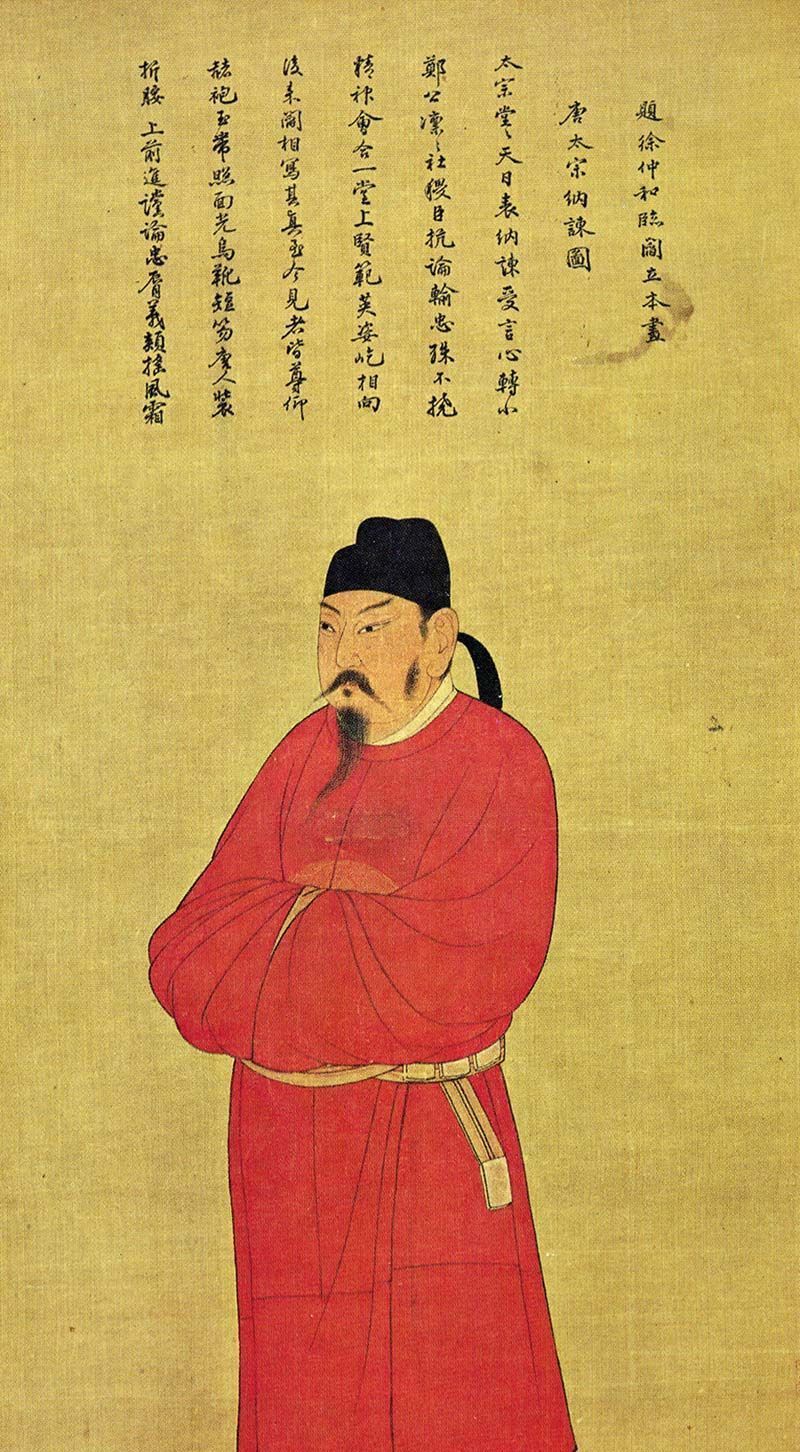
Zhang Junzheng was your first Zhang ancestor to settle in Guangdong. The place he settled was in the northern part of the province, along the borders with Hunan and Jiangxi.
A vice-mayor of a prefecture (“zhou”) was a position of influence. China’s population at the time stood around 50 million people, and with a few 100 prefectures, one prefecture could easily count over 150,000 residents.4 Such a position did not just bring political influence, it brought wealth, employment, and considerable status for the extended family.
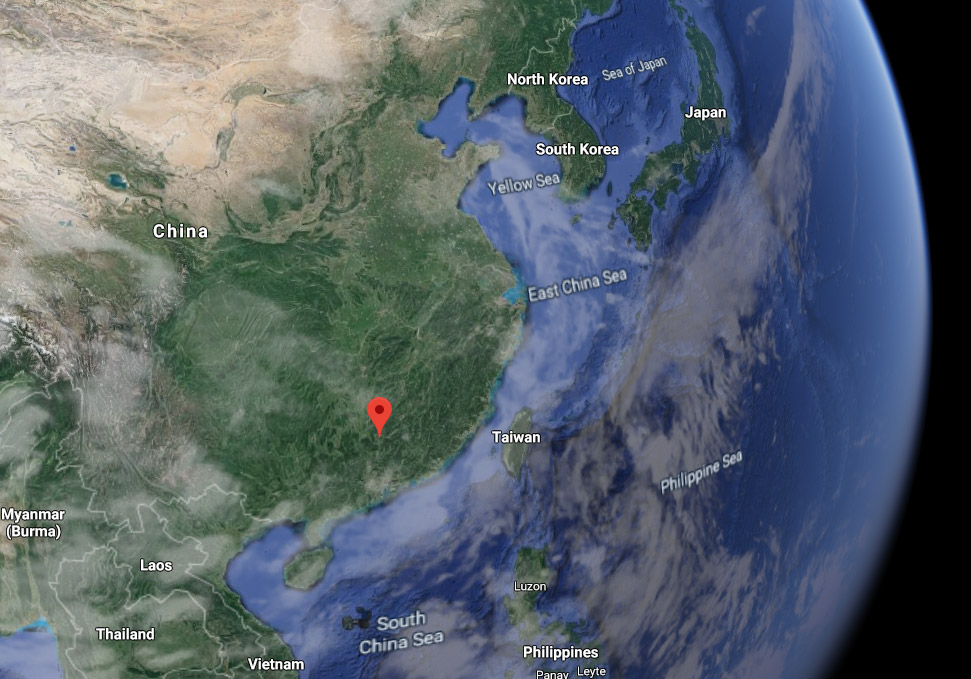 Shaozhou in Guangdong, which borders the provinces of Hunan and Jiangxi
Shaozhou in Guangdong, which borders the provinces of Hunan and JiangxiJunzheng died before he reached retirement. After his death, his descendants settled in Shaozhou (in today’s Qujiang district of Shaoguan city, Guangdong province).5
Zhang Zizhou: County Magistrate
Junzheng had six sons, the eldest of whom was your great (x49) grandfather, named Zhang Zizhou. Zizhou was likely born around a quarter into the 7th century, in the early stages of the Tang Dynasty and around the time Taizong ascended the throne.
Undoubtedly partly due to his father’s government position, Zizhou obtained the role of magistrate of Yueshan County (today’s Xinchang County, Shaoxing City, Zhejiang Province). County magistrate was one administrative level lower than the (vice) mayor of a prefecture (or “zhou”).6
Administratively, counties were the most fundamental units of local government. To common villagers, the county magistrate was typically “the face” of government in general, as he was the lowest administrative leader that directly represented the Emperor – the Son of Heaven – himself.
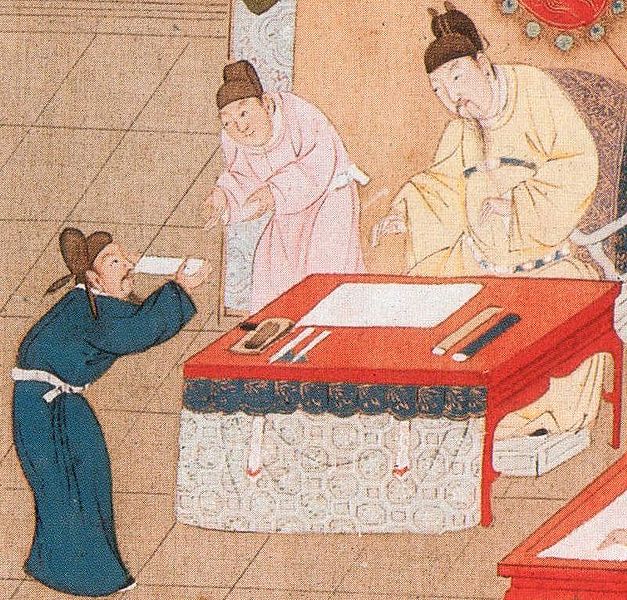 Imperial Examinations
Imperial ExaminationsThe appointment of magistrates at times was a contest between the central bureaucracy, which represented the interests of the emperor, and local nobility and elites. Imperial representatives were typically scholar-officials who had gone through the rigorous Imperial Examinations and were selected largely on merit rather than birth (as was the case with the local aristocracy). During the Tang Dynasty, this contest was reduced in relevance as the "rule of avoidance" was increasingly observed. This rule forbade magistrates to serve in their home county because of the danger of nepotism and favoritism to family or friends. Magistrates could also only serve up to four years in one place before being transferred.
The magistrate's responsibilities were broad but not clearly defined. The county magistrate supervised units of control below the county level. These included village elders, local institutions, and self-ruling townships.
Zhang Hongyu and Jiuling: Like Father, Like Son
Zhang Zizhou had four sons; the eldest was called Hongyu.7 With his grandfather a prefectural vice-mayor and his father a county magistrate, Zhang Hongyu was born into a family of privilege. Growing up as a young man, he was unlikely to ever be worried about his prospects of finding work. Indeed, Hongyu found a perfectly good job as a minor government official in Suolu County in Xinzhou Prefecture (today’s Xinxing County, Yunfu, Guangdong Province).
It must have been in the second quarter of the 8th century, towards the end of his life, or perhaps even posthumously, that Hongyu was awarded the honorary title of Taichang Qing, which made him a “director of sacrificial worship.” Interestingly, he did not receive this title because of the achievements of either his father or grandfather, but instead thanks to the those of his oldest son Zhang Jiuling.
678-740 AD, Zhang Jiuling: Golden Age for China and Your Zhang Clan
Jiuling: Promising from the Start
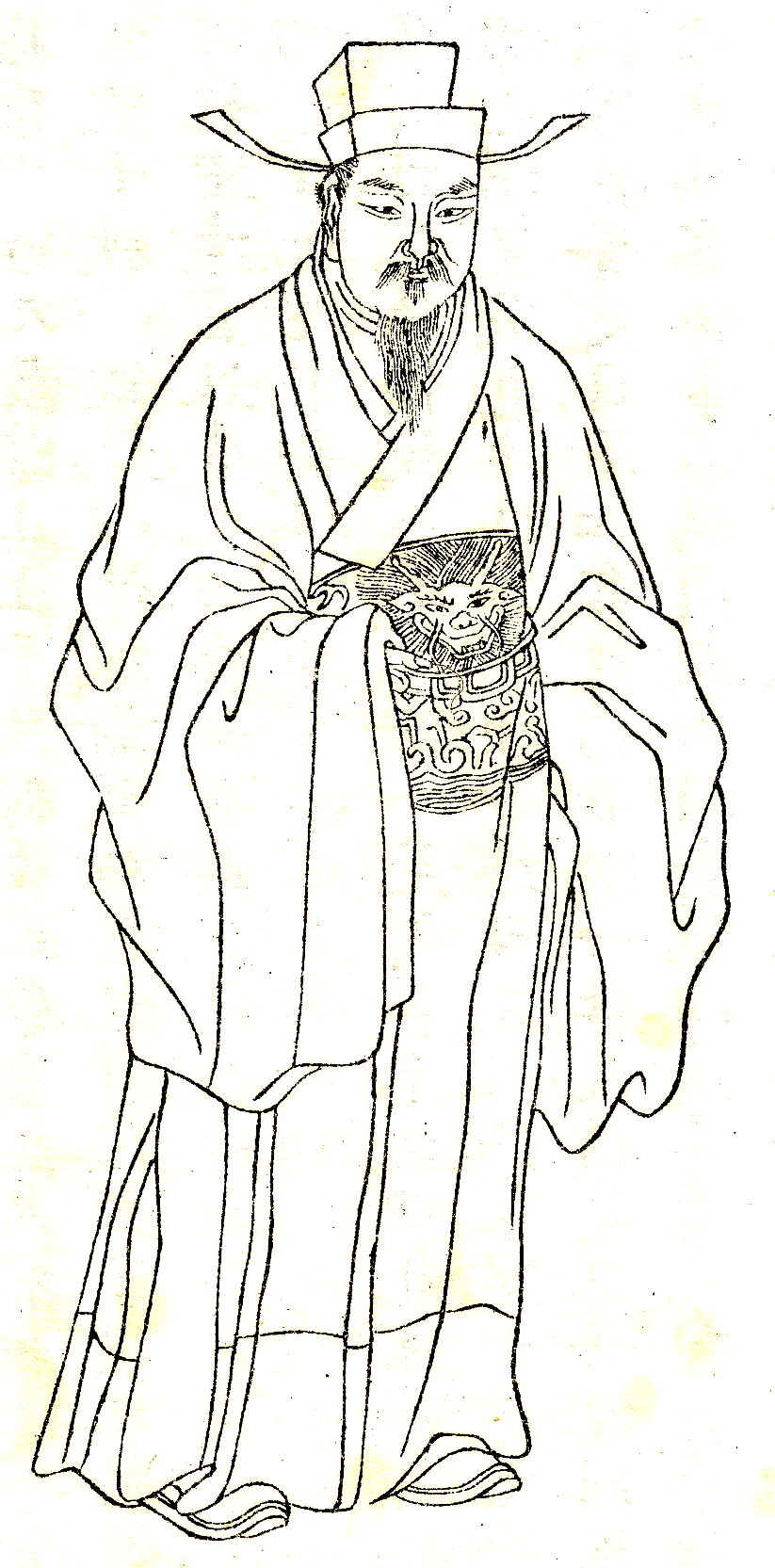 Zhang Jiuling
Zhang JiulingZhang Jiuling was born in 678 in Qujiang, Shao Prefecture, Guangdong. He had two younger brothers: Jiugao and Jiuzhang.8
From an early age, Jiuling was exposed to scholar-officials, several of whom had publicly praised his intellect and literary talent. Later on, Jiuling passed the highly prestigious imperial examinations, which had become more prevalent during the Tang Dynasty, as a way to make the path toward becoming a scholar-official more merit-based, rather than custom for the aristocracy. Jiuling achieved the highest possible score in the examinations.
Jiuling became known for his exceptional skills in seeing through people’s characters and spotting their talents. In the first decades of the 8th century, he rose quickly through the government ranks, up to the point that the Xuanzong Emperor appointed him as one of the key officials at the highest level to assign postings to civil servants.
Your great (x47) grandfather married Ms. Tan, and was on his way to becoming a prominent minister, noted poet and scholar of a Tang Dynasty that was at the height of its magnificence. The world was at his feet.
Imperial Examinations
The Imperial Examinations were the doorway to political, social and economic success throughout much of China’s history. The system was designed to select men for government service according to intellectual merit rather than ancestry or wealth.
The examinations themselves were free and open to all adult Chinese males. However, taking the examinations was costly due to the travel and lodging costs, and years’ worth of study, during which the relevant son could not work to make money for the household. As the social and economic success would be shared with the wider family, rural sub-clans often collectively financed the education of its most promising young talent.
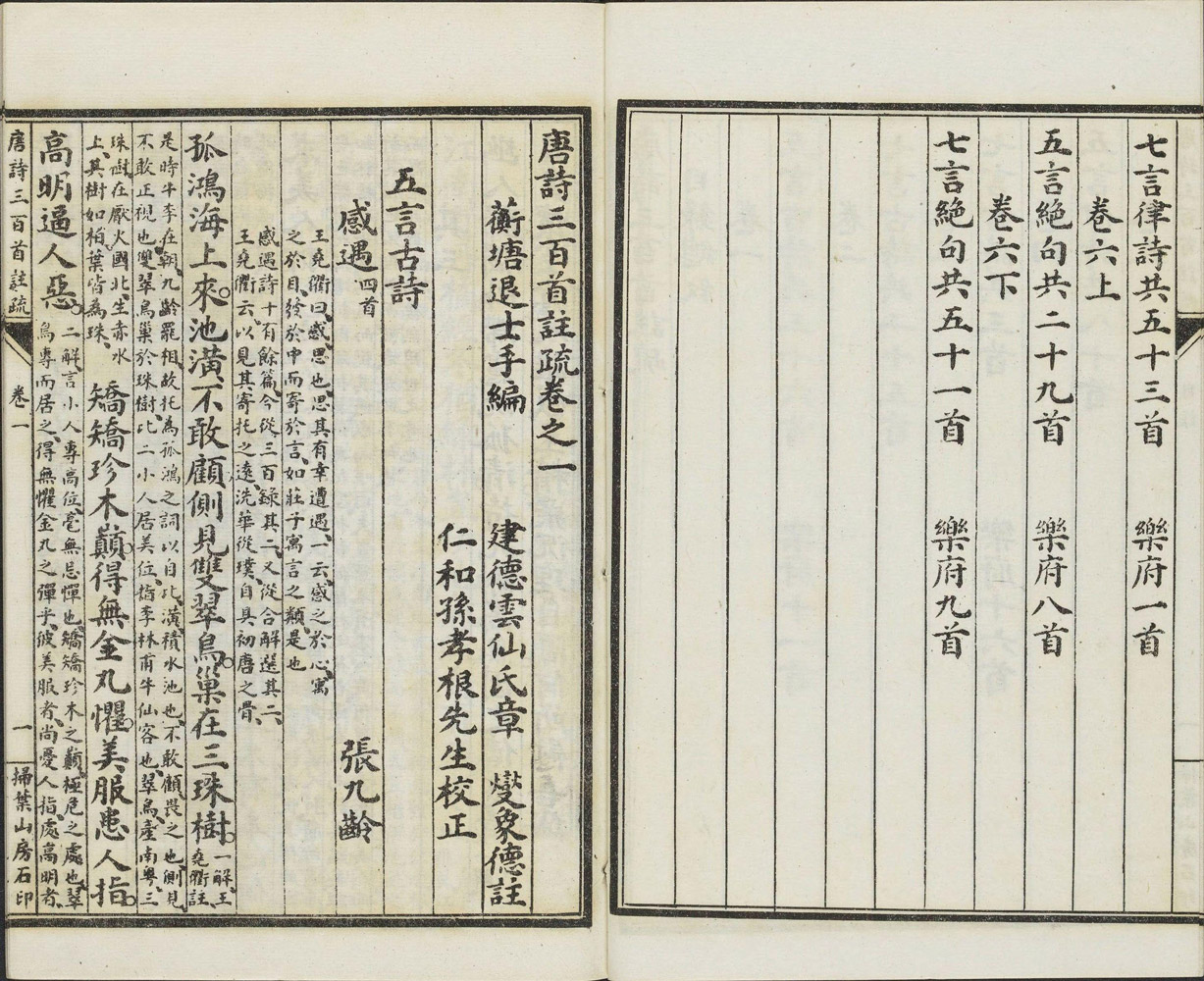 A poem by Zhang Jiuling in the famous anthology *Three Hundred Tang Poems*
A poem by Zhang Jiuling in the famous anthology *Three Hundred Tang Poems*The Tang Dynasty in All Its Glory
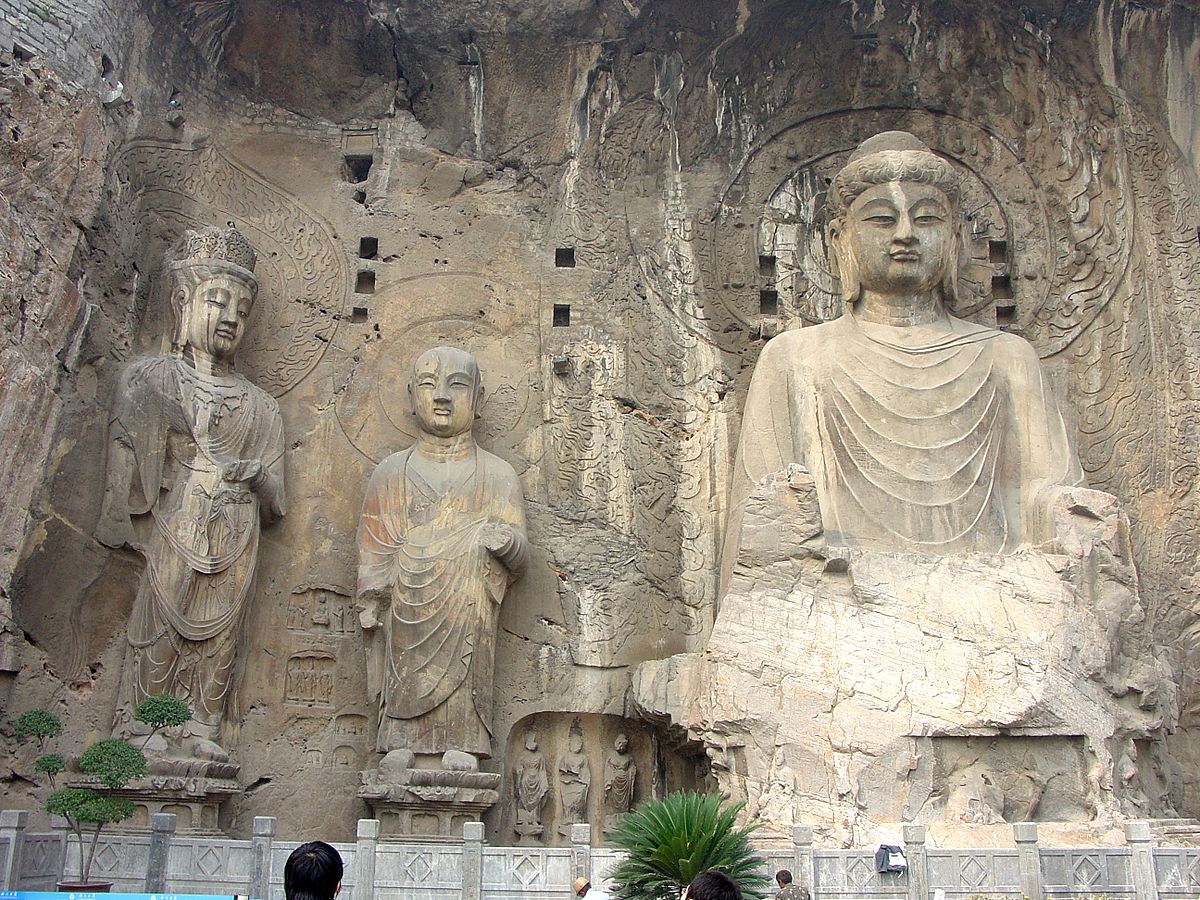 Known as a "Chinese Mona Lisa," the largest Buddha statue at the Longmen Grottoes in Luoyang was supposedly carved in the image of Empress Wu.
Known as a "Chinese Mona Lisa," the largest Buddha statue at the Longmen Grottoes in Luoyang was supposedly carved in the image of Empress Wu.Cosmopolitan, dynamic, expansive: All adjectives commonly attributed to the Tang Dynasty today. In reality, it was only the first half, i.e. the first 150 years, that gave the Tang Dynasty that reputation. In that period, China saw vast territorial expansion and increase in international and interregional trade. It was the golden age of Chinese poetry and cultural flowering. The Tang capital of Chang’an (today known as Xi’an) grew to be the largest city in the world, attracting traders, students and pilgrims from all over Asia. Buddhism became a major influence in Chinese culture. The high point of Tang culture came in the first half of the 8th century under Emperor Xuanzong, the grandson of Empress Wu. A fan and patron of poetry, music and the arts, he also invited Daoist and Buddhist clerics to perform rituals in court to aid the victory of Tang forces and avert drought.
Emperor Xuanzong
His reign was the longest among all Tang Emperors, lasting from 713 to 756 AD. In the first half of his reign, he brought China to the pinnacle of culture and power. Politically, he increased government efficiency, reduced corruption, raised officials’ accountability, and improved mechanisms to appoint and remove county magistrates. Economically, he shifted land ownership from local governments to peasants, allowing farmers to buy and sell their own land.
The second half of his reign, however, showed the opposite picture: a self-indulgent, careless ruler, who set in motion the start of the decline of the mighty Tang Dynasty.
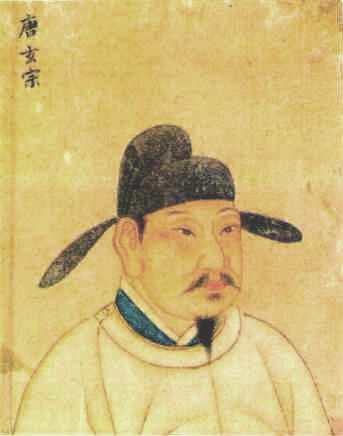
Empress Wu Zetian
The Tang Dynasty was briefly interrupted by an unlikely foe: Empress Wu Zetian (a woman!) seized the throne in 690, and ruled the Zhou dynasty for 15 years. The concubine of the second Tang emperor, Taizong, she was the only officially recognized reigning Empress in the history of China. Learn more.
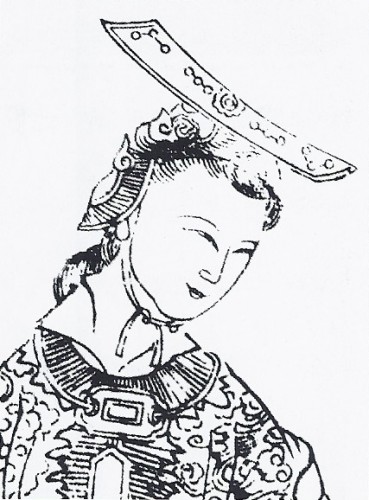
Zhang Jiuling and Filial Piety
He also built a reputation for his filial piety. In 726, he requested to be posted to a prefecture south of the Yangtze River, so that he could be closer to his ill mother in Shao Prefecture. Emperor Xuanzong not only granted his request by making him a prefecture commandant in modern day Nanchang in Jiangxi province, he also issued an edict praising Jiuling for his filial piety. Moreover, Emperor Xuanzong also made his brothers Jiuzhang and Jiugao prefects in the region, so that all three sons could visit their mother regularly. In 732, Jiuling’s mother died, and he returned to Shao Prefecture to observe a period of mourning.
Chancellor!
The next year however, his mourning period was cut short as Jiuling was appointed Chancellor to the Emperor, one of the very highest positions in the Tang Dynasty civil service. One characteristic that negatively impacted his reputation was that he was impatient and easily angered. On the other hand, Jiuling was also said to be honest and always seeking to correct the emperor's behavior, even if it offended the emperor.
Zhang Jiuling vs. An Lushan
In 736, Jiuling recommended that the Emperor Xuanzong execute a talented, rising military star named An Lushan. An had publicly disobeyed an order by a superior, and Jiuling was fearing a bad precedent would be set unless the Emperor acted decisively. Moreover, Jiuling felt strongly that An had the temperament to commit treason and would surely do so in the future. However, Emperor Xuanzong was too impressed by An's military talent and essentially pardoned him.
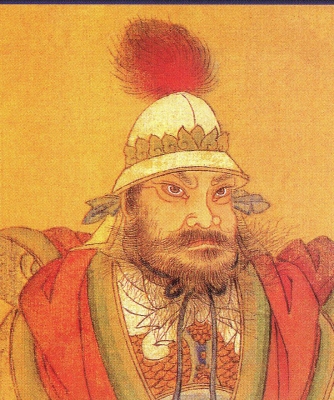 An Lushan
An LushanJiuling moved to Huxi Township, staying within his ancestral county of Qujiang in today’s Shaoguan, Guangdong province.9 He died in 740 at the age of 62, while on a vacation in Shao Prefecture to visit his parents' tomb.
16 years later in 756, the An Lushan Rebellion shook the Tang Dynasty, and Emperor Xuanzong was forced to flee south to modern Sichuan and Chongqing. Remembering Jiuling's warning about An, he issued an edict posthumously honoring your great (x47) grandfather and sent messengers to Shao Prefecture to offer him sacrifices.
An Lushan Rebellion (755-763 AD)
An Lushan was a Tang military general of Turkic origin who rose to power in part thanks to his (likely romantic) relationship with Emperor Xuanzong’s favorite concubine: Yang Guifei. In 755 AD, An Lushan turned against the emperor and marched his troops to the capital of Chang’an (today's Xi'an). Forced to flee, Xuanzong first executed his beloved consort Yang Guifei and, overcome with grief, abdicated upon his arrival in Sichuan.
An Lushan declared himself Emperor and established a new Yan Dynasty, which ended a mere seven years later due to internal dissent. The Tang Dynasty would never truly recover its prior cosmopolitan empire.
8th Century (2nd Half), Zhang Zheng to Dunqing: Tail End of Tang Heyday
Zhang Zheng: Senior Imperial Scapegoat
Zhang Jiuling had two sons: Zhang Zheng and Zhang Ting.10
Zheng developed a reputation for being righteous and never afraid to stand up for what he believed was right, no matter how powerful his counterpart. He was a type of counselor or “reading partner” of the Tang crown prince. His responsibilities were to study alongside the prince as a supporting party to help the prince out. Interestingly, his role also included receiving the teacher’s blows and punishment in instances where those were actually meant for the crown prince. As the crown prince was expected to become emperor, teachers were not able or allowed to punish the crown prince directly, and Zheng was thus a senior-level imperial scapegoat.11
He married Ms. Qiu and they had two sons: Zhang Cangqi and Zhang Guoqi.12
Zhang Cangqi
Zhang Cangqi was born around the turn of the 8th century and was also known as Daxue. Like his father and grandfather, he obtained an official role at the Imperial Palace. His title was that of Huangmen Shilang, i.e. officer at the palace, and later he was promoted to the position of Minister of Public Works, which put him in charge of national water conservancy and civil engineering, transportation, as well as government and industrial works.13
Zhang Dunqing: Father of Four Very Successful Sons
Zhang Cangqi had one son named Zhang Dunqing. Dunqing may well have been one of the proudest fathers in your entire Longgangli Zhang lineage, with all his four sons becoming very high level government officials in the heart of the all-powerful and cultured Tang Dynasty, around the second half of the 8th century.
Dunqing also had achievements of his own to be proud of. In good family tradition, Dunqing became a government official, and he gradually climbed his way up to become a Dianzhong Shiyushi or censor.14 The Censorate of the Tang empire consisted of three departments: The Headquarters Bureau, the Investigation Bureau, and the Palace Bureau.
The Headquarters Bureau controlled the state officials, interrogated criminals, and supervised the capital granaries and parts of the Imperial Treasury. The Investigation Bureau controlled the empire’s officials and inspected the provinces, prefectures and districts. They also managed all forms of punishment and jails.
Dunqing however, worked for the Palace Bureau, where he was one of the nine palace censors managing the Bureau, and supervising the arrangement of the officials, the imperial emblems and insignia during court audiences. Dunqing’s Palace Bureau also oversaw the police forces inside the capital of Chang’an, responsible for law and order on the streets and the markets of the capital.
Lishi Is A Zhuangyuan!
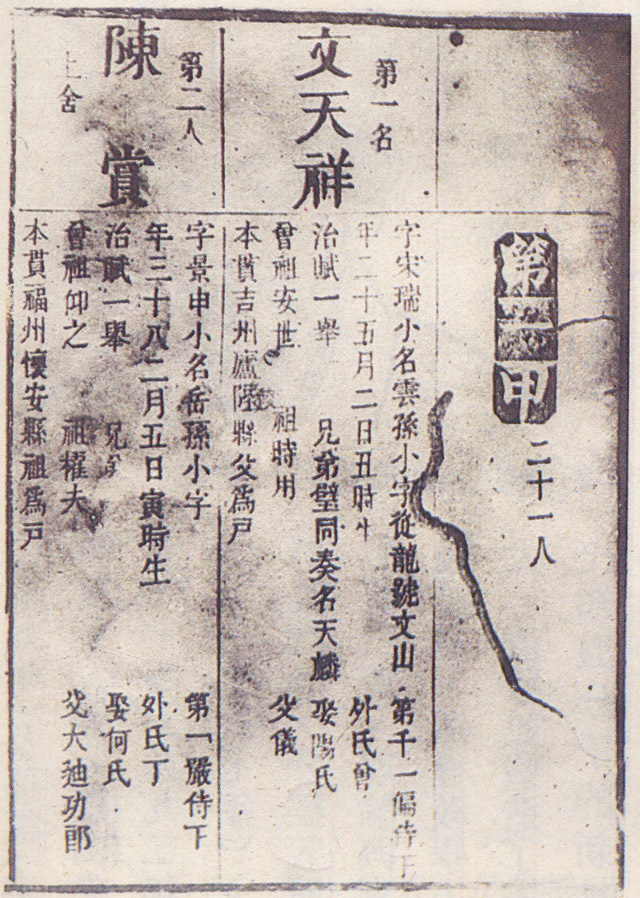 Ranking list of the *jinshi* examination
Ranking list of the *jinshi* examinationDunqing had four sons, of which the eldest was named Lishi (also known as Zhang Shao). We can say with reasonable certainty that one of the proudest moments in Dunqing’s life came when he heard the news that his son Lishi had achieved the first rank in the highest possible round of the Imperial Examinations, earning Lishi the prestigious title of Zhuangyuan.
Over the course of the Tang dynasty, the Imperial Examination system had developed into a more rigorous and more comprehensive system, moving beyond the former basic selection process of testing candidates on questions on policy matters followed by an interview.
By the time Lishi was taking the Examinations, the system had added written tests on mathematics, law, and calligraphy, exercises where candidates were given random sections of the Confucian classics with blanks that had to be filled in, and candidates had to compose original poetry on the spot, with very specific requirements.
The Examinations had different levels and different rounds. The highest possible round of the Examinations was the jinshi round. The success rate for candidates that participated in this ultimate round was only between one and two percent. Over the course of the Tang dynasty, an average of only about 23 jinshi degrees were awarded each year, for the entire empire. For of each jinshi round, the one candidate with the very best score would obtain the title of Zhuangyuan.
Imagine the look on Dunqing’s face when he learned that his son was a Zhuangyuan! Later, Lishi became a tutor at the Imperial Palace, personally responsible for educating members of the Royal Household.
Late 8th Century: Start of the Zhujixiang, Nanxiong Chapter
Zhang Gang: Your First Ancestor in Zhujixiang, Nanxiong
Zhang Dunqing had three other sons, of whom he had every reason to be proud of too.
His second son, your great (x43) grandfather Zhang Gang, was also known as Zhang Liying. Liying became provincial governor of Jizhou (today’s Ji’an City in Jiangxi province). Liying is of interest for your family history as he was the first one to settle in what was later called Zhujixiang, Nanxiong, Guangdong province. Nanxiong is in the far northern region of Guangdong, at the border with Jiangxi province; Nanxiong is also next to Shaozhou, the area where Zhang Gang’s preceding seven generations lived and your ancestor Zhang Junzheng had settled.
Dunqing’s third son Zhang Hai, a.k.a. Lihua, worked as Gongbu Shangshu or Minister of the Board of Works. The fourth son, Zhang Ji or Liwen was as provincial commander-in-chief of Zhejiang.15
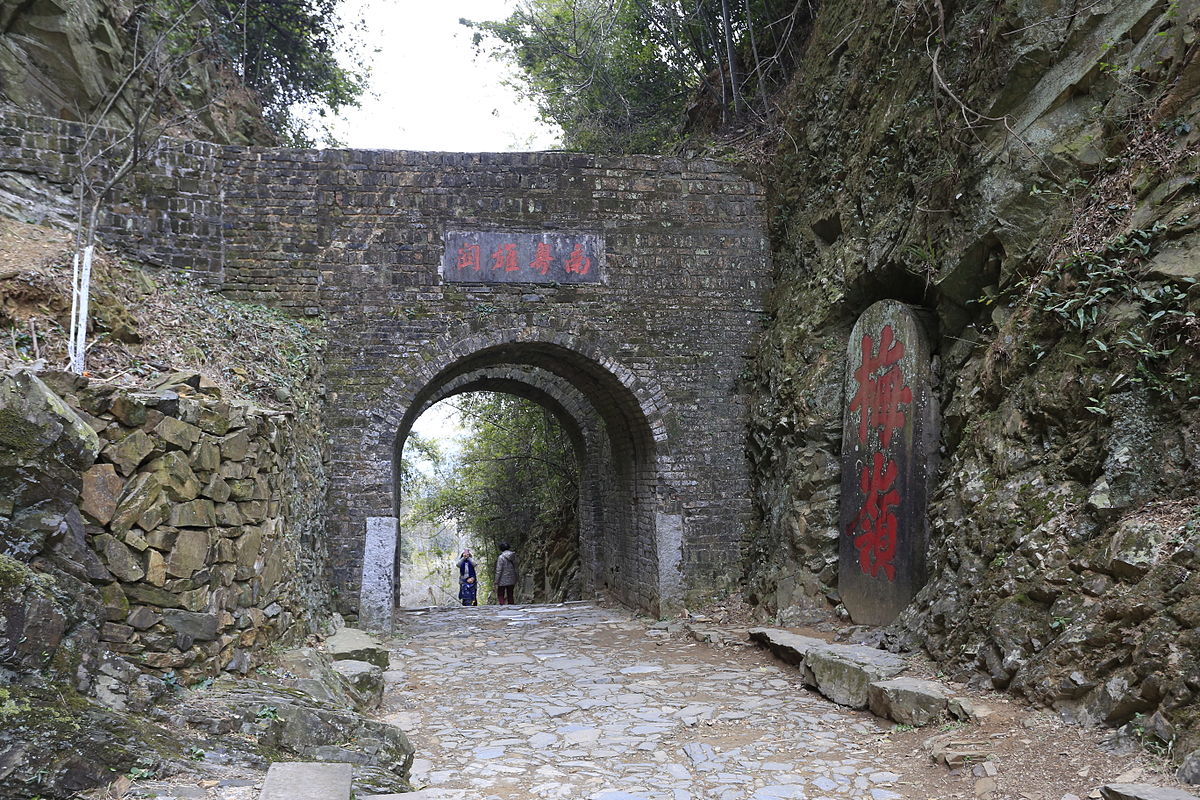 Lined with plum trees, the ancient Plum Pass (Meiguan) in Zhujixiang served as the only northern migration route out of Guangdong province.
Lined with plum trees, the ancient Plum Pass (Meiguan) in Zhujixiang served as the only northern migration route out of Guangdong province.Zhang Dai
Zhang Gang had only one son and his name was Zhang Dai. Dai was born roughly half way into the 8th century, and worked at the Palace Secretariat, one of the main ministries of the Imperial government.
The key responsibility of the Palace Secretariat was to read incoming memorials to the Emperor, to answer his questions, and to draft his replies in the form of Imperial Edicts. It also was tasked to ask critical questions in cases that were difficult for the Emperor to decide. The Secretarial administration supervised the transfer of documents inside the palace and the summoning of state officials to be interviewed.16
Dai married Ms. Zhong, and they had two sons: the eldest was named Yan and the youngest Xing.
Zhang Xing
The second son Zhang Xing obtained the title of Chaojie Qing Dafu, which carried the fifth official rank (out of nine) in the Tang Dynasty government hierarchy. In ancient China, “Dafu”, often translated as “grand master”, were leading, powerful administrators, high up the Imperial hierarchy. However, during much of the Tang Dynasty, the title had become less functional and it did not seem to have given Zhang Dai any specific role or sphere of influence. On the other hand, this did not mean that titles had become merely symbolic: they secured a salary, as well as taxation and retirement benefits. Moreover, Chaojie Qing Dafu were allowed to see the Emperor in the autumn.17
Zhang Xing married Ms. Zhou, and they had one son, named Zhang Zhe, the first ancestor that is listed in your Longgangli Zhang Clan zupu.
The Jiupin Ranking System of China’s Bureaucracy
There were nine key levels that applied to the ranking of government officials and titles. If a man had both a position and a title, it was not necessarily the case that they were of the same rank.
Except for the very highest rank (rank 1), all ranks had sub-divisions. Ranks 2 and 3 both had 2 sub-levels, while ranks 4 to 9 all have 4 sub-levels. This meant that in total there were 29 sub-levels divided over 9 ranks.
For instance with respect to positions: a judicial officer at the county level was rank nine; the county magistrate was rank seven; and the prime minister and key ministers were at the very highest level, one.
Titles, Degrees, and Government Positions
There were titles (Chaoqing Dafu, Wenlinlang, Dengshilang etc.), academic degrees and designations (e.g. jinshi, tanhua), and government positions (e.g. governor, jiedushi, prime minister).
While theoretically, there was a link between these three concepts, in practice, they often functioned independently from one another. Most men with government positions also had titles, especially those with mid-to-higher level positions, and the majority of men with government positions had an academic degree.
On the other hand, there were countless men with titles (honorary titles, hereditary titles) who did not have a government position or academic degree. Titles could be awarded for a wide variety of reasons: some had titles because their father had a title, others received a title after obtaining a government position; some were awarded titles for exemplary contributions to society, others simply bought their titles. Judging from a title itself, it was not possible to see whether that person also held a government position or an academic degree.
Starting with the Tang Dynasty (618-907), the importance of the aristocracy in government began to decline, a process that continued into the Song Dynasty. This process was directly linked to the increasing importance of the Imperial Exams during these same two dynasties, which aimed to make the government system more meritocratic.
However, up until the Ming Dynasty (1368-1644), titles remained crucial, as salaries and benefits such as retirement and taxation arrangements were based on title rather than position. Only from the Ming Dynasty onwards, benefits and salaries were based on positions.
9th Century (1st Half), Zhang Zhe: Common Ancestor of Three Clans
Zhang Zhe is the very first and earliest ancestor listed in your Longgangli Zhang Clan zupu.18 He is honored as the common ancestor of three related Kaiping Zhang Clan branches. These three branches are based in today’s Longgangli, Wapiankeng and Chakeng, and are referred to as the Shafu, Zhangqiao, and Shagang Zhang Clan branches.19
Your great (x40) grandfather Zhang Zhe was born around 770-780 and lived in Jingzong in Nanxiong, Guangdong. His courtesy name was Huayao.20
The Tang Dynasty was still in the process of picking itself up from the ground and dusting off the dark grey ashes from the An Lushan Rebellion. Throughout his childhood, Zhang Zhe would have seen the Tang struggle to regain its reputation and influence.
Backdrop: The Jiedushi vs. the Emperor
However, the strong central Tang control from the olden days had gone, and regional military governors known as Jiedushi21 were now largely the ones with power on the ground. The Jiedushi pretty much acted like rulers of their own independent states: they paid no taxes, named their own subordinates, and passed power to their own heirs.
In 805, three years before Zhang Zhe was to take the notorious Imperial Exams, he saw the last great ambitious Tang emperor come to power: Emperor Xianzong of Tang. Emperor Xianzong made it his mission to curb the powers of the jiedushi, and after several campaigns in Sichuan and Shaanxi to defeat those that did not obey him, he brought the whole Empire back under imperial authority. This period was also known as the Yuanhe Restoration.
Zhang Zhe’s Career
After being awarded a Jinshi in 808, Zhang Zhe was soon after promoted to the Palace Secretariat, where his grandfather Zhang Dai had worked before him. As a Secretary, Zhang Zhe would have handled many court documents relevant to the empire, likely including documents pertaining to Xianzong’s many military campaigns across the Empire. Zhang Zhe may also have contributed to the drafting of Imperial Edicts.
After the Palace Secretariat, Zhang Zhe served as Investigating Censor, whose duty was to check on all officials across the Empire and to inspect the various provinces, prefectures and districts. As an Investigating Censor, Zhang Zhe may also have managed issues related to punishment and jail time within his jurisdiction.
Of interest was that Zhang Zhe’s posting as Investigating Censor was in Fanyang (Beijing, Baoding and Tianjin).22 It is unclear whether Zhang Zhe knew that his own great (x8) grandfather Zhang Junzheng had also lived there, before the latter settled in the south and became the first ancestor in Guangdong.
Zhang Zhe’s Retirement and Resting Place
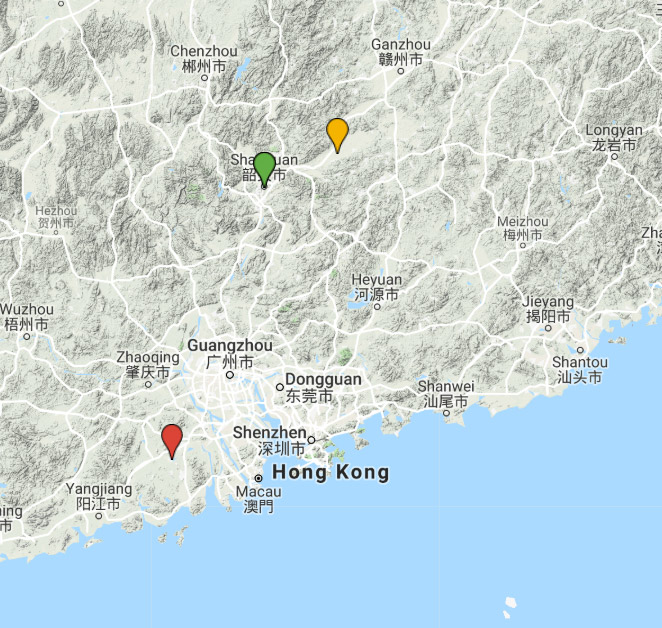 Kaiping (red), Shaoguan (green), Nanxiong (yellow)
Kaiping (red), Shaoguan (green), Nanxiong (yellow)Keeping the ancestral base in Jingzong, Nanxiong, in northern Guangdong, where his great-grandfather Zhang Gang had settled, Zhang Zhe moved to a different village, called Shashuitou Village, Jingzong Li, Shixing County, Nanxiong.23
Near the end of his life, Zhang Zhe was awarded the honorary title of Jishizhong, of the fifth rank, for his loyalty and service to the emperor. Zhang Zhe and his wife were buried together on Jinji Mountain, Wengyuan County, Shaozhou (today's Shaoguan, Guangdong Province).24
China’s Shakespeare’s Niece
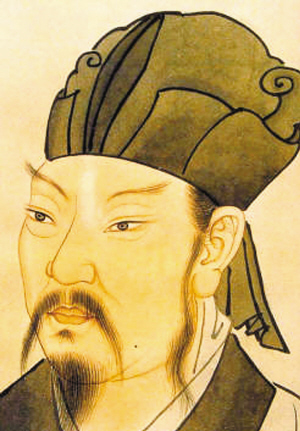 The poet Han Yu
The poet Han YuZhang Zhe’s wife was the niece of Han Yu / 韩愈 (768–824), a famous writer, poet and government official. Also known as China’s Shakespeare, Dante, or Goethe, it is probable that the renowned poet and your ancestor met in the capital, when they were both serving as government officials.
Incidentally, Han Yu was a puritan Confucian staunchly opposed to official patronage of Buddhism. He was also famously outspoken, so when Emperor Xianzong accompanied what was alleged to be Gautama Buddha’s finger bone from a temple in Shaanxi to the imperial palace in grand pomp and circumstance, Han Yu vehemently spoke out against it. When he was exiled to Chaozhou, he wrote the most exquisite lines of poetry.
《晚春》
草木知春不久归, 百般红紫斗芳菲。 杨花榆荚无才思, 惟解漫天作雪飞。
Late Spring
The plants know that spring will soon return, All sorts of reds and purples compete in beauty. The poplar blossoms and elm seeds are without beauty, They can only fill the skies with flight like snowflakes.
Zhang Xing's New Name for Jingzong: Zhujixiang
Zhang Xing was Zhang Zhe’s only son and was born around the turn of the 9th century. At some point in the early 800s, perhaps while Zhang Zhe was occupied with government affairs in the north, Xing moved nearby Jiaoyi Gate on Jingzong alley in Nanxiong. For the seven generations that followed, his descendants and their families would call this place ‘home’.25
In 825, Emperor Jingzong of the Tang Dynasty heard of Xing’s impeccable morals and filial piety. To reward him, he gave him a ring made of pearls and precious stones.
Incidentally, the name of the alley they had been living on, ‘Jingzong’, was identical to the emperor’s name. To avoid the naming taboo that strictly forbade individuals from using the emperor’s given name, they changed the name to Zhujixiang or Zhuji Alley, literally ‘pearl jewel alley’.26
9th Century (2nd Half): Declining Tang Signals Upcoming Change
Tang Decline Picks Up Where It Left Off
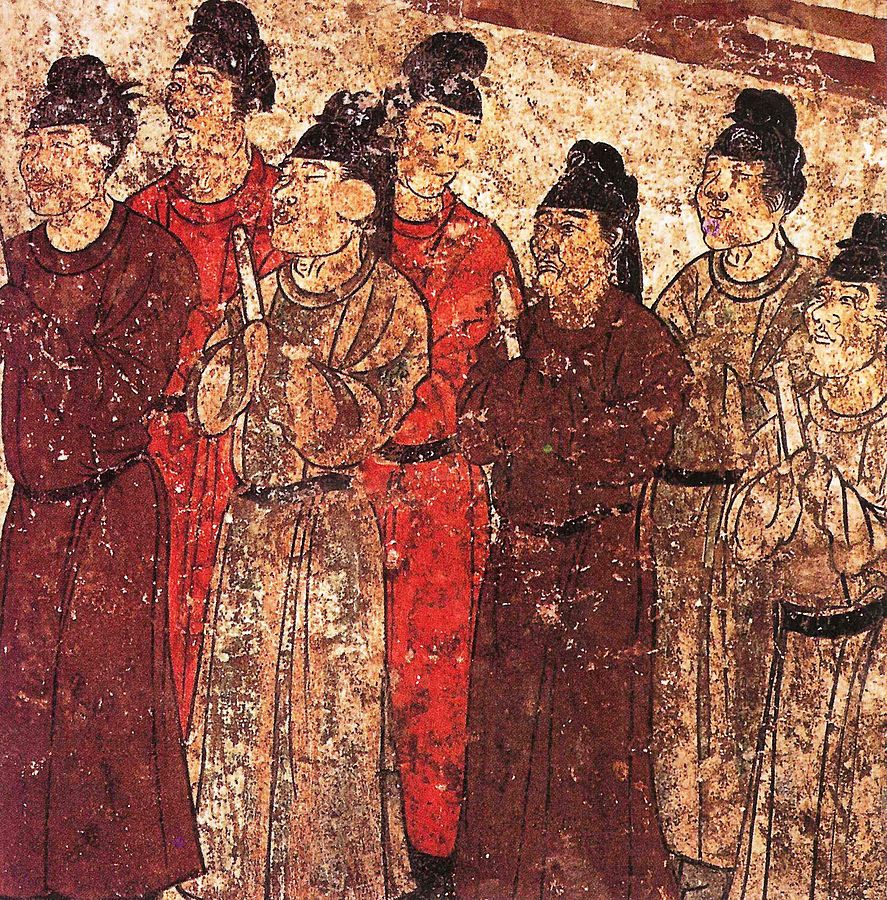 Mural of eunuchs from a royal tomb in Qianling, Shaanxi
Mural of eunuchs from a royal tomb in Qianling, ShaanxiUnfortunately, after Emperor Xianzong managed to briefly re-establish and stabilize Tang rule over the whole empire, his successors proved less capable, and the Tang decline that had started in the second half of the 8th century continued. The Imperial Court put the palace eunuchs in charge of the palace army, which had been created to counter the eventual threat of mutinous regional commanders. Before long, the eunuchs took control of palace affairs, and court politics in the 820s revolved around plotting the enthroning, murdering or coercing of one emperor after the next.
Zhang Xing will have started to reach middle age when in 835, a bloodbath occurred up north in the West Market in the Tang capital of Chang’an. The Jingzong Emperor’s successor, his younger brother Wenzong, had attempted to overthrow several key eunuchs. Wenzong’s plot was discovered and in retaliation, the eunuchs ordered the immediate and public execution of 1000 officials and allies to the emperor.27
Meanwhile, there were external pressures on the Tang’s borders. In 848, military general Zhang Yichao 28 took advantage of the Tibetan empire’s civil war to take it over. The Turkic Uighurs, on the other hand, had helped quash the An Lushan rebellion but demanded huge quantities of silk in exchange, or they threatened to raid the capital of Luoyang. Already struggling to maintain control of their current territories, the Tang decided not to attempt the recovery of their past territories of Central Asia.
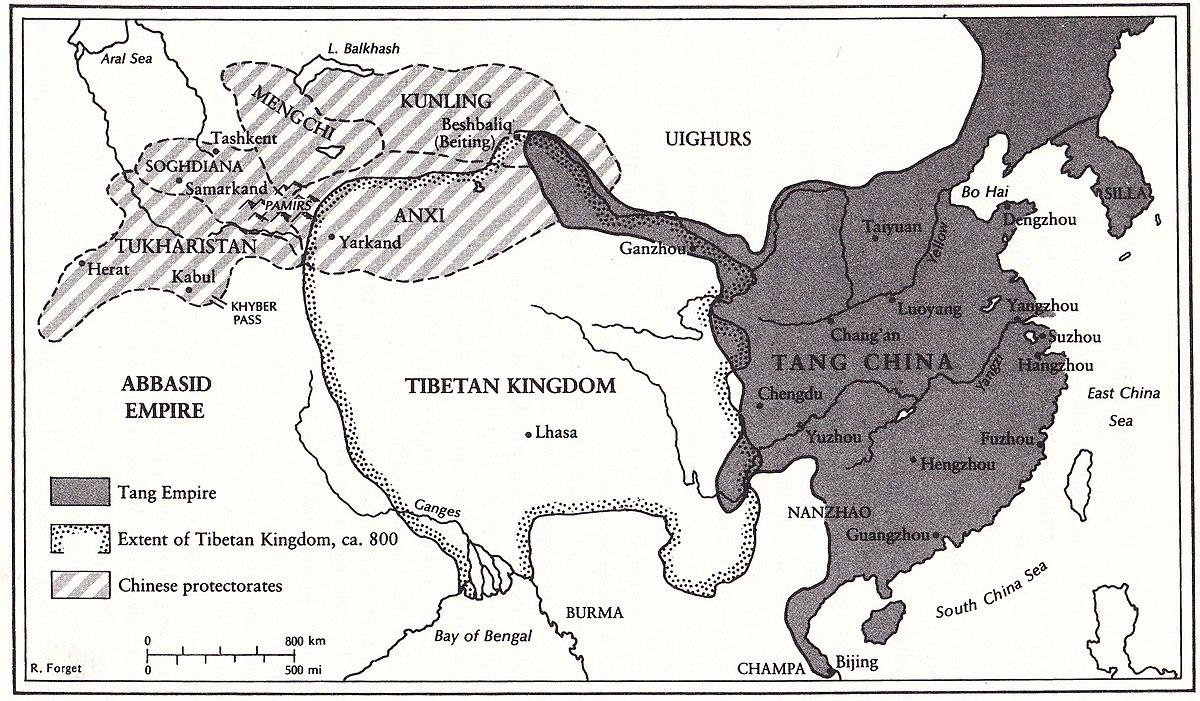 The Tang empire and surrounding kingdoms, ca. 800 A.D.
The Tang empire and surrounding kingdoms, ca. 800 A.D.Zhang Tingze and Zhang Ku: A Final Straw, the Huang Chao Rebellion
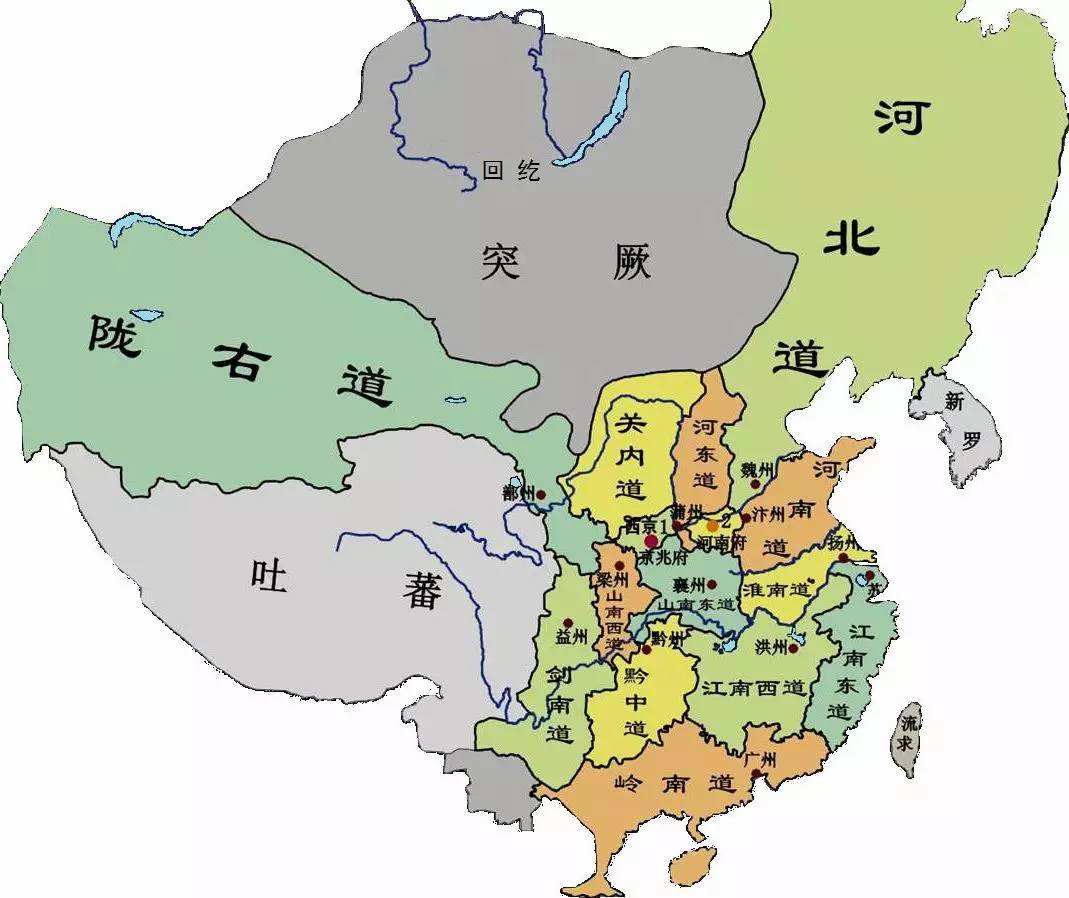 Map of the Lingnan circuit and other administrative regions of the Tang Dynasty
Map of the Lingnan circuit and other administrative regions of the Tang DynastyA decade or so later, Zhang Xing’s great-grandson and your great (x36) grandfather Zhang Tingze was born in Nanxiong, Guangdong, followed by his brothers Tingfan and Tingyan.29
After the An Lushan Rebellion, the weakened Tang Empire remained plagued by internal uprisings. The one that led to the eventual Tang disintegration was started by a well-educated salt smuggler, who gave his name to the uprising: the Huang Chao Rebellion (874–884). Following a series of droughts, floods and famine, Huang Chao raised an army against Tang Emperor Xizong.
Back in Nanxiong, Guangdong, in the middle of the rebellion, in 877, Zhang Tingze’s only son was born. His son was named Zhang Ku. The next year, in 878, Huang Chao marched all the way south to Lingnan and laid siege to the circuit’s capital Guangzhou, some 300 km south of Nanxiong, where Zhang Tingze and Zhang Ku were living. Three years later, Huang Chao captured the Tang capital of Chang’an in 881 A.D., proclaiming himself Emperor of the new Kingdom of Qi.
Shortly after, Huang Chao was killed by his nephew, ending Huang’s kingdom in 884 A.D. Nominally, the Tang were still in power.
Lingnan / Nanyue
During the Tang dynasty, the empire was divided into circuits / 道, or provinces. Lingnan circuit in the south encompassed all of Guangdong province, Fujian province, Hainan island, Guangxi province, the southeast of Yunnan province, and the northern section of Vietnam. Lingnan circuit’s capital was Guangzhou.
The Lingnang name means literally “south of the Ling Mountains”, a major mountain range straddling Guangxi, Guangdong and Hunan. However, this entire area used to be known as “Nanyue” / 南越, an ancient kingdom established in 204 B.C. and vassal state to the Han dynasty (206 B.C.–220 A.D.). Although founded by leaders from the Chinese heartland, the inhabitants of Nanyue were mostly non-Chinese Yue hill tribes, who were eventually assimilated into the Chinese empire.
The name "Vietnam" is derived from Nam Việt, the Vietnamese pronunciation of Nanyue.
Zhang Ku Orphaned and Raised By Uncle Zhang Tingfan
By the time the Huang Chao Rebellion had officially ended, Zhang Ku was seven years old, and his father Zhang Tingze had likely already passed away.30 Fortunately for the orphaned, brother-less Zhang Ku, his uncle Zhang Tingfan brought him in and took him under his wings.
Zhang Tingfan was a high level official, serving the Tang Emperor as a Yuyingshi, a military Commissioner of the Imperial Encampment, in charge of troops when an emperor personally undertook military campaigns.31
In 905, Tingfan switched positions and was appointed a senior role at the Changpingsi of the Stabilization Fund Bureau of Lingnan Circuit:32 a position of the seventh official rank, which consisted primarily of supervising the local granary, building up grain reserves to stabilize grain prices and support undeveloped regions in cases of famine.
907 AD: The Tang Falls, Zhang Ku and Tingfan Flee to Szeyap
Leaving Zhujixiang: Southward to Szeyap
The Khitan Liao Empire (907-1125)
The Khitan were a nomadic people that ruled a vast territory encompassing parts of modern-day Mongolia, Northern China, Russia, and Northern Korea. Founded around the collapse of the Tang, the Liao Empire was for a long-time seen as the ever-powerful northern neighbour, and not even the Song were able to dislodge it from the area around Beijing. The Jurchens, a herding, farming, hunting people based in Manchuria, eventually toppled them in 1125.
Khitan’s cultural and government system was vastly different from that of the Chinese. The Khitan promoted a more egalitarian society, in which women could hunt, manage property, and hold military posts.
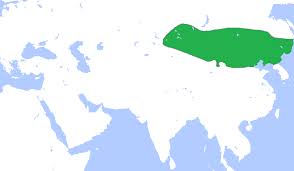 The Liao Dynasty, ca. 1000 A.D.
The Liao Dynasty, ca. 1000 A.D.However, two years later, the lives of Zhang Ku and his uncle Tingfan were turned upside down. In 907, after a long period of gradual decline, the inevitable happened: The Tang Dynasty had officially fallen.
Despite having technically defeated the Huang Chao Rebellion in 884, the Tang Dynasty was left severely weakened and vulnerable to attacks. Huang Chao’s defeat had been made possible thanks to a jiedushi called Zhu Wen, who initially served as a general in Huang Chao’s armies but later switched allegiance to the Tang. To reward him for his timely defection, Tang Emperor Xizong had appointed him Grand General of the Imperial Guards, and Zhu Wen subsequently led several campaigns against Huang Chao and his allies.
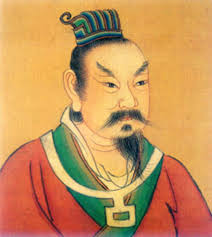 Emperor Zhu Wen of the Later Liang
Emperor Zhu Wen of the Later LiangHowever, following the end of the rebellion, Zhu Wen continued to amass power, and by 907, he had enough authority and mliilitary backing to storm the Imperial Court at Luoyang, where the last emperor of the Tang dynasty had taken refuge. Zhu Wen proclaimed himself Emperor of the Later Liang Dynasty (907-923) and ushered in the era of the Five Dynasties and Ten Kingdoms.
Back in Nanxiong, the official end of the Tang Dynasty meant problems for your Zhang ancestors, whose prominent position in society was heavily linked to the Tang rulers. Zhang Ku, by then 30 years of age, and his uncle Tingfan saw no other option than to flee to a place further south and further removed from the new power center in the north. They decided to move to Jinzixiang Hanwuqiao in Gugangzhou, today’s Xinhui County in Szeyap, Guangdong province.33
The Nanxiong–Zhujixiang Legend
Today, countless of Guangdong clans claim that their ancestry came from Nanxiong before settling down in Guangdong’s heartland or coastal regions. The origins of this claim is one of the most famous legends in Cantonese tradition. This tale of Zhujixiang clans spreading across Guangdong takes place around the end of the Song dynasty, some 2.5 centuries after your own ancestor Zhang Ku fled Zhujixiang with his uncle Zhang Tingfan.
It was likely in the year 1273, that an imperial concubine named Su fled the Imperial Palace after having incurred the wrath of the Emperor. She met a wealthy merchant, who fell in love with her beauty and took her back with him to his home in Nanxiong in northern Guangdong.
When the emperor discovered the concubine's absence, he ordered an empire-wide search for her. A disgruntled former servant of the merchant informed the authorities of the concubine’s whereabouts and military troops were dispatched to not only kill the concubine, but all of the local Nanxiong population.
News of the approaching military went like shockwaves through Nanxiong and 97 family Zhujixiang families fled south settling in the then undeveloped Pearl River Delta, where their descendants still live today.
Some historians have argued that a more plausible explanation of the large population growth around the time of the Song-Yuan Dynasty transition is that the invading, northern Mongol armies caused a massive southward migration flow, and for all the refugees coming from the north, Nanxiong was the key hub to reach the safety of southern Guangdong’s heartland and coastal areas.
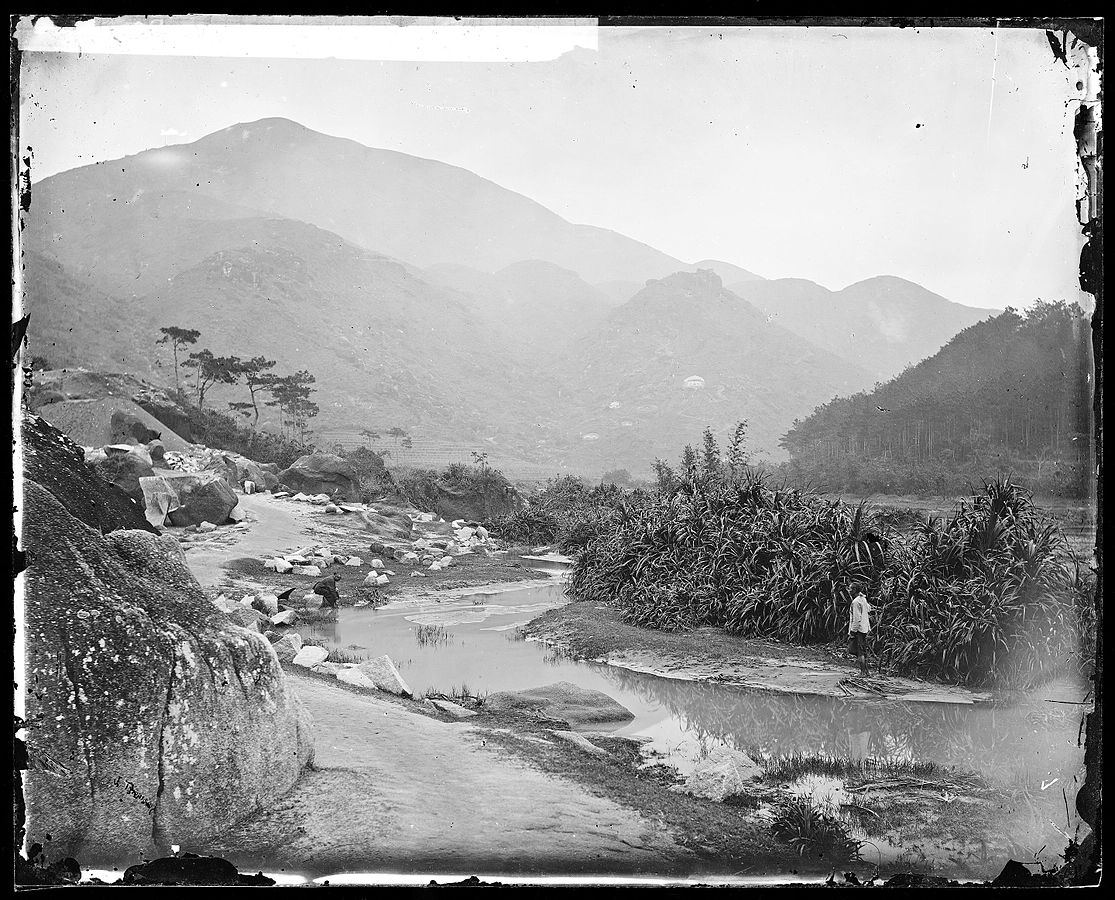 Pearl River, 1870
Pearl River, 1870Saving the Honor of the People of Gugangzhou
In 923, an agricultural tax collector called Gao Song arrived in Gugangzhou to collect 40,000 dan of grain for the state granaries in Nanxiong.34 Filling up the state granaries was regarded as a matter of priority for the government due to the regular occurrences of grain shortages and famine. However, in 923, the state of grain supplies in Gugangzhou was dire. As Tingfan was the government official responsible for building grain reserves in the area, he and Gao Song faced a predicament: the granaries were devised to keep the price of grain stable and to protect undeveloped regions from famine; but where were they to find grain from already starving citizens?
Zhang Tingfan and Gao Song knew well that famines and hunger had been the cause of many rebellions and uprisings throughout Chinese history. Even since the fall of the Tang, there had been repeated attacks in the countryside by groups of bandits the size of small armies; villages were pillaged and peasants suffered from hunger and poverty. The risk of rural rebellion was in the air.
Tingfan decided to see what he could do to help the people of his area pay the tax. He sent his nephew Zhang Ku to their ancestral home in Gugangzhou to convince their relatives to donate some of their wealth to the cause. At the age of 46, Ku was married to the daughter of a county magistrate, and his youngest son, your great (x34) grandfather Zhang Chang, was a four year-old toddler. Ku discussed at length with his wider family, and they agreed to donate 360 liang or taels35 of gold from Ku’s grandmother’s dowry, 800 liang of silver, and 20,000 dan of grain from their own reserves to the national granary, out of pocket.36
The Imperial Government was grateful as Zhang Tingfan and Zhang Ku prevented a potential uprising. The people of Gugangzhou were grateful as a large debt with possible penalties was avoided, and they paid your ancestors back gradually. Tingfan and Ku each received 25 thousand dan of grain. The following year, Ku bought another 5000 dan of grain in reserves, which he split equally among his three sons.
Zhang Tingfan Dies
Some 14 years later, in 937, Tingfan died in Gugangzhou. Zhang Ku, himself at the ripe age of 60 at the time, mourned Tingfan like a father. Because his uncle did not have any biological children to inherit Tingfan’s assets, half of his considerable land went to Zhang Ku, and the other half to Tingfan’s successor at the Changpingsi (i.e. the local department in charge of grain reserves; the second half thus went to the government).
Three Sons of Zhang Ku: The Start of Three New Zhang Clan Branches
Zhang Ku died at the old age of 85 in 961 AD, leaving three sons and considerable riches.
The revenue derived from the land inherited by Zhang Ku from Tingfan, combined with the income from new land that Zhang Ku had purchased in Guangzhou, ensured the continued wealth and prominence of your Zhang family in Szeyap. Thanks to the family’s riches, and especially thanks to the military achievements of their great-uncle Yanze in fighting the Khitan Liaos, Zhang Ku’s three sons were all granted honorary titles. Moreover, all three branched out to start their own Zhang sub-clans.
The eldest son, Zhang Rong, obtained the honorary title of Chaolie Dafu,37 which means “Grand Master for Court Audiences.” In a clear sign of the close friendship between the Zhang family and the agricultural tax collector Gao Song, whom Tingfan and Zhang Ku had helped raise grain for Gugangzhou, Zhang Rong married the daughter of Gao Song. They remained at Hanwu Bridge, in Xinhui County. His descendants would later be known as the Xianlang Longshui branch of the Zhang Clan.
Zhang Ku’s second son, Zhang Hua, obtained the honorary title of Chaoyi Dafu,38 which means “Grand Master for Rites.” He married Ms. Lu, the daughter of a certain Lu Wanzhuang. They moved to Luwuqiao in Xinxing (also called Zhangqiao, which much later was merged into Kaiping County). His descendants became known as the Zhang Clan Zhangqiao branch.
The third son was your ancestor Zhang Chang.
936, Zhang Chang: Founder of the Zhang Clan Shagang Branch
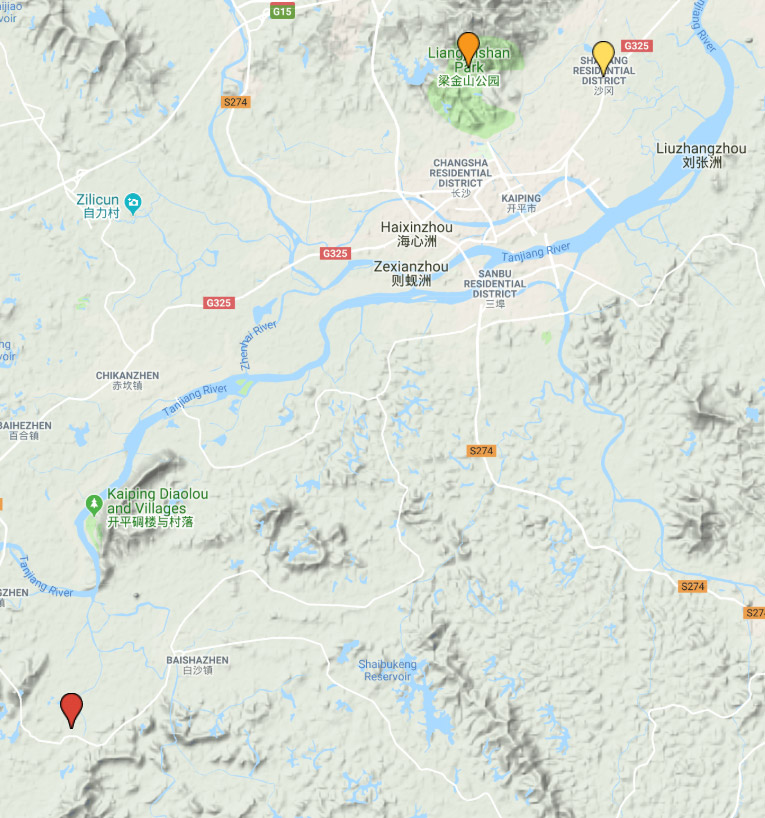 Liangjinshan (orange), Shagang (yellow), Longgangli (red)
Liangjinshan (orange), Shagang (yellow), Longgangli (red)Zhang Chang was born in 919 A.D.39 In 936, at the age of 17, he left the safety of his home in Gugangzhou. Like his middle brother Zhang Hua, Zhang Chang settled in another area of Szeyap, in a place that is part of Kaiping today.
Today, your great (x34) grandfather ancestor is still credited with the development of the area he settled in, which was called Shagang (today’s Shagang Residential District, Kaiping, Guangdong). When he arrived at Liangjin Mountain from Hanwu Bridge in Xinhui, the area was quite a sorry sight:40
“...At the time, there were only forests and grasslands for tens of miles around. People were worried about wild beasts during the night. Besides Zhang Chang and his family, there were only five other families: the Xu’s, the Chen’s, the Li’s, the Mo’s and the Lei’s. They could not have been more than thirty or forty people in total.”41
Establishing Yongleli Village
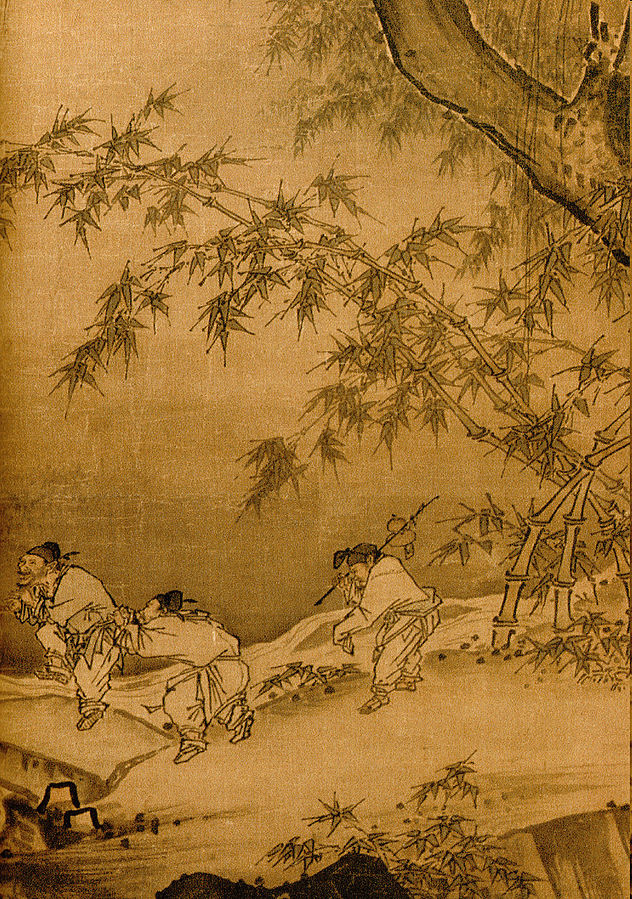 Peasants at work
Peasants at workZhang Chang did not waste any time. He settled on a plot of land 250 m away from the foot of Liangjin Mountain. He burnt down the forests, chasing out its beasts and poisonous snakes. He cleared up over a dozen hectares of land to grow rice and grazed sheep and cattle. He offered compensation to those that were willing to cultivate and plough the land. Before too long, the area turned into a bustling village. By the end of the year, the village had harvested several dan of grain. The village was named Yongleli.42
With the income made from selling their produce in Gangzhou (today’s Xinhui County) and Guangzhou, they bought basic household items, while the additional income was shared among their families.
Zhang Chang also set up a public welfare granary for surplus goods and produce, only to be called upon in extreme circumstances: when people fell ill and could no longer work or feed themselves, during famines, etc. In times of peace, he took it upon himself to educate the younger generations. As a result, many people of the surrounding areas moved to Shagang, with the population rising to over two thousand families.
After settling in Shagang, Zhang Chang married Ms. He, a daughter of He Bochuan, also from Yongleli. By the time his father died in 961, Zhang Chang was already 43 and a prominent government official himself. Largely due to the military achievements of his great-uncle Zhang Yanze, he obtained the honorary title Chaoqing Dafu,43 which means “adjunct grand master.”
Zhang Chang Dies, While A New Imperial Dynasty Is Born
The chaotic period of the Five Dynasties and Ten Kingdoms was eventually brought to a halt by a general named Zhao Kuangyin, or, as he became better known: Taizu, the first emperor of the Song Dynasty.
The Song Dynasty was a new dawn for China, with great advances in agriculture and industry. The civil service and imperial examinations came to dominate the lives of the elite, and the deterioration of central control that had taken place during the chaotic Five Dynasties and Ten Kingdoms period was translated into a revitalization of Confucianism and Imperial strength.
In 976, 16 years into the Song Dynasty, Zhang Chang passed away at the age of 57. At the time of his death, he had been leading the development of Shagang for forty years, transforming Shagang from a wilderness into the political and economic center of Yining County. With the county’s main market now located in Guzhou, Shagang,44 people in and around the area had nothing but respect for him, erecting a statue in his honor.
Shagang's Place in History
In 1982, a county-level archaeological survey team investigated the historical territory of Shagang. While the area of former Guzhou Village had turned into unremarkable village farmland, the local villagers were still able to tell stories from the collective memory about the “heyday” of Guzhou, when it was bustling with activity. Red bricks from the old city wall were found scattered around the area.
By the early Ming Dynasty, three new villages were thriving in the area. By the early Qing Dynasty, Shagang abounded in grain and garlic bulbs. A deep water wharf was constructed in Jinshan Village / 金山 村, opening the door to foreign trade. Shagang’s economy boomed as the famous roasted garlic from Jinshan was sold in America and Southeast Asia.
Though Shagang may not be your “closest” ancestral place, your great (x34) grandfather Zhang Chang pulled off a truly impressive feat by building a dynamic and prosperous region from the ground up.
 Garlic bulbs
Garlic bulbs1506, Ming Dynasty: Zhang Shiquan Arrives in Longgangli
The Ming Dynasty (1368-1644)
Fast-forward 530 years to the heart of the Ming Dynasty. The Ming had started in 1368 and marked the return to a Han Chinese dynasty, following the foreign Mongol-led Yuan Dynasty (1271-1368). It was a golden era for maritime expeditions, trade, and strict government control.
Zhang Shiquan: Humble Beginnings as a Duck Farmer in Longgangli
The year is 1506: the first year of Ming Dynasty Emperor Zhengde’s reign (1506–1521). The first person of your Zhang clan to arrive and settle in Longgang village was your great (x15) grandfather Zhang Shiquan.45 A native of Shagang, he and his brother Zhang Shitian, moved to Longgang in Chishui town. They settled on “Flying Goose Mountain” and ran a duck farm.46
During Shiquan’s life in the mid-Ming Dynasty, Guangdong experienced considerable economic and population growth. The production of silk and other textiles, sugar, and handicraft products greatly increased. Commercial activities accelerated as Guangzhou became the largest center of commerce in Guangdong and China's most important port for the international maritime trade. Guangdong merchants also transported the province's products to sell in other parts of China or abroad.
However, as the Han Chinese population in Guangdong increased, so did frictions with local, non-Han Chinese tribes. Around the time Shiquan moved to Longgang, imperial military campaigns to suppress tribal uprisings in Guangdong were not uncommon. Another form of increasing control was to restructure administrative jurisdictions and establish new counties with clear authority and reporting lines back to the Imperial Court. Two of today’s four Sze Yup counties – Enping and Taishan – were established around the period of Shiquan’s move (Kaiping was only established much later, in 1649).
Emperor Zhengde (1491-1521)
Often reputed to be reckless and foolish, known to indulge in women and neglect his duties, it was under his reign that China experienced first direct contact with Europeans, who started trading with Chinese merchants in southern China. Zhengde was fascinated by foreigners, and invited many Muslim envoys, advisors, and eunuchs at his court. Learn more.
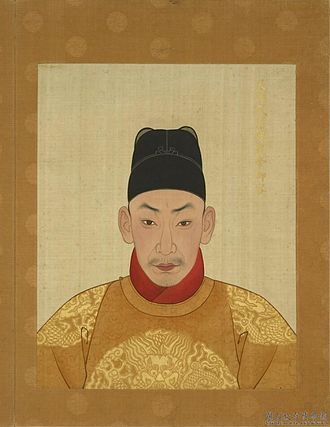
The Legend of Zhang Shiquan: The Accidental Official
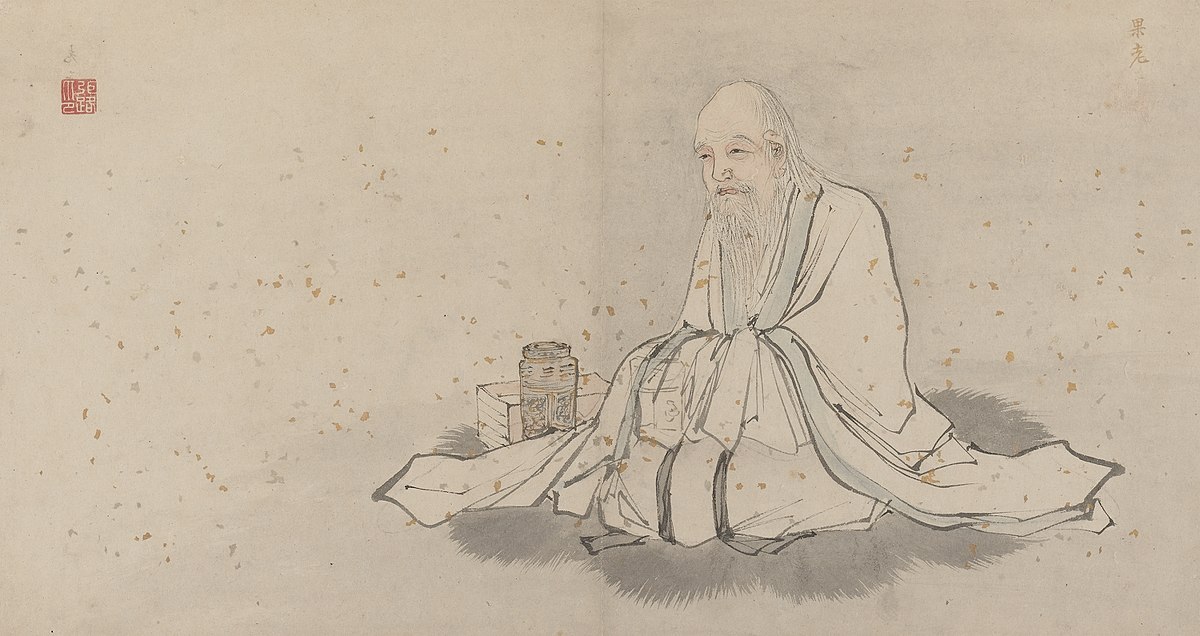 Fengshui master
Fengshui masterWe found several accounts relating how Zhang Shiquan supposedly went from duck farmer to official of the highest ranking.
According to an oral history interview conducted in 1987 with a local Zhang clan farmer in Wapiankeng, Zhang Shiquan was looking after his ducks on Mount Fei‘e when a fengshui master emerged from the woods, and asked him the way to Chikan. Seeing as it was already dark, Zhang Shiquan advised him to wait until the next day, offering him a bed and a hot meal in his humble abode.
That night, Zhang Shiquan killed a duck to welcome his guest. To thank him for his kindness, the fengshui master offered to advise him on the re-burying of any ancestors. At the time, the Zhang clan ancestors were buried in Shagang, about a day’s journey away. The fengshui master waited for Shiquan to collect his mother’s and his other ancestors’ bones, and when he returned, he laid them to rest atop Mount Fei’e beside the duck coop.
Early the next morning, as Shiquan was about to let his ducks out of their coop when he stepped on something hard and pointy that was lodged in the mud. He was astonished to find dozens of silver coins sticking out of the ground, so he hurriedly dug them out and brought them home. With his newfound wealth, Shiquan bought a large piece of land in Longgang.
The Prophecy
Up north, in the Ming capital of Beijing, Emperor Zhengde had just ascended the throne. He had heard of a prophecy that a new emperor would be born in a place called Jinji (literally “Golden Rooster”) in Kaiping. According to the prophecy, the new emperor’s birth would be announced by a pair of roosters crowing in Jinji.
Anxious about being overthrown so soon after coming to power, Zhengde sought the advice of a fengshui master. To prevent the prophecy from coming true, the master recommended building a trench leading to Jinji, and to bury a chain within it – symbolizing the enslavement of the roosters, and thus the annulment of the prophecy.
Zhengde sent an imperial envoy to complete this task. The envoy started from Qitou Mountain, and dug a trench that went across the five mountains of Shaomou, Wang, Wuzhi, Mojian, and Shichutou.47 However, when the imperial envoy’s project reached the borders of Chishui, the skies broke into a terrible rainstorm, and the armies’ provisions were ruined. The envoy saw that there was no way he could finish the project according to schedule, and felt extremely anxious.
Fengshui
Literally “wind-water” in English, fengshui is an ancient Chinese philosophical system focused on harmonizing people with their environments based on the observation of heavenly time and earthly space. The quality of fengshui was believed to have direct consequence on the quality of life, not just for an individual, but for the entire family or clan. Poor fengshui, for instance, could enrage the ancestral spirits and bring misfortune upon a family for generations to come.
Zhang Shiquan to the Rescue
He would have failed to complete his mission, if it hadn’t been for Zhang Shiquan, who provided his armies with three months’ worth of provisions.
To thank this benevolent man for his generosity, the emperor sent for Zhang Shiquan. However, upon receiving a summons to court, Zhang Shiquan believed that he had committed some sort of crime and that the emperor would punish him; at the same time, he knew that if he didn’t go, he would be killed all the same. His brother convinced him to obey the summons, and, resigned, he travelled to the capital.
Official
When Emperor Zhengde received him, he asked him what position he wished for in office. Shiquan replied he did not want to be an official, and that he wasn’t interested in money. The emperor still wanted to reward him somehow, so he asked him: “Every official corresponds to a certain rank in the Jiupin system. Which ranking do you desire?”
Shiquan did not know how the ranking system worked, and, mistakenly thinking it was the lowest, he “humbly” replied that he wished for the “first rank.” Thereupon, the emperor bestowed a set of first rank official robes upon him and his wife. Zhang thought the clothes were elegant, and so wore them on his journey home. Later, his descendants would paint a portrait of him and his wife cloaked in the robes, and built a temple in his honor. The large painting was then made to hang in the Zhang Shiquan ancestral temple for future generations to revere.
From Our Own Interviews in Longgangli...
When My China Roots visited Longgangli, our interviewees told a similar, though somewhat shorter story. In their version, Zhang Shiquan’s guest was not a fengshui master, but a government official. Moreover, they added that historically, every time an official envoy visited the village to collect grain taxes from farmers, no matter their rank, when they saw the painting of Zhang Shiquan in his official robes, they would bow down before his image. Not only that, but they would not dare enter the temple using the main entrance, and only used the side door to come and go.
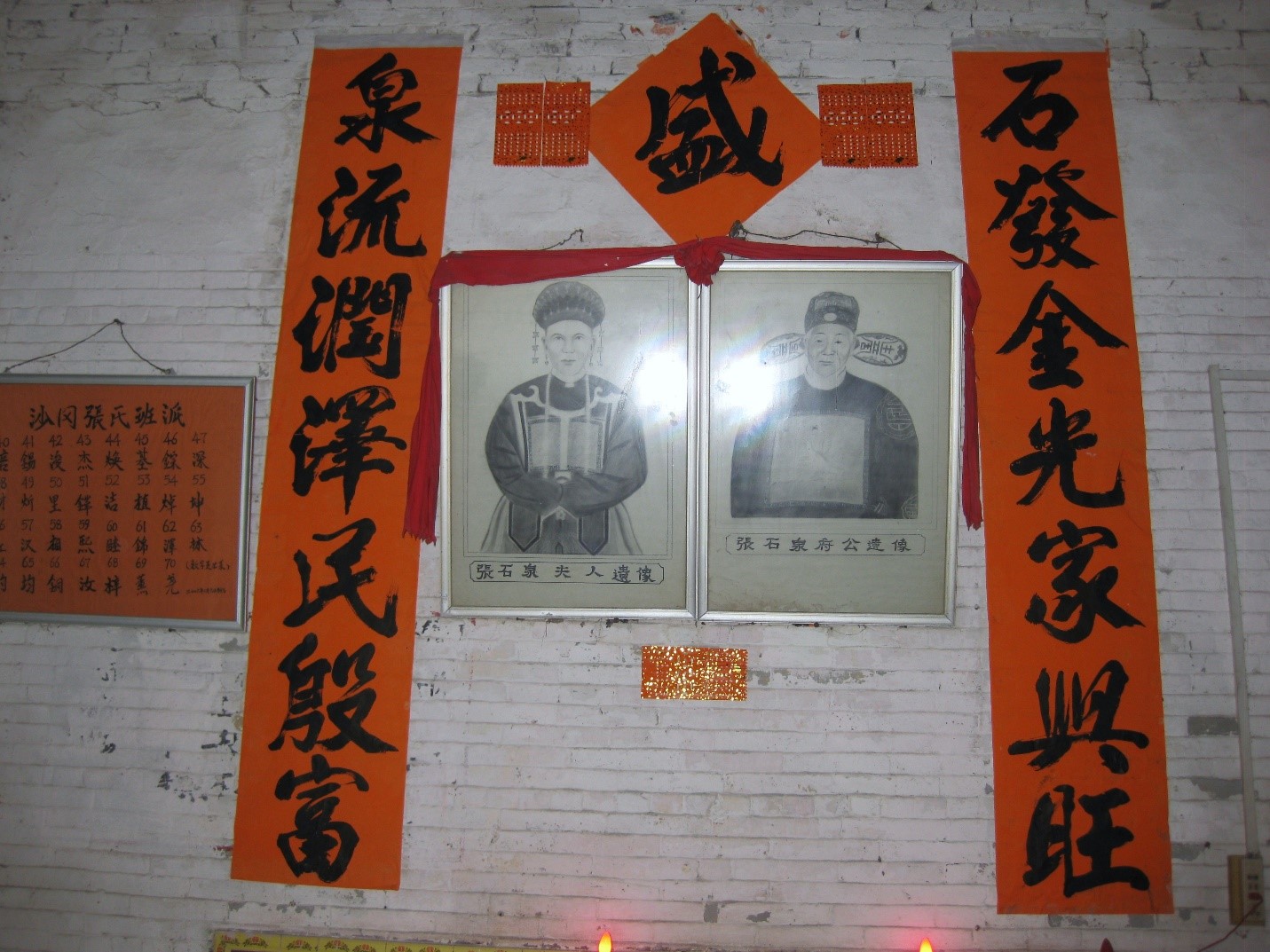 Zhang Shiquan (right) and his wife
Zhang Shiquan (right) and his wife1644-1681: Ming-Qing Transition Turmoil Reaches Kaiping
Zhang Penglong: Delayed Implementation of Dynastic change
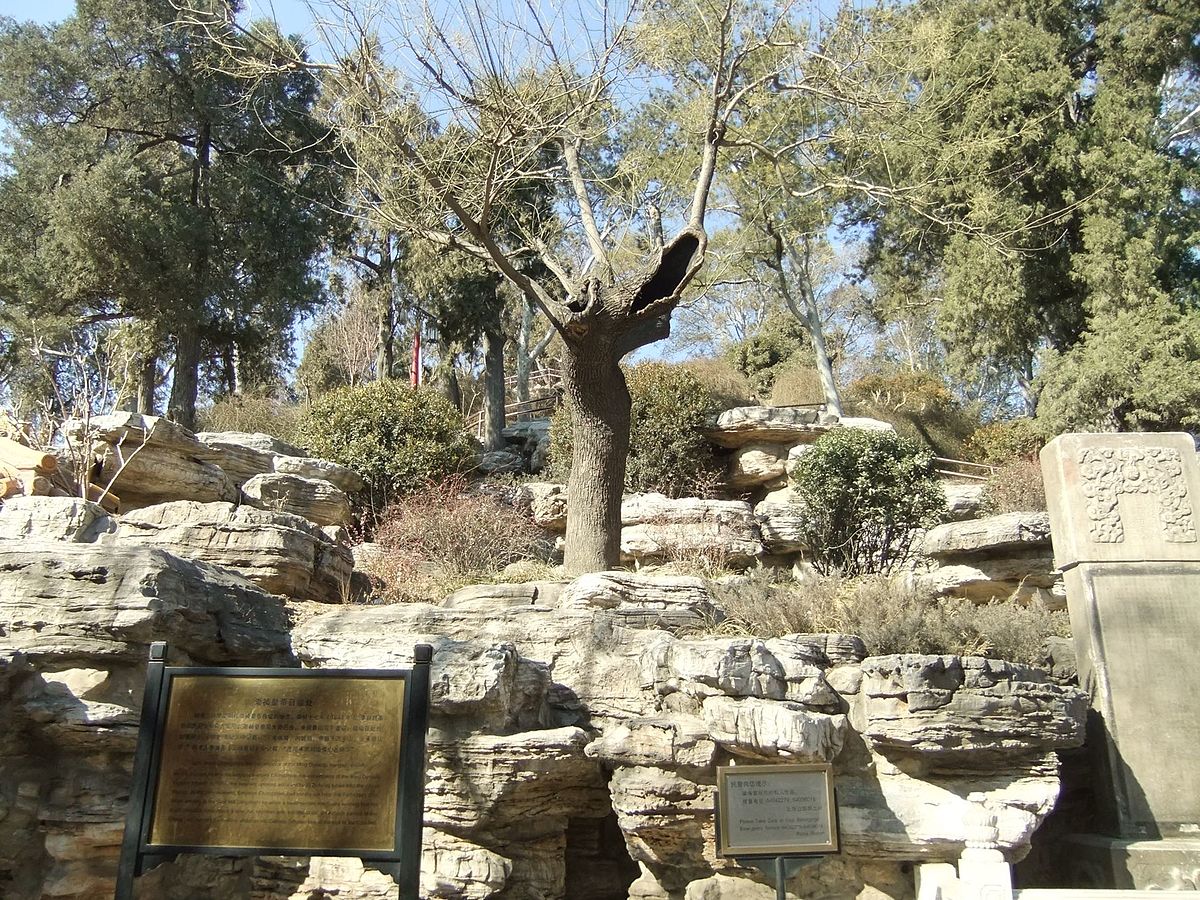 The tree where the last Ming emperor hung himself in today's Jingshan Park, Beijing
The tree where the last Ming emperor hung himself in today's Jingshan Park, BeijingFast forward yet another 100 years or so. The year is 1644; your great (x9) grandfather Zhang Penglong (born around 1640s) was possibly playing in the rice fields next to his home in Longgangli. In distant Beijing, the last Ming emperor hung himself from a tree next to the Forbidden City, capitulating to the invading peasant armies.
The Manchus, a tribal people from the north, seized this opportunity to move in and replace the Ming. In 1644, they proclaimed the start of the Qing Dynasty, with Beijing as its capital. It would take another forty years, however, for their conquest to be complete. Many Ming loyalists had fled to the south, garnering support for resisting the new foreign barbarian rulers.
In late 1646, a descendant of the founder of the fallen Ming Dynasty set up government in Guangzhou and crowned himself the Shaowu Emperor. Refusing to acknowledge the new Qing regime, he claimed to be the true ruler of all of Ming China. Interestingly and confusingly, that same month, in the same city, another Ming throne pretender proclaimed himself the Yongli Emperor. For two months, life in Guangdong was disrupted while the two pretenders fought each other, until the Qing army captured Guangzhou, killed Shaowu and sent Yongli fleeing across southern China.
Being a mere 120 km removed from Guangzhou, Zhang Penglong’s family will at the very least have heard about the Imperial turmoil, when they were visiting the local market town or talking to fellow villagers in the fields.
Kaiping Under the Qing
1649 saw the official establishment of Kaiping county. In 1650, the Manchu general Shang Kexi took over Guangdong, and Kaiping County officially fell under Qing territory in 1651. The Qing inherited the Ming’s defence station system, responsible for ensuring the county’s military security. In the county capital of Kaiping, these included a chief officer, 3 lieutenants, and 300 soldiers. A small camp was set up in Chishui, your Zhang ancestors’ own market town, with one lieutenant and 50 soldiers.
The freak weather gave locals no respite, for in the two years that followed, the area was hit by massive floods. The fields were submerged with water, attracting all sorts of pests and insects. In 1653, locals suffered a great famine, and unless Zhang Penglong’s father Zhang Tingshu had access to reserves, your ancestors will also have gone hungry, if not worse.
It did not take long however, before Ming and Yongli Emperor-loyalists in the region staged a revolt against the new Qing rulers. The revolt took place only 40km from Zhang Penglong’s house in Longgangli. In July of 1654, a general loyal to the Ming called Li Dingguo laid siege to the Xinxing County capital (today’s Xinxing County, Yunfu City). Later, Li ordered the invasion of the Kaiping county capital. In December, the Qing sent General Juma Bayara and an army of elite military forces to attack Li Dingguo’s forces, resulting in the return of Kaiping under Qing rule.48
The Kaiping County Gazetteer
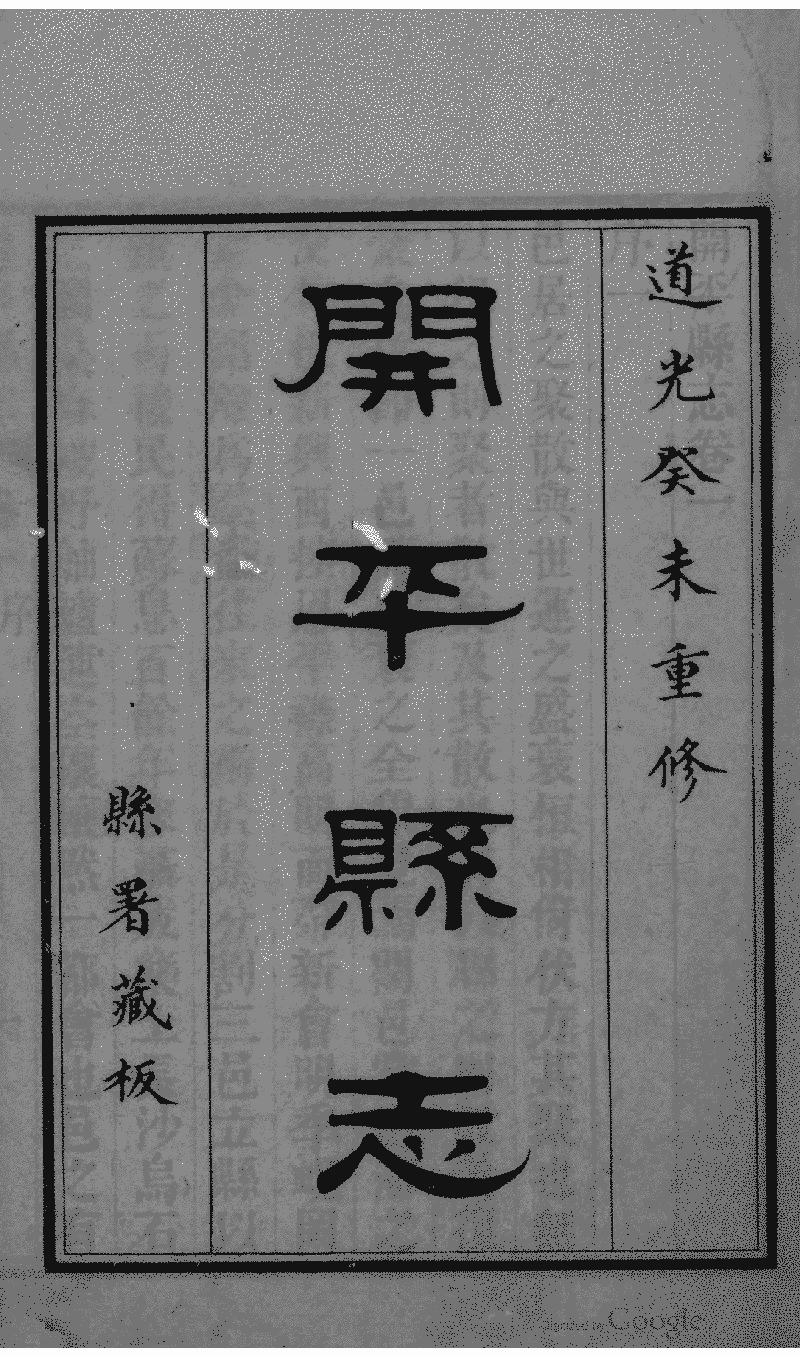 The Kaiping County Gazetteer
The Kaiping County GazetteerOne of the important historical sources for this report was the Kaiping County Gazetteer.
Local gazetteers in China are encyclopedias of specific places, drawn up by government and containing wide-ranging information on geographic, administrative, economic, and cultural features and changes. They typically also contain information about specific government officials, dignitaries, prominent clans and other issues of relevance for the area.
The Kaiping County Gazetteer started being maintained when Kaiping county was established in 1649. Your great (9) grandfather Zhang Penglong was growing up, and the Manchu armies of the fresh new, foreign Qing Dynasty were still fighting with southern Ming-loyalists.
Between 1649 and 1993 (when the administrative status of Kaiping was changed to a county-level city), the Gazetteer was updated nine times: seven times before, and twice after the founding of the People’s Republic in 1949. The updates in 1823 and 1932 were the most comprehensive. The 2002 update was undertaken by the local government’s Office of the Kaiping Gazetteer.
1662: Kangxi’s Great Clearance
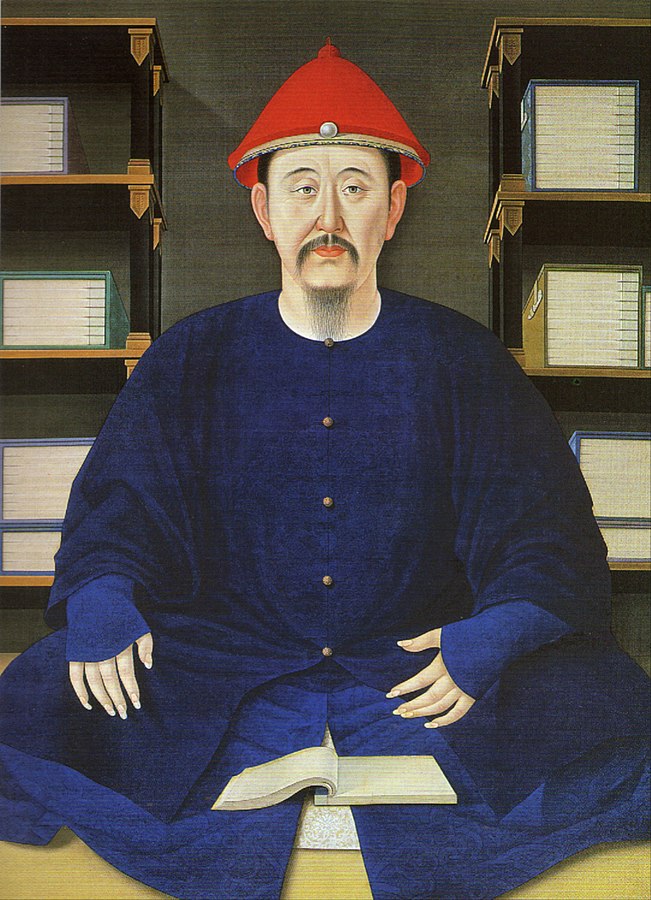 Kangxi Emperor
Kangxi EmperorIn 1662, the Qing Emperor Kangxi released an edict that would not only impact life in Kaiping for the next two decades, but would have an impact that would return to wreak havoc in the wider region two centuries later.
Following the final defeat of the Ming on the mainland, remnants of the Ming army led by Koxinga or Zheng Chenggong left for Taiwan and continued to attack the Mainland coast, while also trading with coastal residents. To break economic ties between them and the coastal mainlanders, Qing Emperor Kangxi ordered a major evacuation of the area. Along the coast, people were forced to leave their land and homes, and move at least 25 km land inward. Kangxi’s coastal clearance policy caused a major disruption to the economic and social life of China’s coast, and Guangdong was particularly affected.
Located around 40 km from the sea, Longgangli may not have been directly subjected to the evacuation order.49 Nevertheless, Zhang Tingshu and Zhang Penglong and their families would have seen caravans of distressed peasants and gentry alike, bringing their possessions and livestock to safety beyond the 25 km line.
1669: Lifting of the Clearance Order and Repopulating the Coast
In 1669, around the time Zhang Penglong’s son Zhang Yexu was born, the Kangxi Emperor officially lifted his evacuation order and started incentivizing both former coastal residents to return and new residents to move to the coast by giving them tax exemptions and free resources.
The process of re-populating the coast went slow, and by the time Yexu would have been a teenager, local counties were still calling for peasants to settle back on the coast.
With time however, the beneficial re-population policies were to draw hundreds of thousands of newcomers, especially Hakka. The frictions that would ensue between the returning indigenous population (“punti”) and the newly arriving Hakka people were to come to a bloody head some 180 years later. Little did Yexu know that that future conflict, known as the Hakka-Punti Clan Wars, was to be among the reasons why his great-great-great-great grandson Bein Yiu Chung would move overseas.
1662-1669: Freak Weather
As if the forced migration and re-population due to Kangxi’s Great Clearance Order did not pose enough hardship, extreme weather conditions made the homecoming even more brutal, with storms, hurricanes and hailstones “the size of bricks.”50 In fact, for almost every year between 1662 and 1669, Kaiping had been suffering earthquakes, droughts, pest infestations, famine, and as many as five typhoons in 1668 alone.
Natural Disasters in Kaiping that Impacted Longgangli, 1680-1804 (from the Kaiping Gazetteer)
| Year | Disaster |
|---|---|
| 1680 | August: Great drought |
| 1687 | April: Heavy rain |
| 1689 | March: Drought |
| 1690 | February–May: Heavy rain |
| 1691 | March–May: Drought, price of rice surges significantly |
| 1696 | April: Drought |
| 1702 | June: Hurricane |
| 1703 | June: Locust plague |
| 1706 | May: Heavy rain, nonstop for 6 days and nights |
| 1724 | Earthquake in Kaiping, which can be heard from afar |
| 1750 | August: Hurricane and storm |
| 1752 | September: Hurricane and storm, residential houses damaged |
| 1777 | Autumn: Drought |
| 1786 | Autumn: Drought |
| 1787 | Summer–Autumn: Drought |
| 1791 | April: Heavy rain, residential houses damaged |
| 1794 | February–April: Drought |
| 1804 | April: Heavy thunderstorms |
1673: Wu Sangui’s Troops Plunder Kaiping
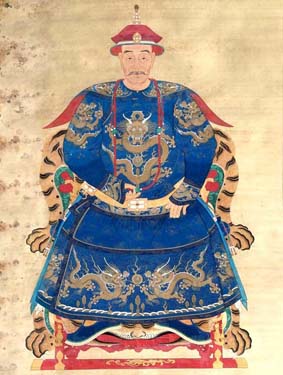 Wu Sangui
Wu SanguiIf by 1673, 29 years after having proclaimed their Qing Dynasty, the Manchu rulers thought they were solidly in their imperial saddles across the Empire, they were sadly mistaken.
Wu Sangui was a former Ming general, who had defected to the Manchus and helped the Qing quash Li Zicheng’s 1644 peasant rebellion and then lay siege to Beijing. In 1673, Wu started his own anti-Qing rebellion.
In 1676, his subordinate officer, Ma Xiong, entered Kaiping and his troops pillaged and looted wherever they went. Your ancestors Zhang Tingshu, Zhang Penglong and little Zhang Yexu will likely have lived in fear, and may even had to run or hide to avoid the marauding rebels. Fortunately, the troops eventually moved on from Kaiping, and Wu Sangui’s rebellion was quashed in 1681.
1757-1793: Setting the Scene for “The Zhang Clan Odyssey"
1757: Births of Zhang Huangpan and the Canton System
Around the time that your Zhang ancestors in Longgangli were celebrating the birth of your great (x5) grandfather Zhang Huangpan, some 2000 km to the north at the Imperial Court in Beijing, the Qianlong Emperor was making a decision that would somehow impact the lives of all Huangpan’s future descendants. In fact, the imperial decision was to impact China’s general relations with the outside world, up to the moment of writing this report.
In 1757, Emperor Qianlong started the “Canton System.” The aim of the policy was to limit foreign influence in China by tightly controlling China’s foreign trade, and so the Emperor ordered the closing of all of China’s harbors, leaving only the port of Guangzhou to allow for imports and exports.
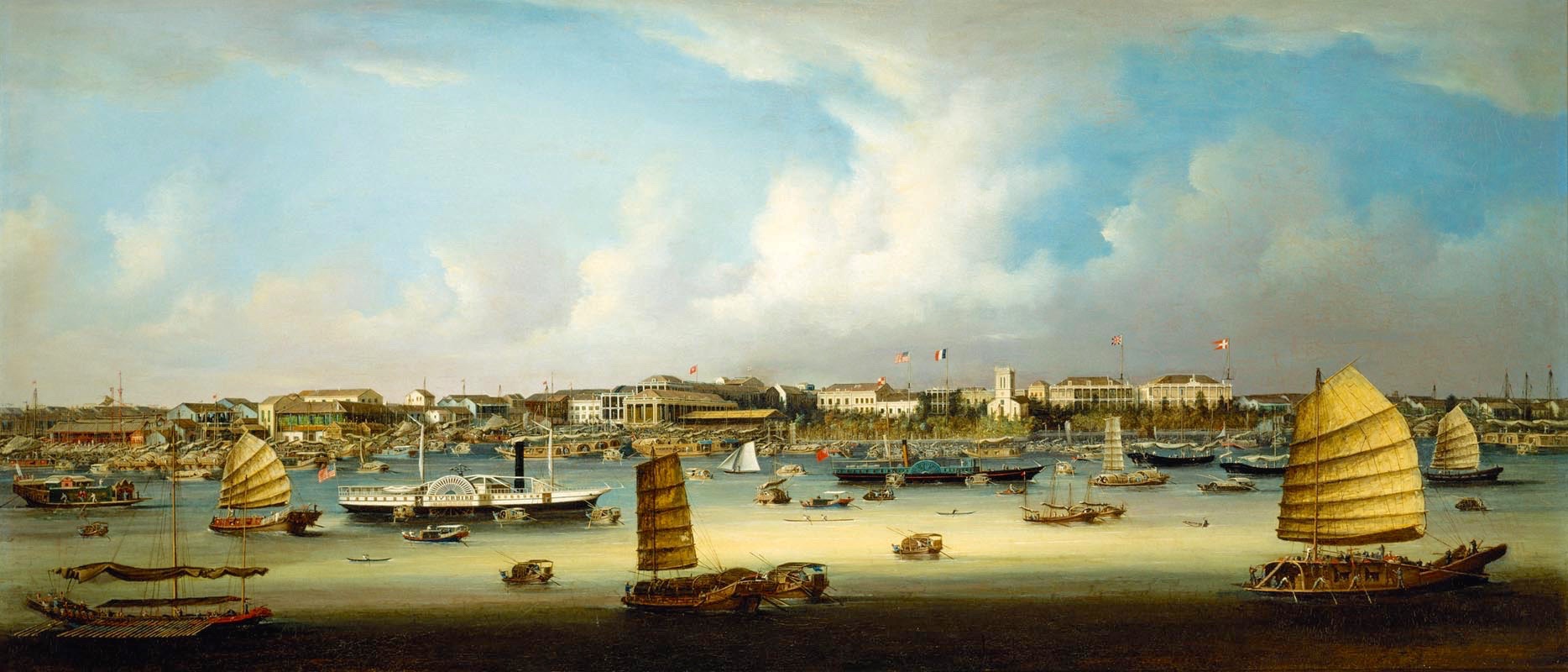 Port of Canton (Guangzhou), ca. 1850, featuring traditional Chinese junk ships and steamliners. Wikimedia Commons.
Port of Canton (Guangzhou), ca. 1850, featuring traditional Chinese junk ships and steamliners. Wikimedia Commons.For China, the result was that it further increased its isolation from the outside world at a time when industrialising European powers were developing at breakneck pace. China’s overall restrictive attitude to trade furthermore greatly contributed to the disastrous and uncontrollable smuggling of opium.
For Guangzhou, the result was that it became China’s official door to the outside world, triggering its development as a coastal metropolis, some 100 km to the northeast of Zhang Huangpan’s home in Longgangli. Portuguese, English, Dutch, French, and Americans, all focused on Guangzhou in seeking a share of the lucrative trade in silk, tea, porcelain, and very importantly, as time went by, opium.
1793: Qianlong and Macartney
However, even for the trade passing through Guangzhou there were considerable limitations: trade was only permitted between October and March, and only a handful of formally licensed Chinese merchants were allowed to conduct foreign trade. Foreign traders were not allowed to communicate directly with Qing officials, yet foreign merchants were required to pay an annual tribute of 55,000 taels (roughly 75,000 USD) to the imperial court. In fact, the court was so intent on keeping the “barbaric” foreigners out of China that it forbade foreigners to study Chinese or read Chinese books at the Guangzhou port.
In 1793, when Huangpan’s son, your great (x4) grandfather Zhang Huadai, was around 10 years old, the British King George III sent Lord Macartney on a mission to China with the aim to convince the Qianlong Emperor to remove all of China’s trade limitations. Lord Macartney arrived on an impressive warship with a large entourage and 600 gift packages that required 90 wagons, 40 barrows, 200 horses, and 3000 porters to carry.
'No’
Unfortunately for the British delegation, the Qianlong Emperor reigned over perhaps the richest, most luxurious courts in all of Chinese history. Its splendor and magnificence made the British presents pale in comparison. As Lord Macartney offered the emperor his cases filled with telescopes, clocks, and watches, the Qianlong Emperor noted simply that China already possessed “everything” and that the British Empire could not possibly offer anything that he would need, let alone make him reconsider his aversion to international trade.
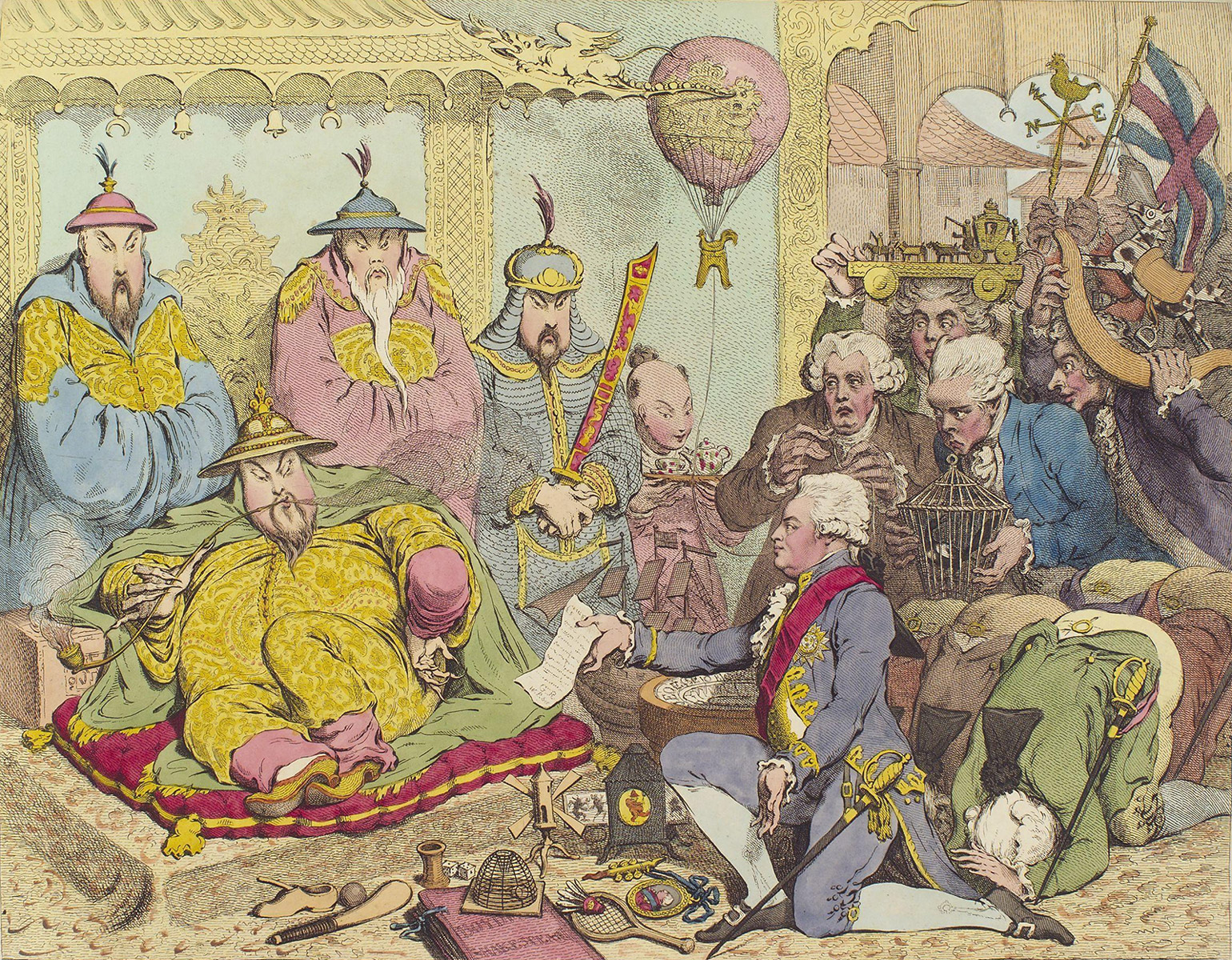 Lord Macartney is shunned by Emperor Qianlong, ca. 1792. Wikimedia Commons.
Lord Macartney is shunned by Emperor Qianlong, ca. 1792. Wikimedia Commons.Lord Macartney left Beijing and remained in Guangzhou before returning to Britain just a few weeks before Chinese New Year, failing to obtain any concessions from China.
The mission will not have had any immediate impact on Zhang Huadai and Huangpan’s lives in Kaiping beyond them perhaps hearing that an impressive and exotic fleet of ships were docked in the port of Canton (today’s Guangzhou). There was likely gossip and speculation in and around Longgangli about the delegation, who they were, and what their intentions were in the area.
Long Term Impact
Little did Zhang Huangpan know, the trend that Lord Macartney’s visit represented would have a deep and direct impact on the lives of his son Huadai and his future grandson, your great-great-great-grandfather Cheun Saan Jeung.
Decades later, the British would return, stronger and richer, to a China that had stagnated. This time, the British would get what they wanted. And this time they would leave the 90 wagons of presents at home and instead introduce a “Century of Humiliation” to China, a century filled with unequal trade treaties, foreign intrusion, forced opening of ports, and an opium trade that spiralled out of control.
Early 1800s: Cheun Saan Jeung’s Childhood in Longgangli
A Time of Population Growth and Agricultural Productivity
Cheun Saan Jeung was born in 1814 in Longgangli. In 1815, he would have been just a toddler when a big earthquake hit Kaiping, and could be heard from everywhere in Chishui.51
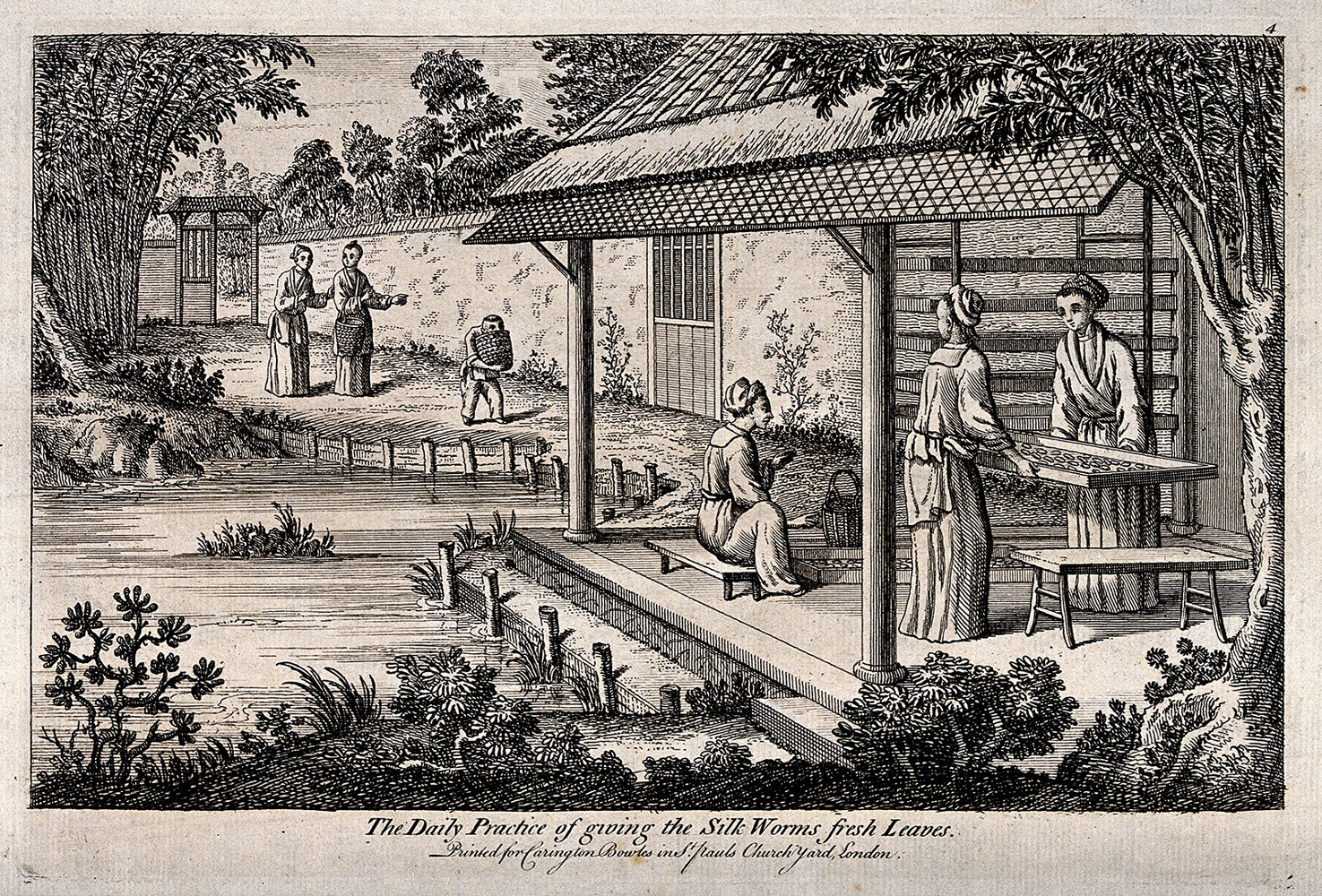 ‘The Daily Practice of giving the Silk Worms fresh leaves.’
‘The Daily Practice of giving the Silk Worms fresh leaves.’Agricultural productivity in Guangdong had increased considerably over the previous decades. Wild longan trees had been felled to make way for mulberry trees and fish ponds, and the raising of silkworms had become a widespread endeavour. Food output had increased in part because maize and sweet potatoes (originally imported from the Americas) were now permitting dry hills and mountains to be tilled.
The population growth that Guangdong experienced during the Mid-Ming Dynasty times of Zhang Shiquan had continued to grow at an even faster pace. Innovation in Chinese agriculture, not just in Kaiping and Taishan but in China overall, had led to stunning population increase across the empire: from 100 million around the time of Zhang Penglong’s birth and Kaiping’s establishment around the 1640s, to 300 million around 1805.52
However, everything is relative, including advancement and growth. Notwithstanding Guangdong’s agricultural innovations and population growth, some 10,000 km to the west, Europe had been going through its “Age of Enlightenment” and had literally moved full steam ahead with its Industrial Revolution. The ensuing imbalances in technological and industrial advancement between Europe and China would soon disrupt the peaceful and simple countryside life of Cheun Saan Jeung and his only, newborn son Bein Yiu Chung, born in 1840.
19th Century (1st Half): Opium
Harvesting Seeds of Doom
The period between the births of your great-great-grandfather Bein Yiu Chung and yourself is generally referred to as China’s “Century of Humiliation.” Starting with the Nanjing Treaty of 1842 and ending with the founding of the People’s Republic in 1949, China found itself continuously humiliated and brought to its knees by foreign powers politically, economically, and militarily. It is not a coincidence that five consecutive generations – up to your father – kept leaving China to pursue better economic opportunities abroad during this exact period, only to occasionally return for largely family-related reasons.
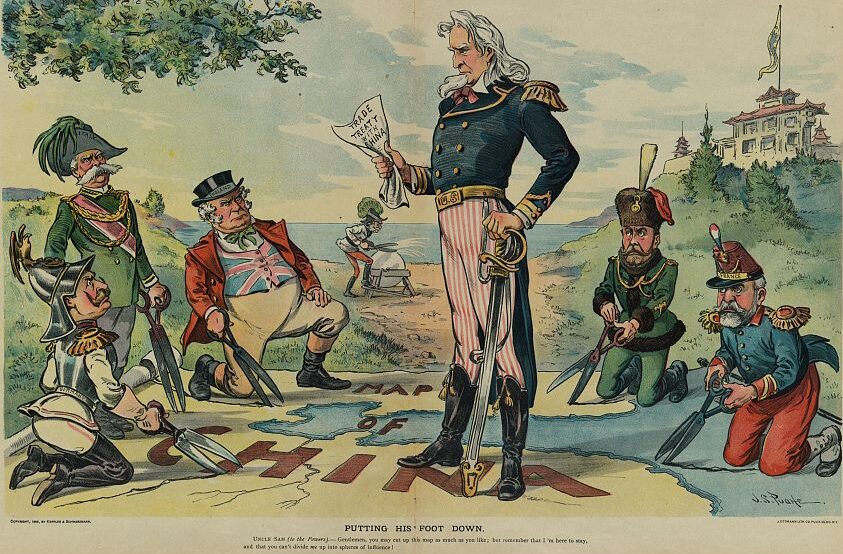 Uncle Sam ‘putting his foot down’, 1899.
Uncle Sam ‘putting his foot down’, 1899.Tea for the British, Opium for the Chinese
Since the early days of the Qing Dynasty in the second half of the 17th century, western and especially British demand for Chinese tea had been increasing sharply. By the 18th century, Britain was drinking so much tea from China that it had built up an enormous trade deficit. Eager to reduce the deficit, Britain tried to import tea from India and export European clothes to China. However, none of these experiments worked: The Chinese had little interest in Western goods and only accepted silver in payment. As a result, the British trade deficit kept growing.
Searching for ways to remedy the trade imbalance, the British finally found a product that interested the Chinese: Opium. The opium was grown by the British East India Company on its plantations in India, and transported by way of Southeast Asia with the help of overseas Chinese traders there. The growth and cheap production of opium on these plantations would be the start of China’s demise a century later.
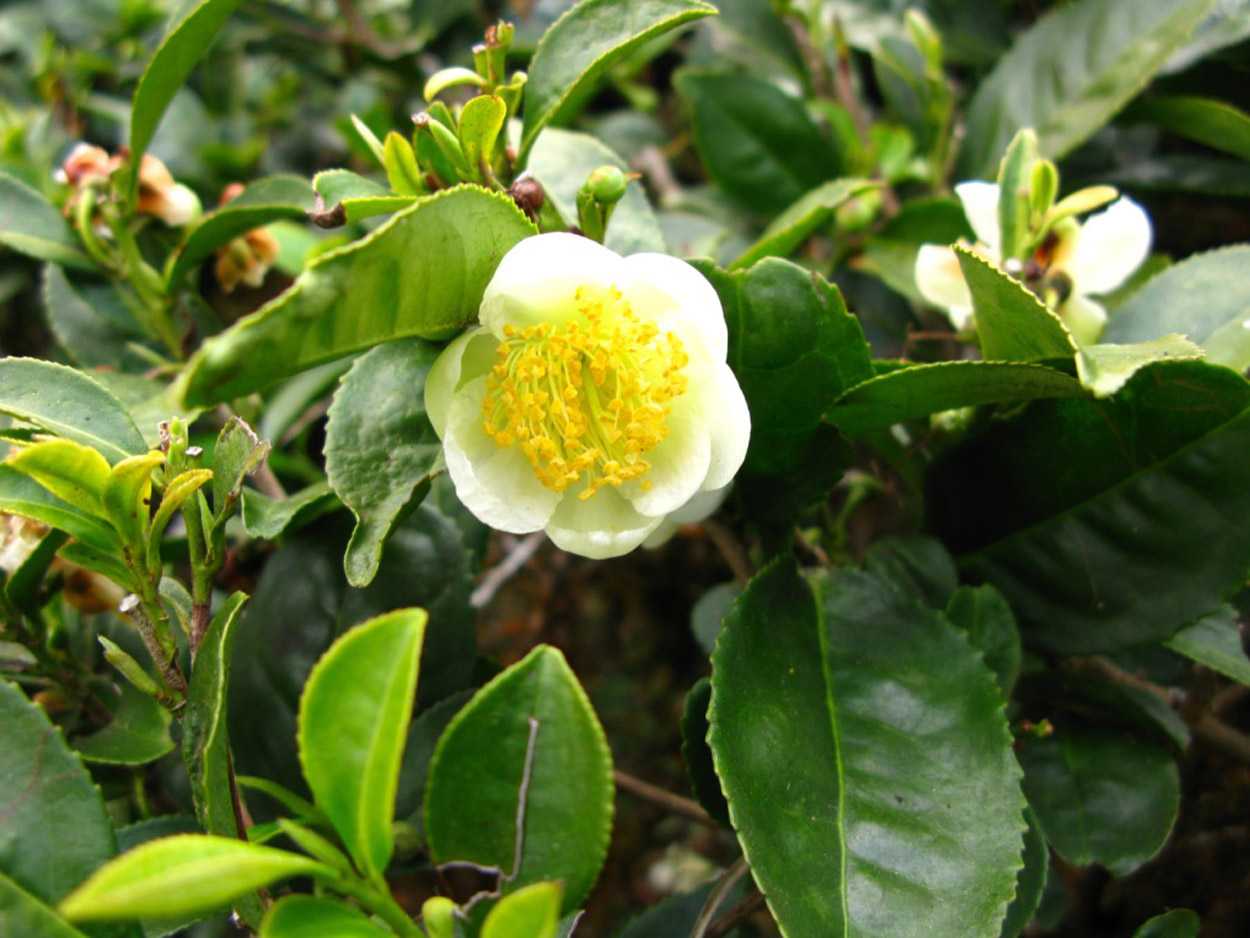 Plant exchange with disastrous impact: Tea (above) for opium (below)
Plant exchange with disastrous impact: Tea (above) for opium (below)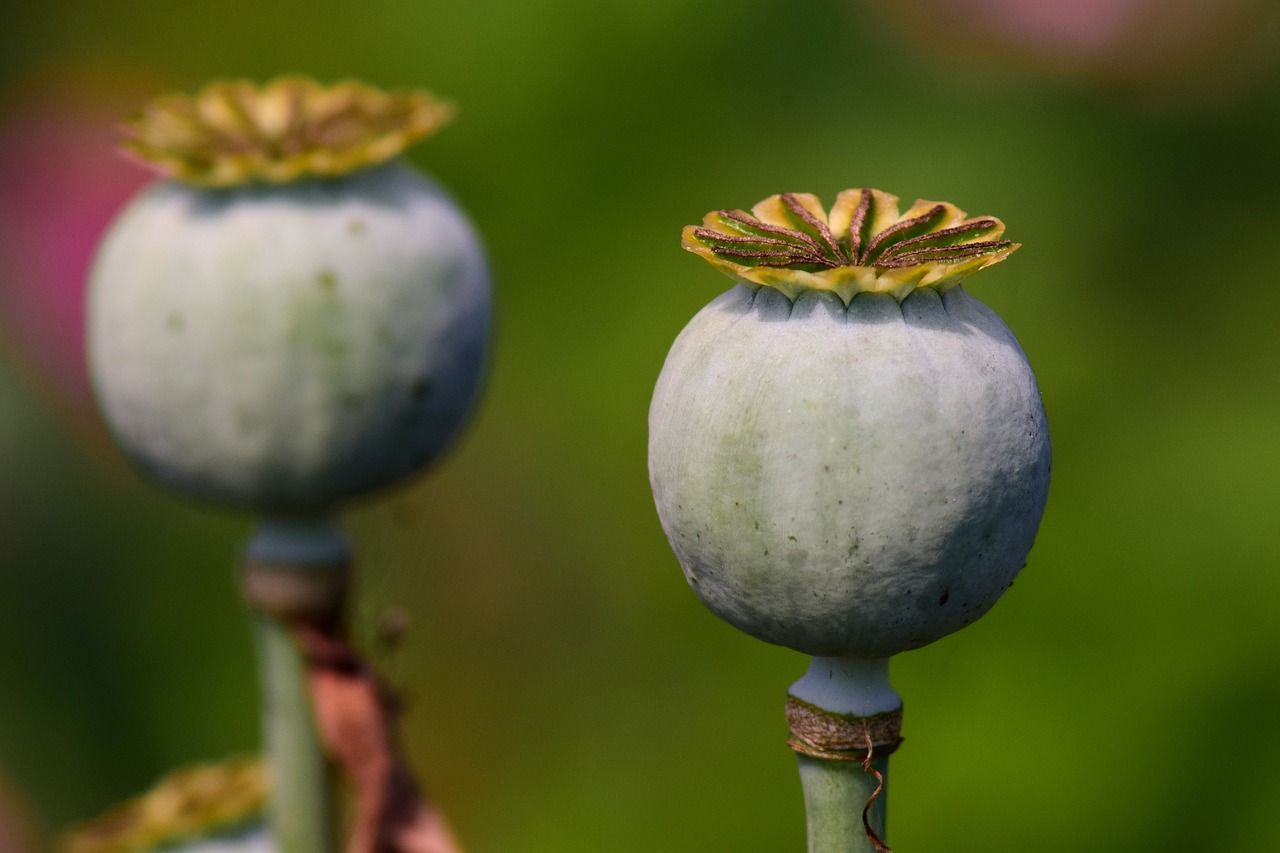
Opium
Opium came in different grades marketed for specific social groups. Opium from Malwa, India was the opium of the masses, while Bengali opium was higher quality and reserved for the wealthy. Opium produced in China’s Yunnan province was separated into four different varieties before it hit the markets, and the best of all domestic opium was custom-made for the Guangdong market. Opium imports and addiction across China throughout the 19th century was unprecedented and never again matched in world history.
1820-1837: Opium Runs Wild
The British East India Company started bringing their opium sales in cargoes to islands off the Guangdong coast where Chinese traders with fast and well-armed boats distributed the goods inland. Traders paid for the opium with silver, which the British could then use to buy more Chinese goods, especially tea. Often, tea leaves could also directly be traded for opium by small scale traders and smugglers. The impact on Chinese society was nothing short of disastrous. Due to Kaiping’s proximity to the coast, your ancestors’ environments were exposed to opium at an early stage.
Between 1820 and 1835, when Cheun Saan would have been a young man, China’s population of opium addicts increased a staggering 50-fold. To make things worse, in 1834, free trade reformers ended the East India Company’s monopoly on opium, which allowed private entrepreneurs from America to join the trade. Competition between and among British and American merchants drove down the price of opium further, which in turn increased sales and made the trade flourish all the more.
Cheun Saan watched the First Opium War unfold right in his backyard. Imagine what it must have been like: the society of his ancestral home was disintegrating due to drug addiction and there will likely have been a constant fear that the British Army could descend on Kaiping at any moment.
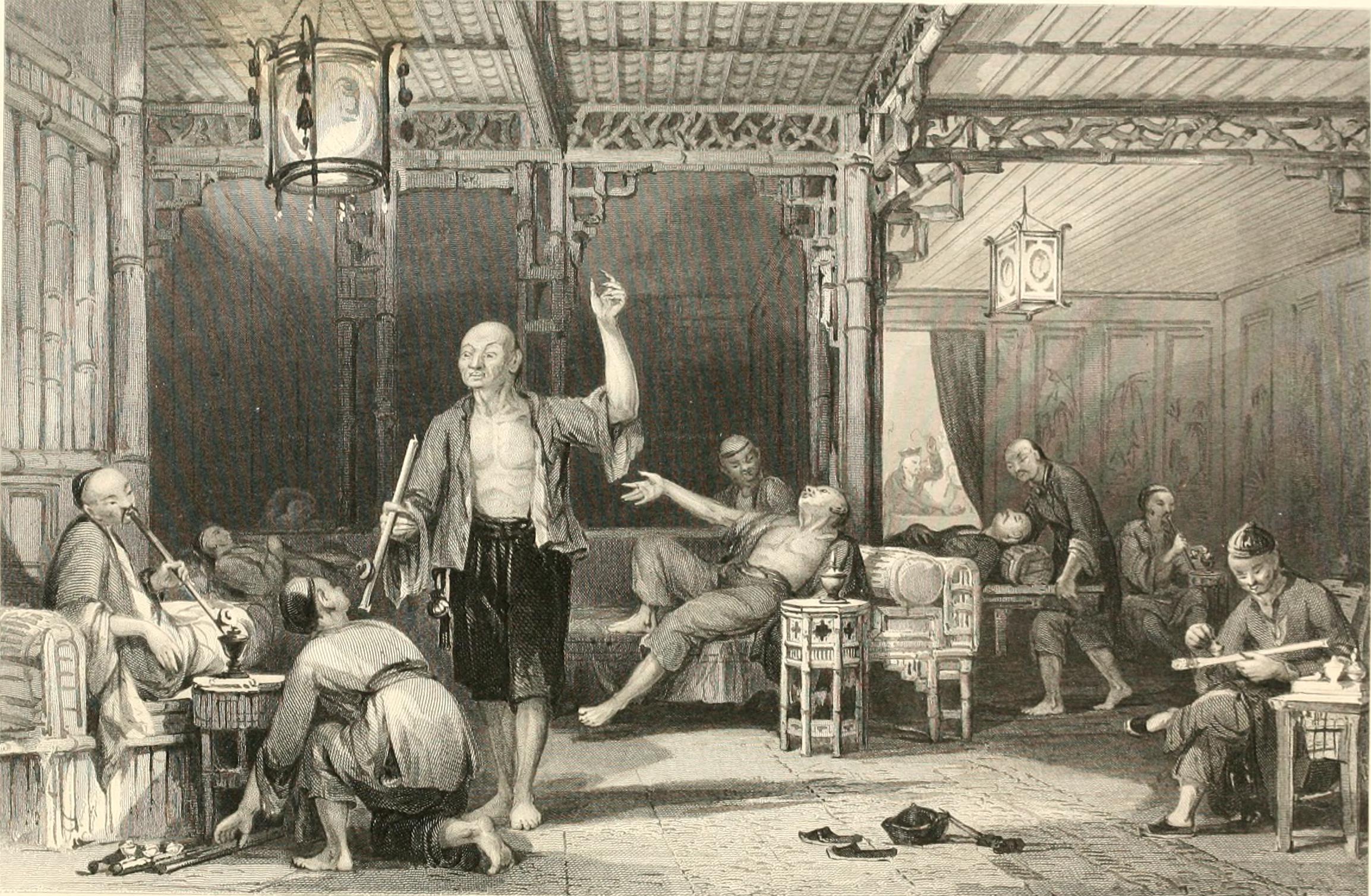 Chinese opium den, ca. 1858. Wikimedia Commons.
Chinese opium den, ca. 1858. Wikimedia Commons.A Prelude called Lin Zexu
By 1839, the overwhelming majority of men of Cheun Saan’s age – late 30s, early 40s – were smoking the drug, especially in Guangdong. Opium dens were everywhere, filled with pale, thin addicts smoking their opium pipes; some euphoric, some sleepy, others sick. Low-priced opium was easily accessible to farmers, and even some villages that did not have shops selling rice were tragically still able to sell opium.
At the Imperial Court in Beijing, Emperor Daoguang had had enough of the opium madness. In 1839, he appointed scholar-official Lin Zexu to abolish the trade. He sent Lin to Guangdong to the provincial government offices in Guangzhou. Lin arrested thousands of opium dealers and confiscated their opium without compensation.
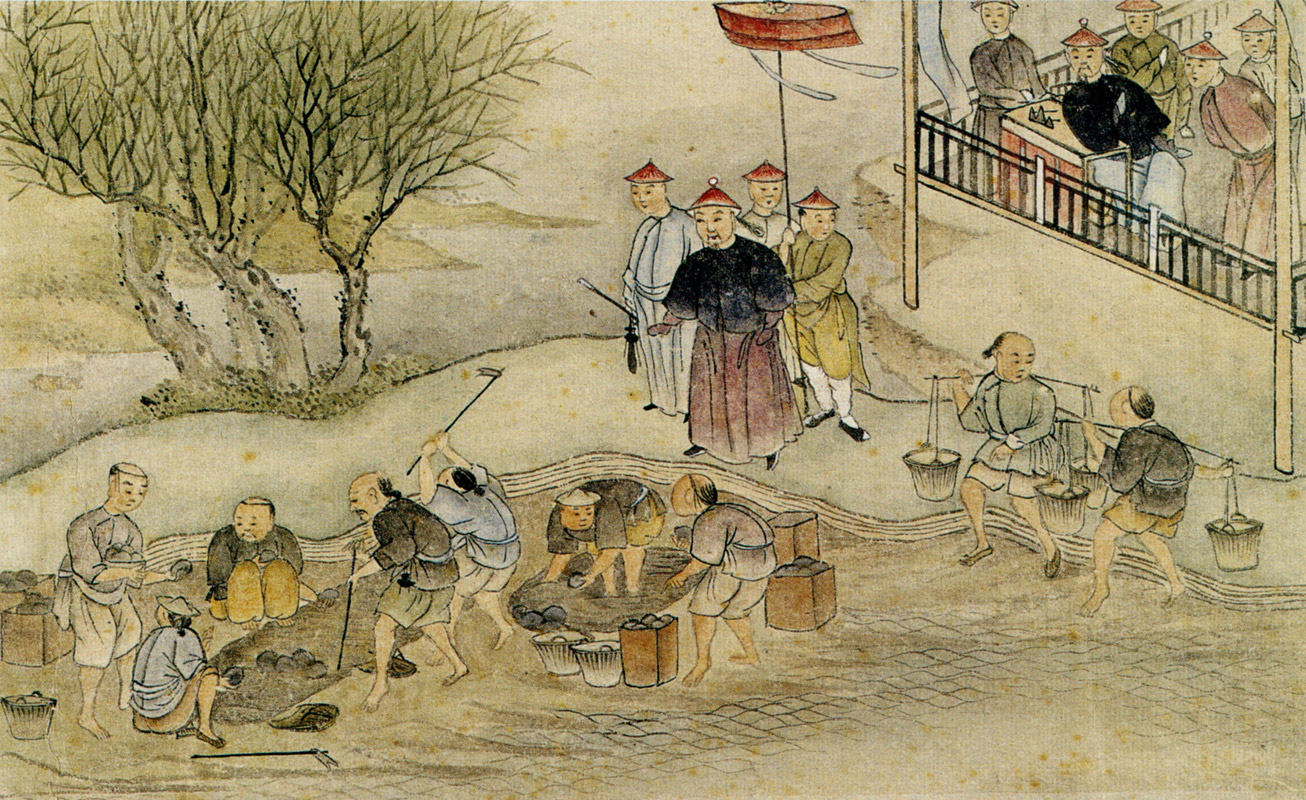 Lin Zexu seizes opium, ca. 1839. Wikimedia Commons.
Lin Zexu seizes opium, ca. 1839. Wikimedia Commons.Following the refusal by foreign companies, especially the East India Company, to forfeit their opium operations, Lin acquired 20,000 chests of opium (approx. 2.66 million pounds) by force and had workers toil for 23 days to destroy it all. The event occurred in a town called Humen, a mere 130 km from Kaiping. The destruction of the imported narcotics had an immense symbolic and economic importance and your entire Zhang family, together with all their Longgangli fellow villagers will have heard of Lin Zexu’s act of defiance.
1839-1842: The First Opium War
News of the destruction of the large volume of opium at Humen reached London fast. Shareholders at the East India Company’s headquarters, who were making a 2000% profit on opium sold to China, were not amused. Due to the political influence of the East India Company, it was not long before a British force of 15 barracks ships, 4 steam-powered gunboats and 25 smaller boats with 4000 marines reached the coast of Guangdong.
The First Opium War had started and by January 26, 1841 the British had officially occupied Hong Kong island. Cheun Saan Jeung watched the First Opium War unfold right in his backyard. Imagine what it must have been like: the social environment of his ancestral home had already disintegrated due to overwhelming drug addictions and now the powerful British Army was about to descend on Kaiping at any moment. What was going to happen to his young family? His only son, your great-great-grandfather Bein Yiu, was only one. How was Cheun Saan going to protect him?
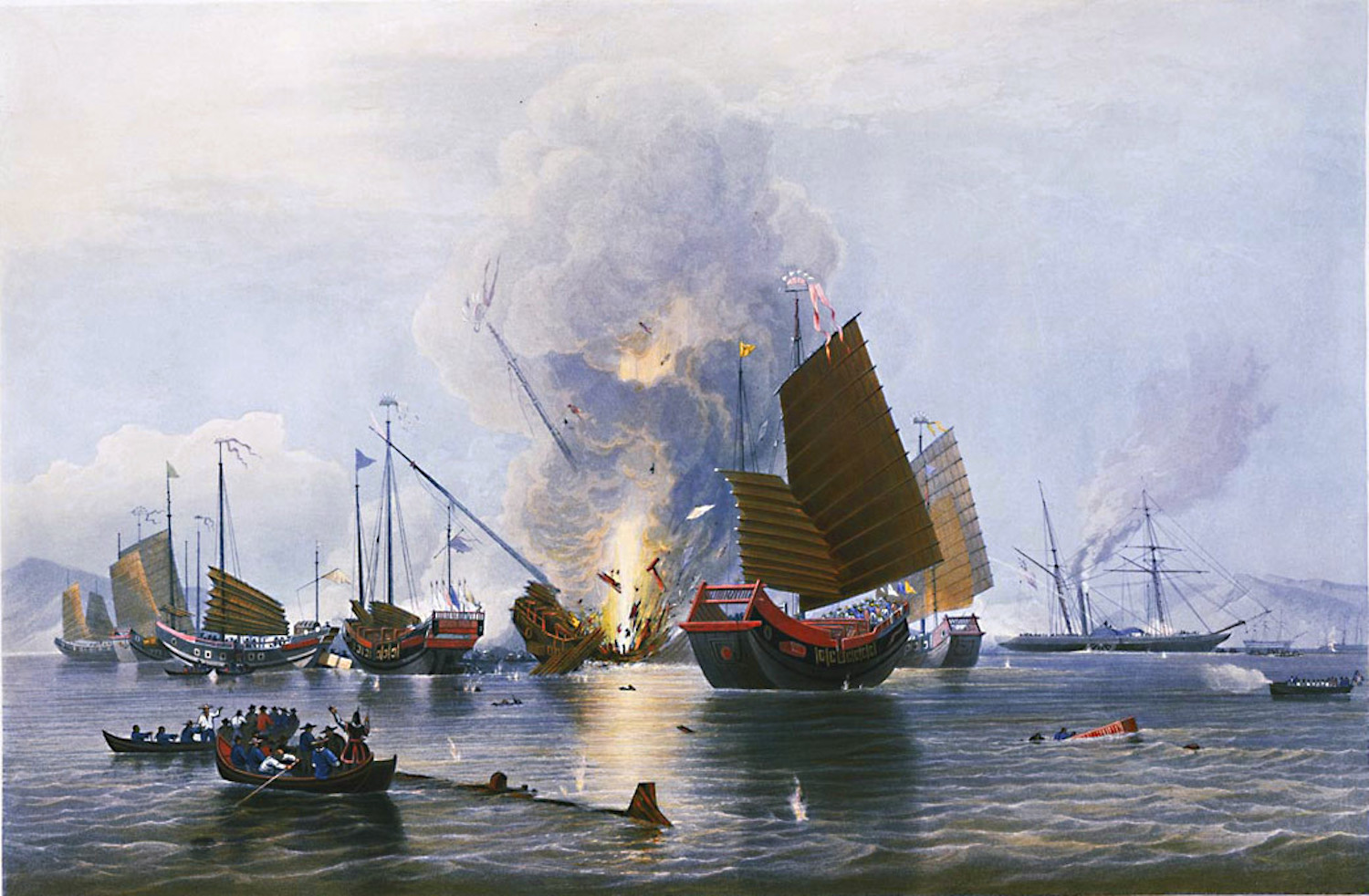 British East India steamships destroy Chinese junks in Anson’s Bay, 1843. Wikimedia Commons.
British East India steamships destroy Chinese junks in Anson’s Bay, 1843. Wikimedia Commons.1842-1865: Century of Humiliation and 170-Year Zhang Clan Odyssey
1842: The Treaty of Nanjing
The Treaty of Nanjing of 1842 officially concluded the First Opium War and dismantled the Canton System, the source of so much of the British East India Company’s frustration. Known by the Chinese as the first of many “unequal treaties,” the Nanjing Treaty granted Britain five trading ports along China’s coast (including the port of Guangzhou, 115 km northeast of Kaiping), foreign legal jurisdiction over these ports, control tariffs, a Christian missionary presence, and Hong Kong. After the war, large amounts of foreign goods were imported to China.
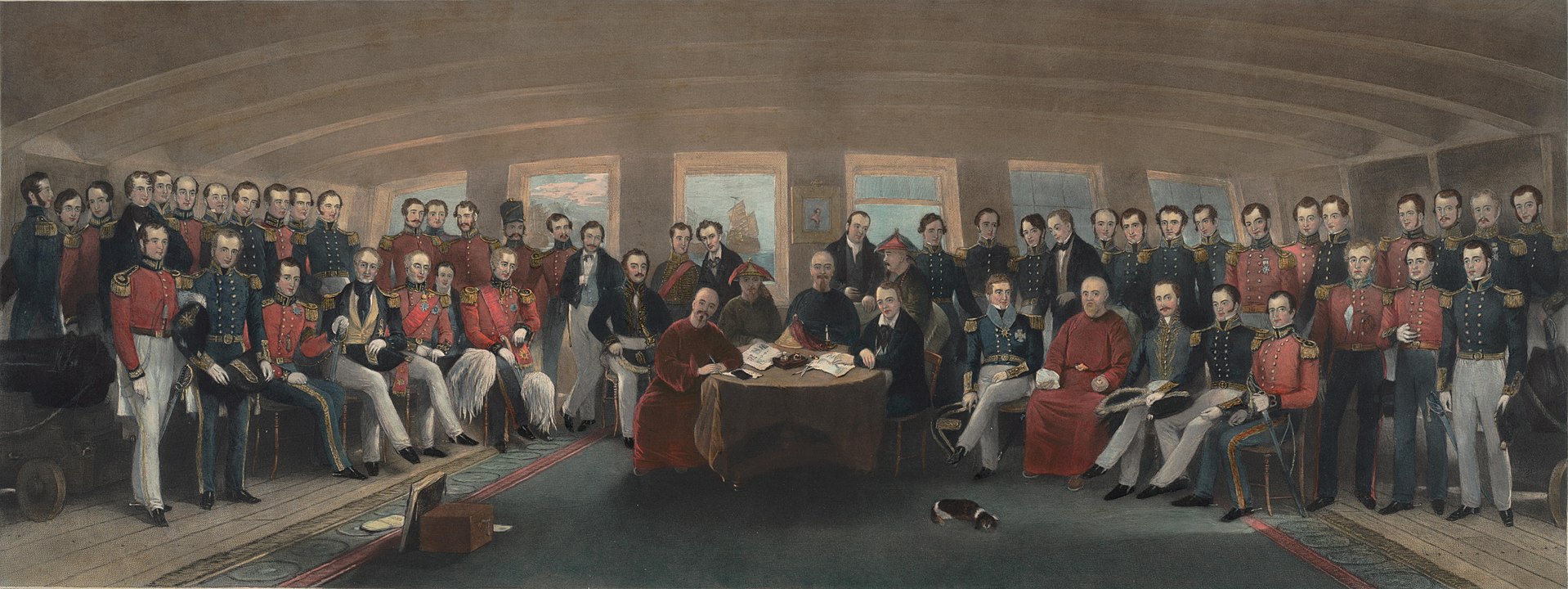 Signing of the Treaty of Nanjing. Wikimedia Commons.
Signing of the Treaty of Nanjing. Wikimedia Commons.1849: Cheun Saan, First of Five Consecutive Zhang Generations to Leave
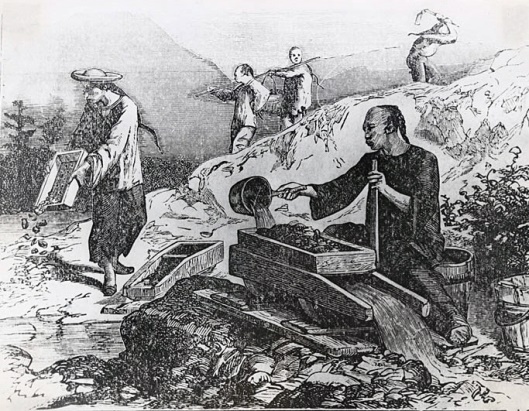 Chinese gold miners in ‘Old Gold Mountain’.
Chinese gold miners in ‘Old Gold Mountain’.In the late 1840s, Cheun Saan and perhaps even young Bein Yiu will have heard increased mentioning of a place called “Old Gold Mountain”: A place roughly three months away by boat where one could easily make a fortune by taking gold from the earth.53 Chinese from areas in and around Kaiping and neighboring Taishan were moving there in relatively large numbers.
Your great-great-great-grandfather Cheun Saan Jeung would join them soon after 1849, scouring the Central Valley riverbeds in California for little specks of gold. A new period had started for your Longgangli Zhang Clan, a turbulent period of back-and-forths, of six generations living between two worlds, of an odyssey that was to last some 170 years.
It was also the start of a new era for Longgangli in general: the start of its gradually forming identity of a “qiaoxiang,” i.e. a village inhabited mostly by relatives of overseas Chinese and returned overseas Chinese. During our interviews in Longgangli, we found that almost every single family in Longgangli has at least one relative who went abroad. Most left for the U.S. and San Francisco; few left to Southeast Asia.
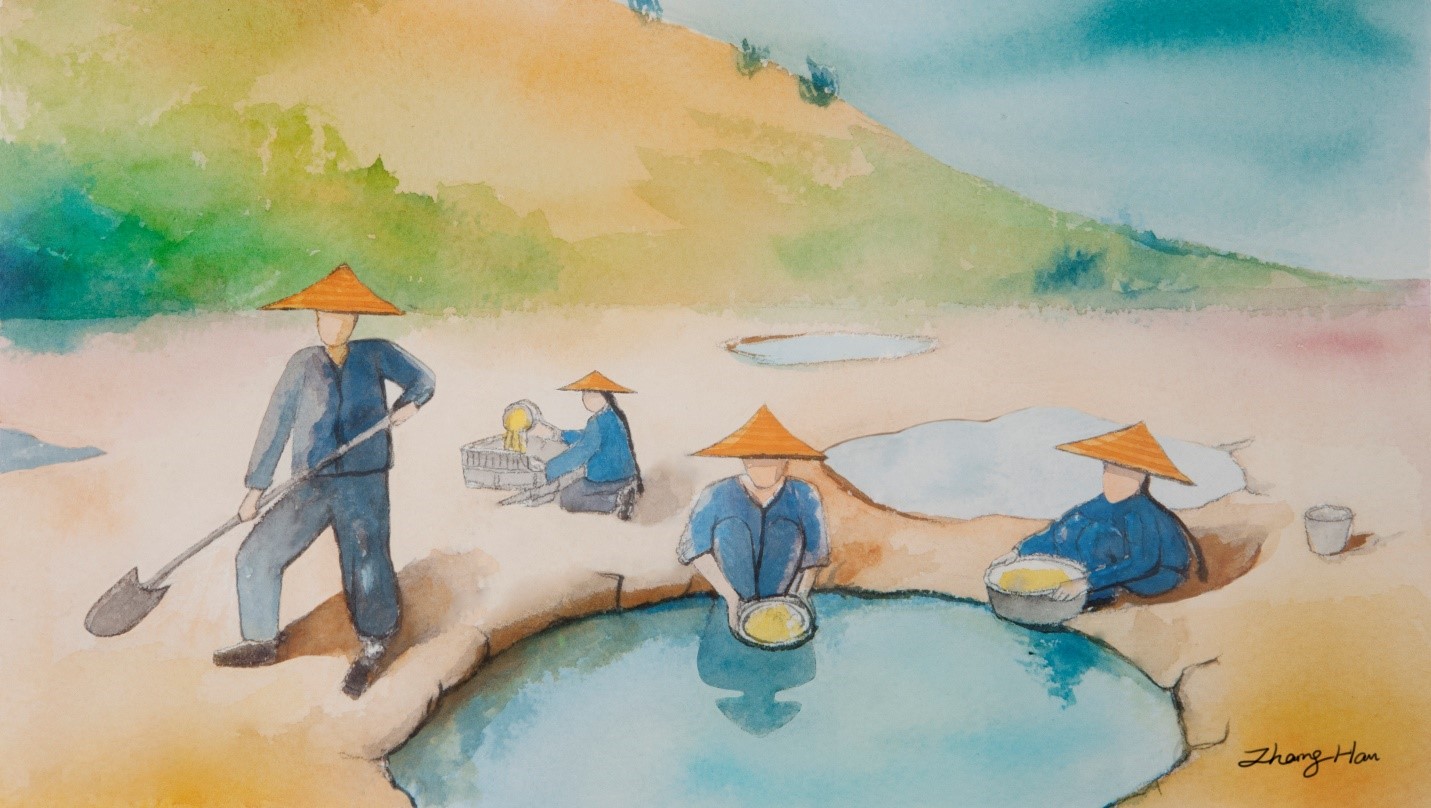 Cheun Saan Jeung mined for gold at the Central Valley of California in America, “Gold Mountain.” Zhang Han.
Cheun Saan Jeung mined for gold at the Central Valley of California in America, “Gold Mountain.” Zhang Han.1851-1867: Bein Yiu Grows Up Amidst Rebellions and Despair in Southern China
With the British army stationed next door in Hong Kong, the Nanjing Treaty forcing China to open up, and increasing numbers of Chinese workers moving abroad, it would not be long before Bein Yiu Chung followed his father.
Moreover, as Bein Yiu reached adulthood in the 1860s, a number of violent uprisings raged through Guangdong province. Two of these had quite a destructive impact on Kaiping: The Red Turban Revolts and the Hakka-Punti Clan Wars. While it is unclear whether the Longgangli Zhang clan proactively took part, they will certainly have been directly exposed to the instability, fear, and chaos that surrounded these rebellions.
Both uprisings were to a large extent inspired by the “success” of the Taiping Rebellion, which had started in 1851 in southern China and quickly made its way north (see textbox). While the Red Turban Revolts and the Hakka-Punti Clan Wars may have had distinct features and leadership, like the Taiping Rebellion, they were part of an overall environment of extreme social discontent due to corrupt government, increased foreign influence, overpopulation, unemployment, ecological disasters, bad harvests, and general poverty.
The Taiping Rebellion
In 1851, Hong Xiuquan, a Hakka Chinese Christian fundamentalist from a village some 150 km northeast of Kaiping, led a peasant uprising that turned into one of the deadliest armed conflicts in history. Believing he was a younger brother of Jesus Christ, Hong Xiuquan aimed to overthrow the Qing Dynasty that had come to be viewed as inept and corrupt after the natural disasters, economic problems and humiliating defeats at the hands of barbaric foreigners during the First Opium War.
Hong Xiuquan sought to restore order and pride, and set out to build a “Heavenly Kingdom.” The (mostly) Hakka peasant uprising fought against foreign influence, feudalism, and traditional concepts such as Confucianism and Buddhism, while advocating equality for women and common ownership of land and resources. The rebellion quickly spread throughout southern China but just as quickly turned north, and basing its capital in Nanjing.
Thirteen years later, in 1864, the Qing armies were finally able to quash the rebellion with help from the French and British forces. By the time the “Heavenly Kingdom” had gone, it had left behind an estimated 20-30 million dead, making it the most detrimental civil war in history. Compared to the Red Turban Revolt and the Hakka-Punti Clan Wars, the Taiping Rebellion had much less of a direct impact on daily life in Taishan and Kaiping. However, in addition to acting as a catalyst for those revolts, the Taiping Rebellion had a major impact on China as it left a weakened Qing Dynasty in steep decline and gave rise to a host of further reform and revolutionary movements.
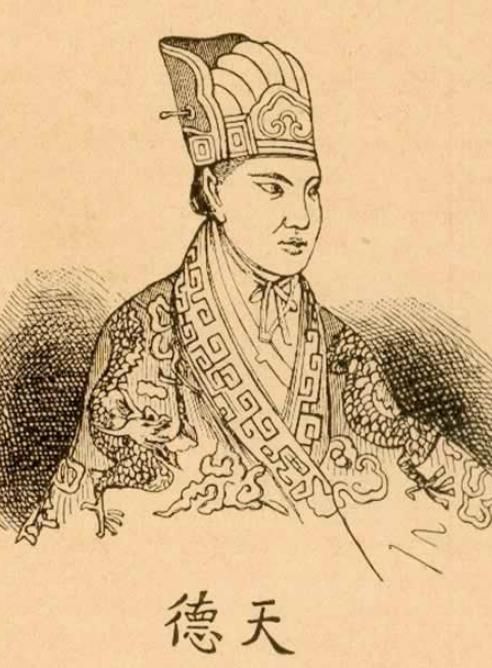 Hong Xiuquan
Hong Xiuquan1854-1857: Red Turban Revolts
The instigators and rebels in the “Red Turban Revolts” were mostly members of the Tiandihui: the anti-Qing society that was founded by Ming loyalists during the start of the Qing Dynasty.
Large numbers of Red Turban rebels were from the wider Kaiping and Taishan region. They were typically marginalized and impoverished men like peddlers, labourers, petty landowners, farmers, and local bandits. Excessive flooding in the area, government inaction and corruption, the inflation of silver and devaluation of coins, and rapid price increases for daily goods made them turn to the Tiandihui for support and solidarity.
Inspired by the Taiping rebels’ capture of the strategically important city of Nanjing, a series of Red Turban uprisings started in Guangdong in 1854. In July of that year, the Red Turban Army conquered Changsha in Kaiping before crossing the Tan River. Their next stop was Taishan, where they received the help of over 1000 additional Red Turban rebels from Heshan. Traveling from Changsha to Taishan, the rebels passed by Longgangli, a mere 15-20 km from their path.
According to an oral history interview conducted with your third cousin Zhang Zaiyi in Longgangli,54 Bein Yiu had a difficult life prior to his trip to America. He made a living collecting firewood in the surrounding woods, a strenuous and monotonous job. Moreover, the job was likely unsafe, being outside the protection of the village and with so much social unrest occurring in the wider area with bandits and rebels roaming the hills and the woods. To make things worse, in 1854, the price of rice almost tripled to 70 copper coins per kg, and the whole of Kaiping experienced severe famine. Many starved to death. These will have been utterly disturbing times for your 14-year-old great-great-grandfather Bein Yiu.
In November, a Qing government official named Peng Qingyun was appointed as the county magistrate of Kaiping. In secret, Peng Qingyun travelled by foot to Chikan town from Xinning (today’s Taishan). Soon after his arrival in Chikan, he called a meeting with locals to discuss tactics to fight the Red Turban Rebels. The Qing government forces led by Peng then succeeded in beating the unorganized and under-supplied rebels in Taishan, and initiated a massive search for Red Turban members. Over 400 Red Turban Army members were killed.
1856-1867: Hakka-Punti Clan Wars
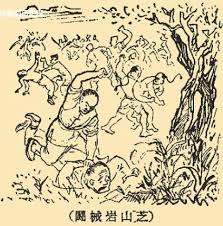 The Hakka-Punti clan wars
The Hakka-Punti clan warsSince the second year of the Red Turban uprisings, malicious, ethnic tensions in the region turned into the Hakka-Punti Clan Wars. Hakka-Punti fighting was a direct result of the ethnic tensions that had been building up over centuries between the Punti (seen as “the locals”) and Hakka (seen as “the newcomers”), following the Hakka influx to the Pearl River Delta after the Kangxi Emperor’s 1662 “Great Coastal Clearance Order” was lifted.
Since then, an increasing number of Hakka had excelled academically, were admitted to the lower ranks of government and were earning appointments as district magistrates and prefects. While a lot of the Hakka-Punti fighting took place independently of the Red Turban Revolt, there was also considerable overlap. As the overwhelming majority of the Red Turban rebels were Punti, many Hakka had joined the Qing army troops or gentry militias.
1860s-1870s: Bein Yiu Chung Leaves A China That Is Breaking Down
1865: Birth of Hoy Lun and Hakka Massacre on the Doorstep
Fighting reached Bein Yiu’s doorstep in Chishui in January 1865, the year his son, your great-grandfather Hoy Lun, was born.55
Zhuo Xing, the Vice-General of Guangdong, Leizhou and Hainan, had ordered the Hakkas from elsewhere in Guangdong to find refuge in select places in the region, including Nafu and Jinji in Enping County (today, these fall respectively in Taishan and Kaiping Counties), Shenjing and Damen in Xinning County, and last but not least: Chishui and Dongshan in Kaiping.
Hakka refugees arrived in hordes in your ancestors’ Chishui town, looking for a new place to settle. However, the Chishui Punti refused to receive them and fighting broke loose, resulting in bloodshed and casualties on both sides.56
How would Bein Yiu, at the still impressionable age of 25, have felt about the conflict? Would he have seen the Hakka as interlopers, and felt it necessary to join in the violence in an effort to preserve his home? His father was on the other end of the world; who would he turn to for guidance? Would his mother have urged him to just stay away from the danger?
1865: Bein Yiu Off to the Transcontinental Railroad
It could also have been the case that Bein Yiu was preoccupied with a different matter, namely of leaving home himself.
Since the late 1840s, men like his father across Kaiping had been leaving overseas to make money. The utter destruction and economic misery from the Red Turban Revolts, the Hakka-Punti Clan Wars, the Taiping Rebellion, and a second Opium War (1856-1860), only added reasons to leave and brought about a mass exodus. Hundreds of thousands of Kaipingese were leaving China between the 1850s and 1880s.
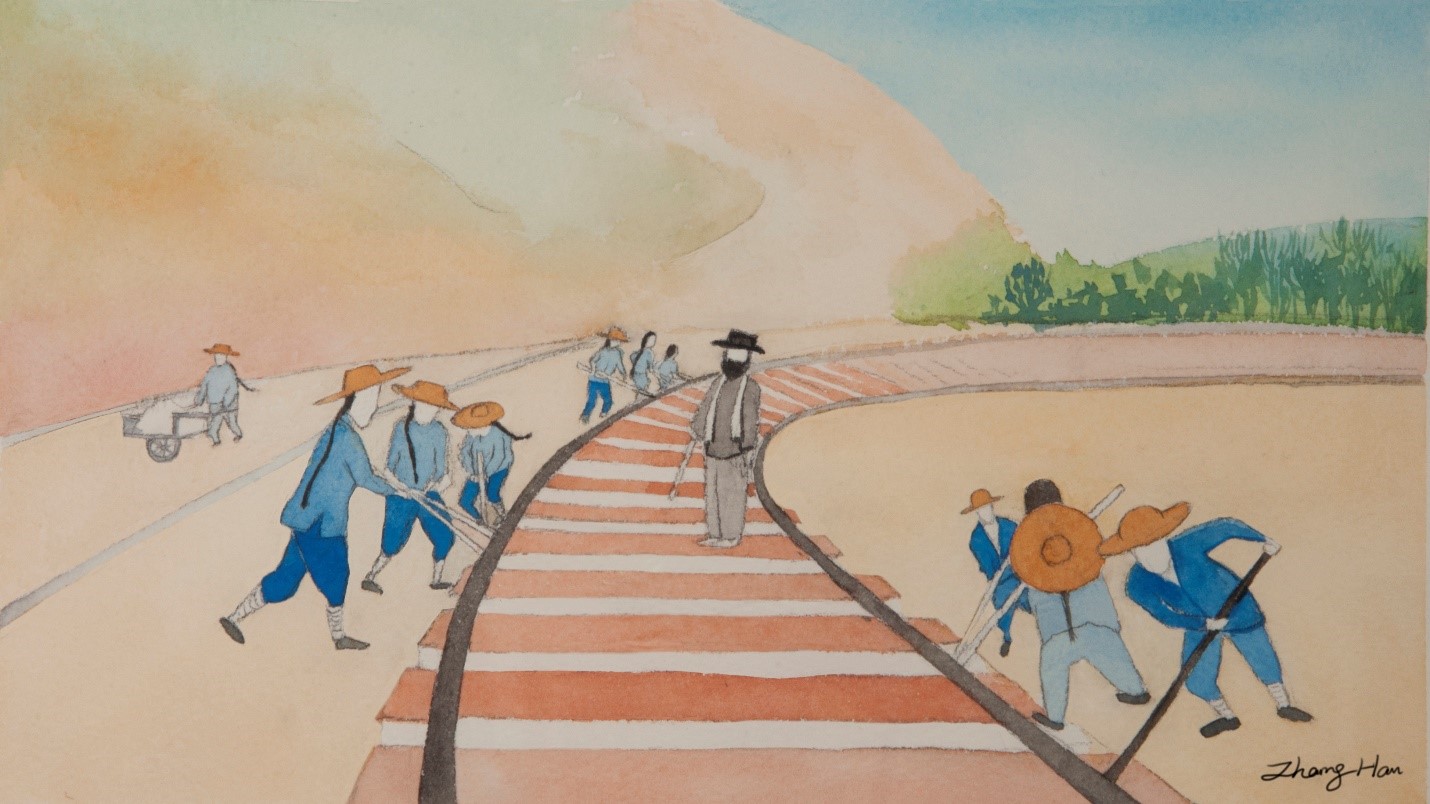 With the Army of Canton, Bein Yiu Chung helped build the Transcontinental Railroad, the “Iron Road,” from California to Utah. Zhang Han.
With the Army of Canton, Bein Yiu Chung helped build the Transcontinental Railroad, the “Iron Road,” from California to Utah. Zhang Han.Your great-great-grandfather Bein Yiu Chung was part of this mass exodus. In 1865, he left for the US with his cousin to work on the Transcontinental Railroad. Bein Yiu was nine when his father left for the US, and he will have likely remembered Cheun Saan taking off, not knowing if he would ever return. Was Bein Yiu hoping to see his father in the US, after 16 years? Would Cheun Saan still recognize him?
Like his father, Bein Yiu left behind a young family in Longgangli. Around the time his son Hoy Lun was born, Bein Yiu was saying goodbye to his family, not knowing if he would ever make it back to Longgangli to see his boy grow up.
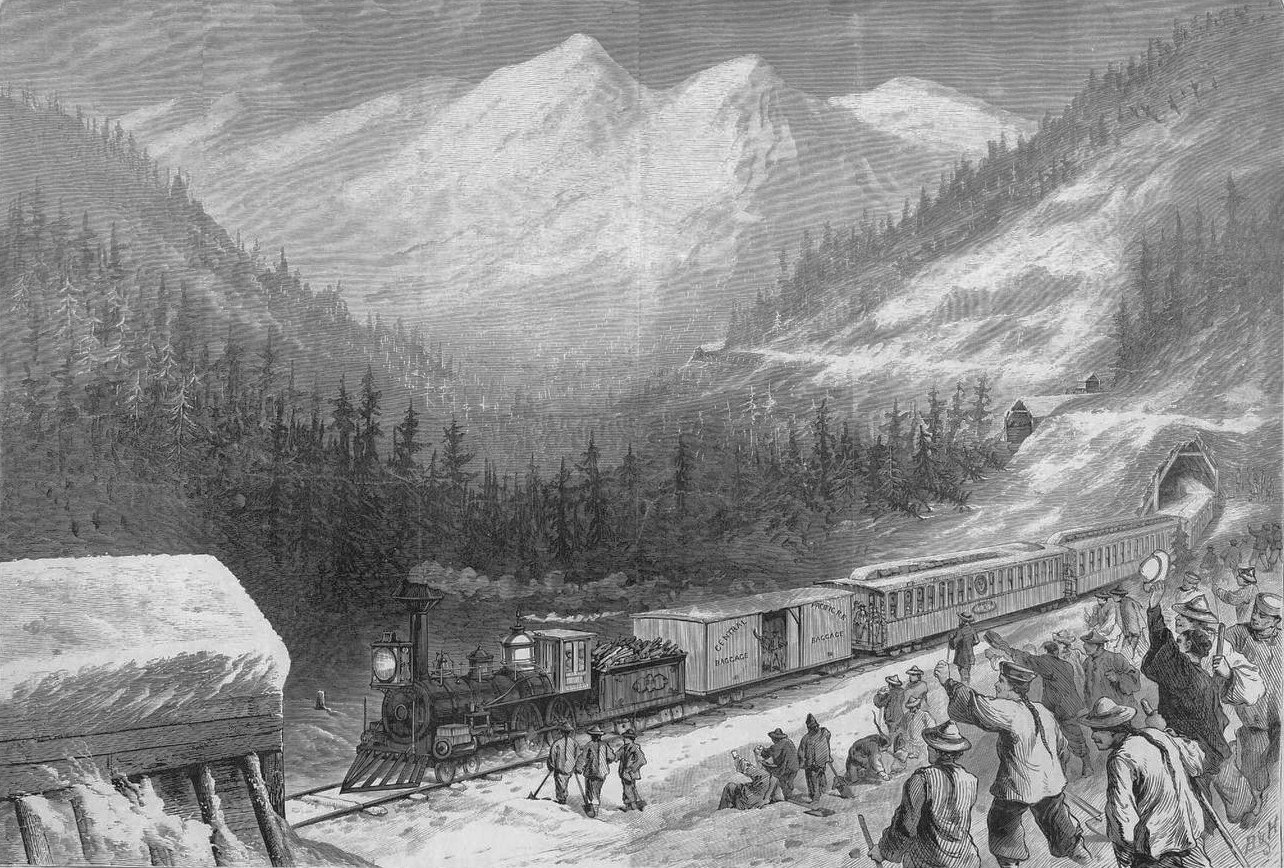 The transcontinental railroad
The transcontinental railroad1866: Ceasefire
While we do not know about the loyalties and viewpoints of your Zhang ancestors in Longgangli, it is without a doubt that they, together with their friends, neighbours and relatives will have known about – if not witnessed or participated in – the slaughter that ensued after Bein Yiu left for the US. All in all, over 150,000 Hakka perished during the Hakka-Punti Clan Wars.
In 1866, the provincial governor of Guangdong Ruilin and the mayor Jiang Yili sent the agricultural officer Mei Qichao and the military general of the Qing’s border army Xu Wenxiu to settle the Punti-Hakka Clan Wars in the Kaiping and Enping areas.57 In September, the Hakka forces disbanded and both sides agreed upon a ceasefire.
Meanwhile in Zhongshan, 103 km to the East...
In November 1866, a young boy and contemporary of Hoy Lun was born in a small seaside village in Zhongshan, Guangdong province. As a young man, he would come to lead a revolutionary movement that overthrew the Qing dynasty, ending 2000 years of imperial rule, and subsequently becoming the first president and founding father of the Republic of China. His name was Sun Yatsen.
Meanwhile in San Francisco, 11,000 km to the West...
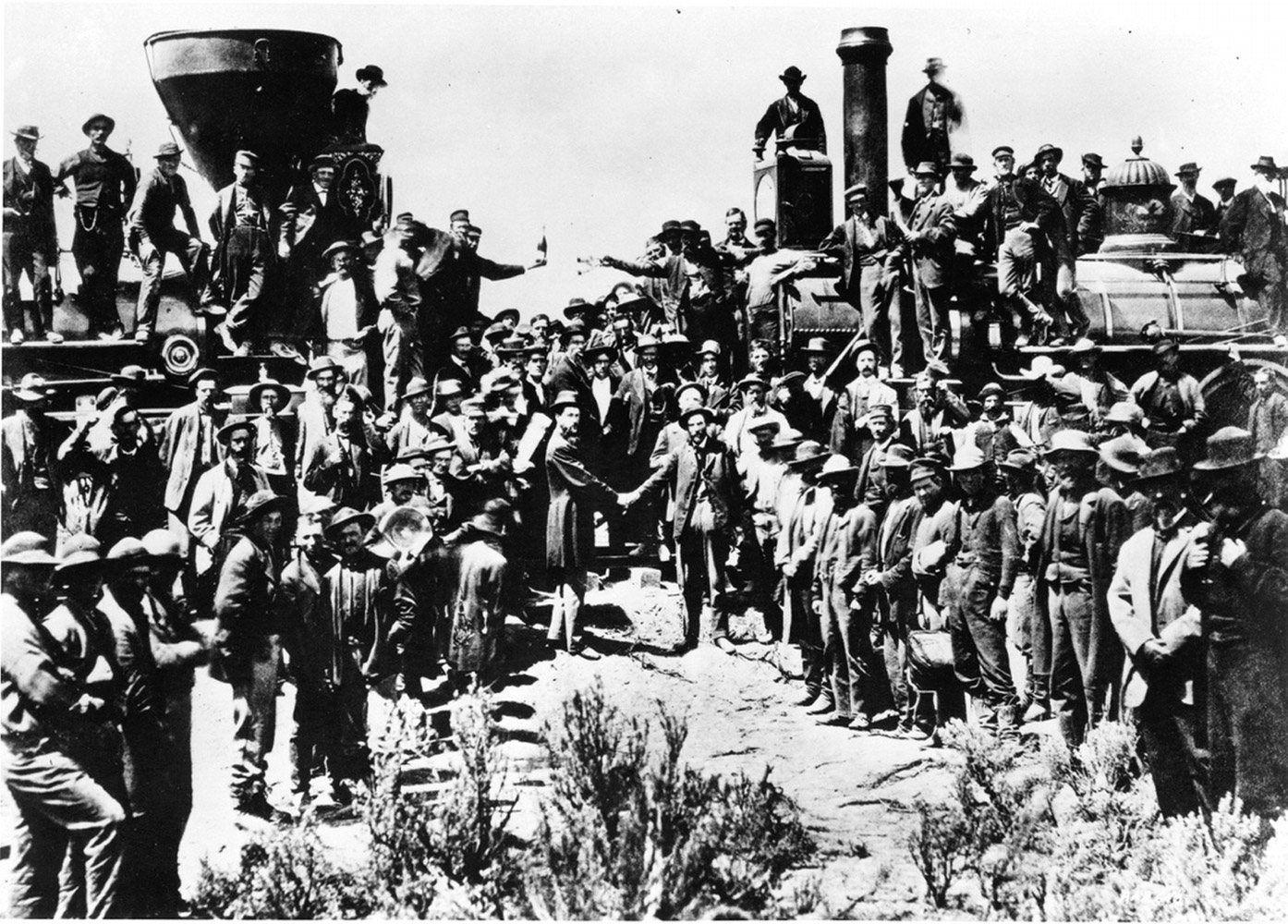 Promontory Summit on the Day of the Golden Spike, May 10th, 1869. Notice the absence of Chinese faces, which were apparently deemed inappropriate for the railroad’s public relations purposes.
Promontory Summit on the Day of the Golden Spike, May 10th, 1869. Notice the absence of Chinese faces, which were apparently deemed inappropriate for the railroad’s public relations purposes.After arriving in San Francisco, Bein Yiu made his way to Sacramento. There, he started working on the Transcontinental Railroad, the Iron Road, perhaps the greatest engineering marvel of America in the 19th century. For several years, he and his comrades painfully labored in the hinterlands of the Far West. He endured the chilly winters on the granite mountain and the hellish summer at the great desert. He likely journeyed from California through Nevada all the way to Utah until the work was closed at Promontory Summit, Utah, on May 10, 1869, the Day of the Golden Spike.
That same year, and four years after his departure in 1865, Bein Yiu returned to Longgangli, a “Gold Mountain man.” His little boy, Hoy Lun, was now four years old and probably running around being naughty. Bein Yiu built a house in the village for his family. In 1881, after his wife Ms. Zhou passed away, he married for a second time.
1880s-1890s: Hoy Lun Chung Leaves A Broken China Unable to Reform
Economic Situation Improves in Longgangli with Overseas Money
In the 1880s, besides occasional floods and hurricanes, Bein Yiu and his teenage son Hoy Lun will have seen the overall situation in and around their village improve slightly. Money was being sent home from abroad, to the extent that some families had become completely dependent on the funds sent back by their brothers, cousins or nephews overseas. At first, the overseas money was spent on food and other daily life essentials. After a while, families were seen to be building new homes. A few decades into the 20th century, remittances from overseas would finance completely new facilities such as schools, hospitals, and churches.
In 1891, at the age of 26, Hoy Lun would follow in his father’s and grandfather’s footsteps, booking a passage for himself and his brother Peiyi to America. He will surely have heard many stories from his father about the country he was going to, but would he have known at the time that he was leaving behind a wife, Ms. Wong, who had just gotten pregnant?
1892: Birth of Your Grandfather Moi Chung
Less than nine months later, in 1892, heavy winter snows fell early in Kaiping, freezing fish in the Baishui River and causing the lotus roots to wither. Hoy Lun’s son Moi Chung was born, at the dawn of the tumultuous 20th century.
A year later, another small baby was born some 630 km directly north of Longgangli, in Hunan province, on a cold December night. Though nobody knew it then, this baby would come to change the fate of your family and be singlehandedly responsible for a lot of the tumult in the 20th century, in China and abroad. The baby’s name was Mao Zedong.
The First Sino-Japanese War Leads to Calls for Reform
Moi Chung will have grown up in the household of his returned grandfather Bein Yiu, in his 50s, his step-grandmother Ms. Huang, and his mother, who will have lived with her in-laws and was also surnamed Huang.
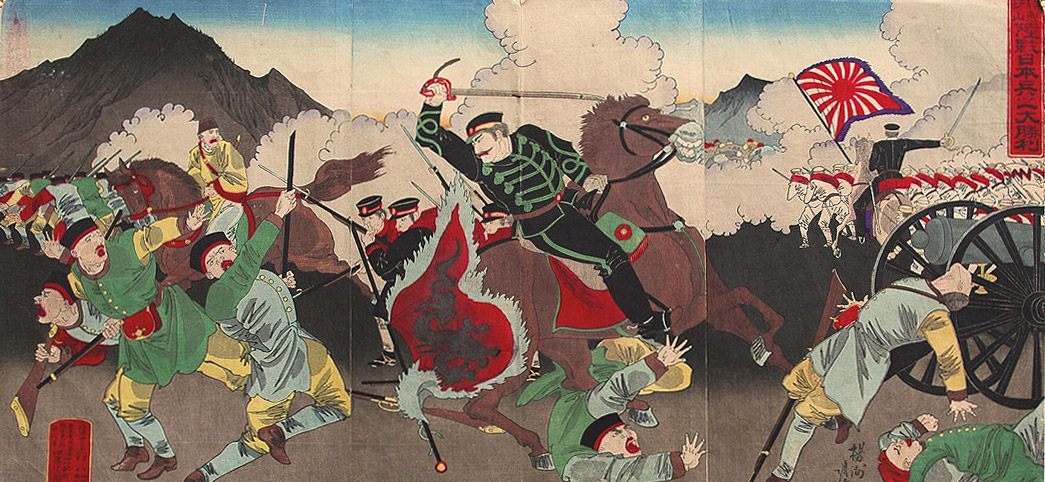 The First Sino-Japanese War
The First Sino-Japanese WarAround the time little Moi was two years old, learning to walk, run, and talk, China’s decline took a turn for the worse: the First Sino-Japanese War (1894–1895) had broken out and a year later, China had lost yet another war against a foreign “barbaric” power. The loss against Japan was particularly humiliating as China had always regarded Japan as an inferior tribute state. It was a major blow to China’s pride and self-confidence, and spawned a series of other humiliating bilateral conflicts, most notably against Germany and Russia. It seemed the whole world was winning territorial and trade-related concessions from China.
While Moi’s father Hoy Lun was making himself a fortune in Boston, running gambling houses and opium dens in vibrant Chinatown, his homeland was literally crumbling under internal and external pressures.
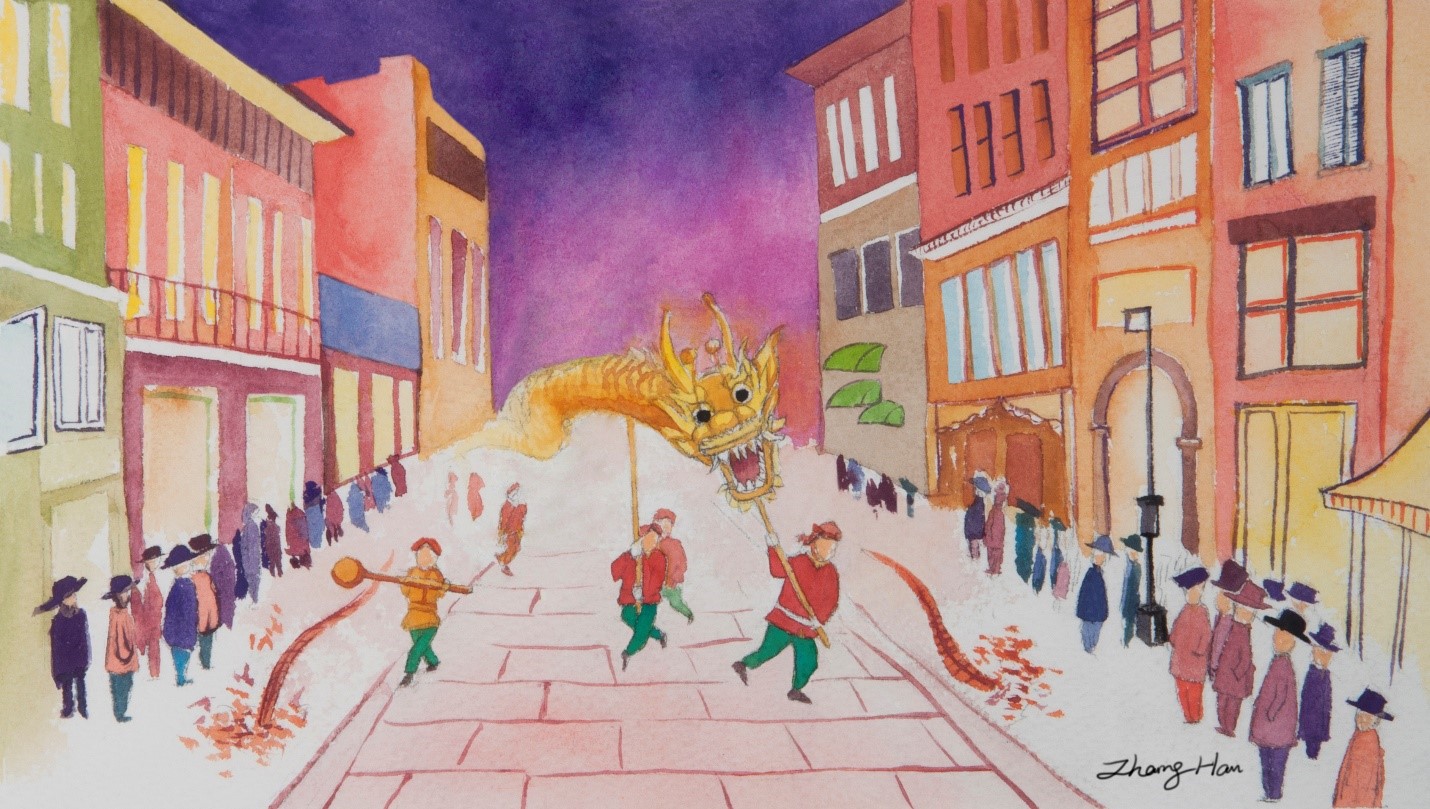 Within a bachelor society, Hoy Lun Chung celebrated Spring Festival at Boston Chinatown in Massachusetts. Zhang Han.
Within a bachelor society, Hoy Lun Chung celebrated Spring Festival at Boston Chinatown in Massachusetts. Zhang Han.At the Imperial Court in Beijing, it was clear to all that something had to be done. It was less clear, however, what exactly that was.
Japanese Imperialism
The emergence of a militarist and nationalist class of Japanese governmental leaders in the late 1800s led to increasingly aggressive imperialist policies to expand Japan’s political and economic sphere of influence to secure access to raw materials, food, and labor. Starting with the First Sino-Japanese War, the Japanese gained control of Taiwan in 1894. In 1905, they won part of Sakhalin Island after a stand-off with Russia. During World War I, they seized Germany’s leased territories in Shandong province and several islands in the Pacific. In 1931, they invaded Manchuria in Northern China, installing a puppet regime with Puyi, the last Qing emperor, at its head. By the end of World War II, Japan had invaded much of Southeast Asia, as well as Hong Kong. Learn more.
Reform or Revolution?
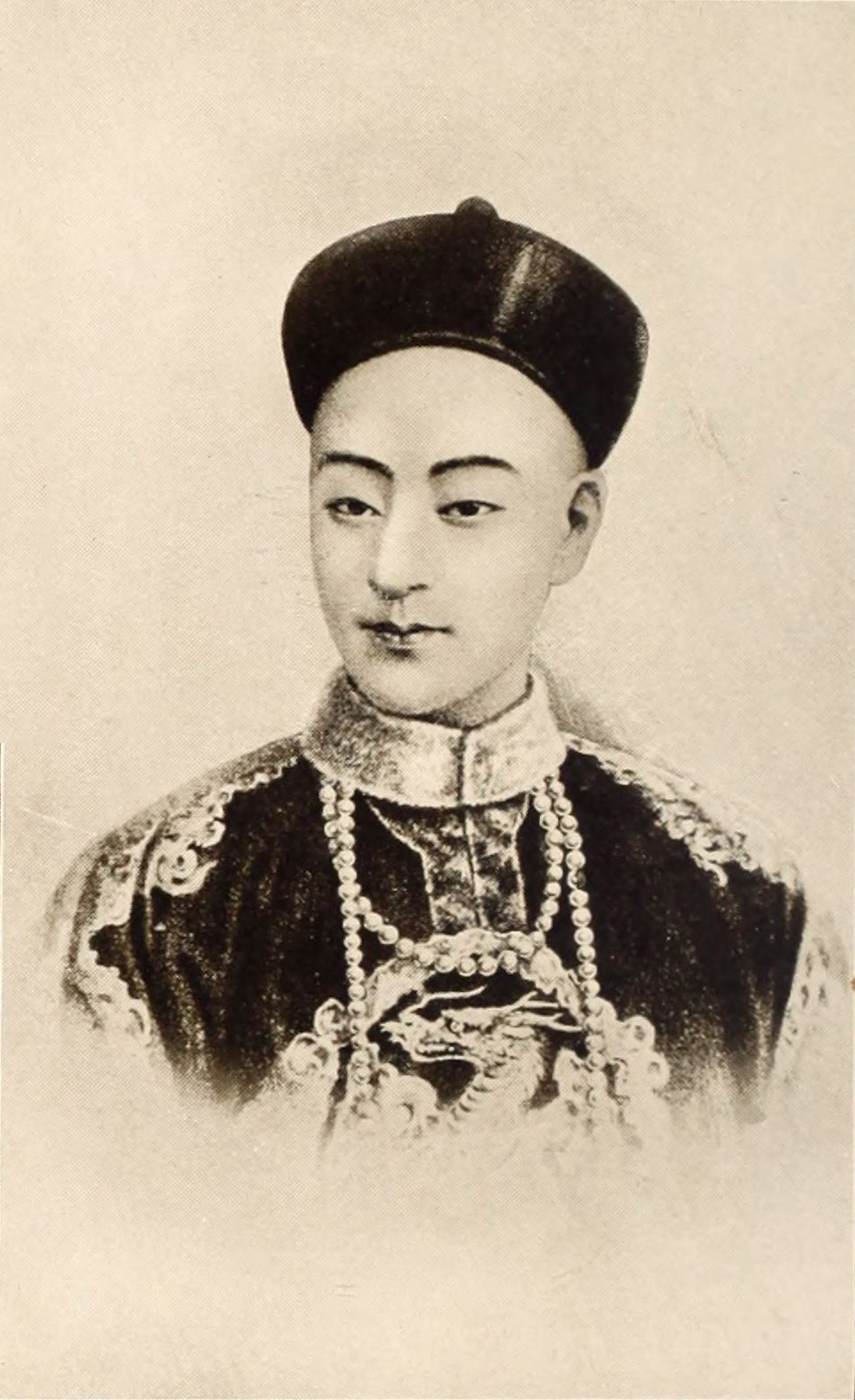 Emperor Guangxu
Emperor GuangxuIn 1898, after China’s embarrassing defeat facing the Japanese, the 27-year-old Guangxu Emperor backed a strong push by progressives in favor of economic and social reforms known as the Hundred Days’ Reform. According to liberal scholar Kang Youwei, developing a modern education system, democratizing China, industrializing the military and economy (on the model of Japan) were all a means for China to “self-strengthen” and achieve institutional and ideological change. The ultimate goal was to transform the government from being an autocracy to becoming a constitutional monarchy.
On the other side of the ring however, stood Empress Dowager Cixi, who controlled the government and, in the end, even emperor Guangxu. The Empress Dowager was on the side of the Manchu conservatives, who feared the reforms meant handing over too much power to the Han Chinese majority. She engineered a coup d’état, reversed the reforms, and placed the Guangxu Emperor under house arrest. The Emperor’s health declined and he was never able to regain his power.
The failure of the reform process resulted in the disillusionment of many educated Chinese, further weakening the Qing government’s legitimacy in the eyes of its own people. Kang Youwei fled China with a price on his head. The trending decline of China continued, as did the reasons for the young men of your Longgangli Zhang clan to leave and search for economic opportunities abroad.
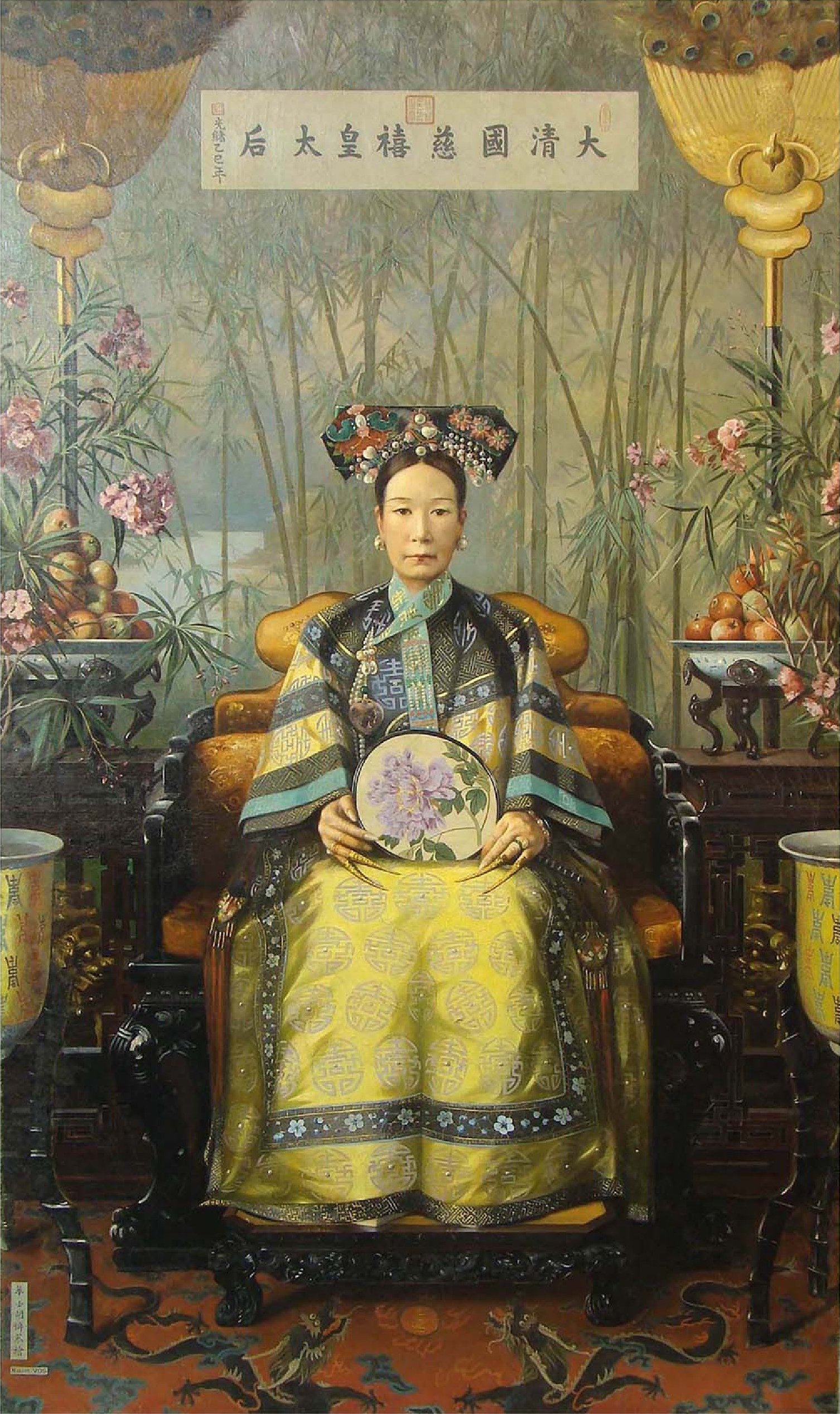 Painting of Empress Cixi by Hubert Vos
Painting of Empress Cixi by Hubert VosEnd of the Imperial Exams
In 1905, when he was 13, Moi Chung saw the official end of the imperial exams, the exams that for two millennia had been the bedrock of China’s education and government systems, and the prime aspiration of so many of his ancestors, such as Zhang Zhe and Zhang Chang. The system had been criticized for stifling creativity, for cultivating officials who did not dare to defy authority, and perhaps most important at the time, criticized for the lack of technical knowledge in China. For more than 60 years, China had been humiliated by foreign powers whose knowledge of engineering, mathematics and applied science left China’s military power far behind. For millennia, the imperial exams had focused solely on Confucian classic writings and recognized commentaries on those classics.
1900-1911: Preparing for the Founding of a Republic
Sun Yatsen’s Fundraising Tour of the World
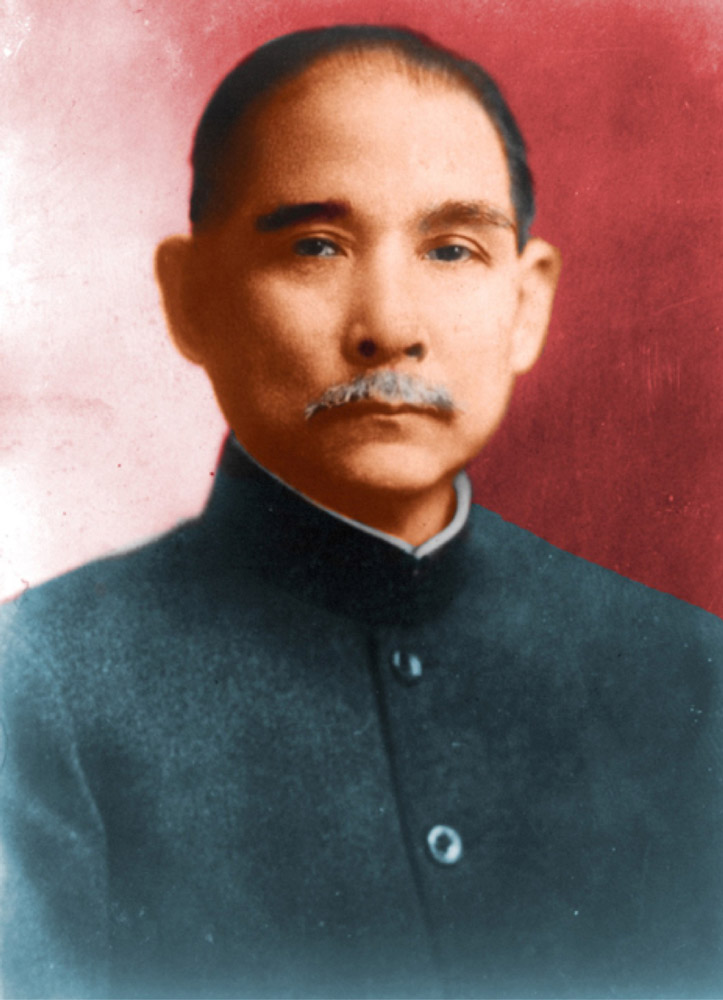 Sun Yatsen, Founding Father of the Chinese Republic
Sun Yatsen, Founding Father of the Chinese RepublicAfter a few years in Hawai’i where he had studied with Protestant missionaries, Sun returned to China to pursue his medical studies. It was in Hong Kong that Sun’s interests and energy turned towards revolution and overthrowing the Qing dynasty, as the Qing struggled to tackle both internal and external pressures. Disenchanted with the Qing’s failed attempts at reform, Sun Yatsen favored a more radical approach, devising a political philosophy that would make China a free, prosperous and powerful nation. This philosophy was called the Three Principles of the People, based on nationalism, democracy, and social welfare.
After a failed uprising in Guangzhou in 1895, he was forced to flee to Japan. There, he founded the Tongmenghui, also known as the United Chinese Alliance, a secret society merging several revolutionary societies dedicated to overthrowing the Qing.
Over the next ten or so years, Sun would travel around the world, from Japan to Europe, the U.S. and Canada, raising money and awareness about the Tongmenghui’s revolutionary efforts.
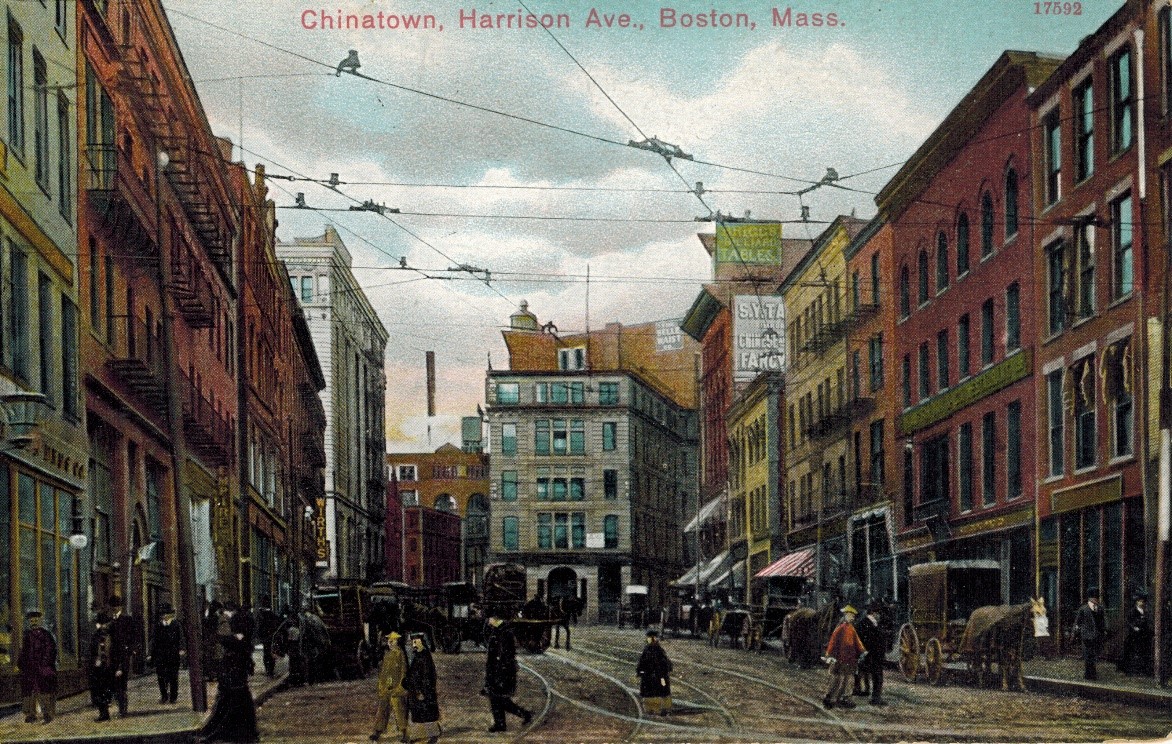 Boston Chinatown
Boston ChinatownSun Yatsen in Boston
Is it possible that Sun Yatsen and Hoy Lun crossed paths in Boston?
We know that Hoy Lun was there approximately between 1891 and 1926. Sun Yatsen visited the capital of Massachussetts on two separate occasions; the first time was in 1904, and Sun stayed for 5 months with the leader of the Chinese Freemasons or Zhigongdang, Situ Meitang / 司徒美堂. The second time was in 1910 as part of Sun’s final fundraising tour of America, when he also established branches of his Tongmenghui secret society in major cities with important overseas Chinese populations such as Boston, New York and Chicago. As he stayed at the Chinese Freemasons’ lodge on Tyler Street, Tyler Town, for both visits, Hoy Lun may well have met Sun, heard him speak at a rally, and/or even donated to his revolutionary cause.
Acceleration of Anti-Qing Uprisings
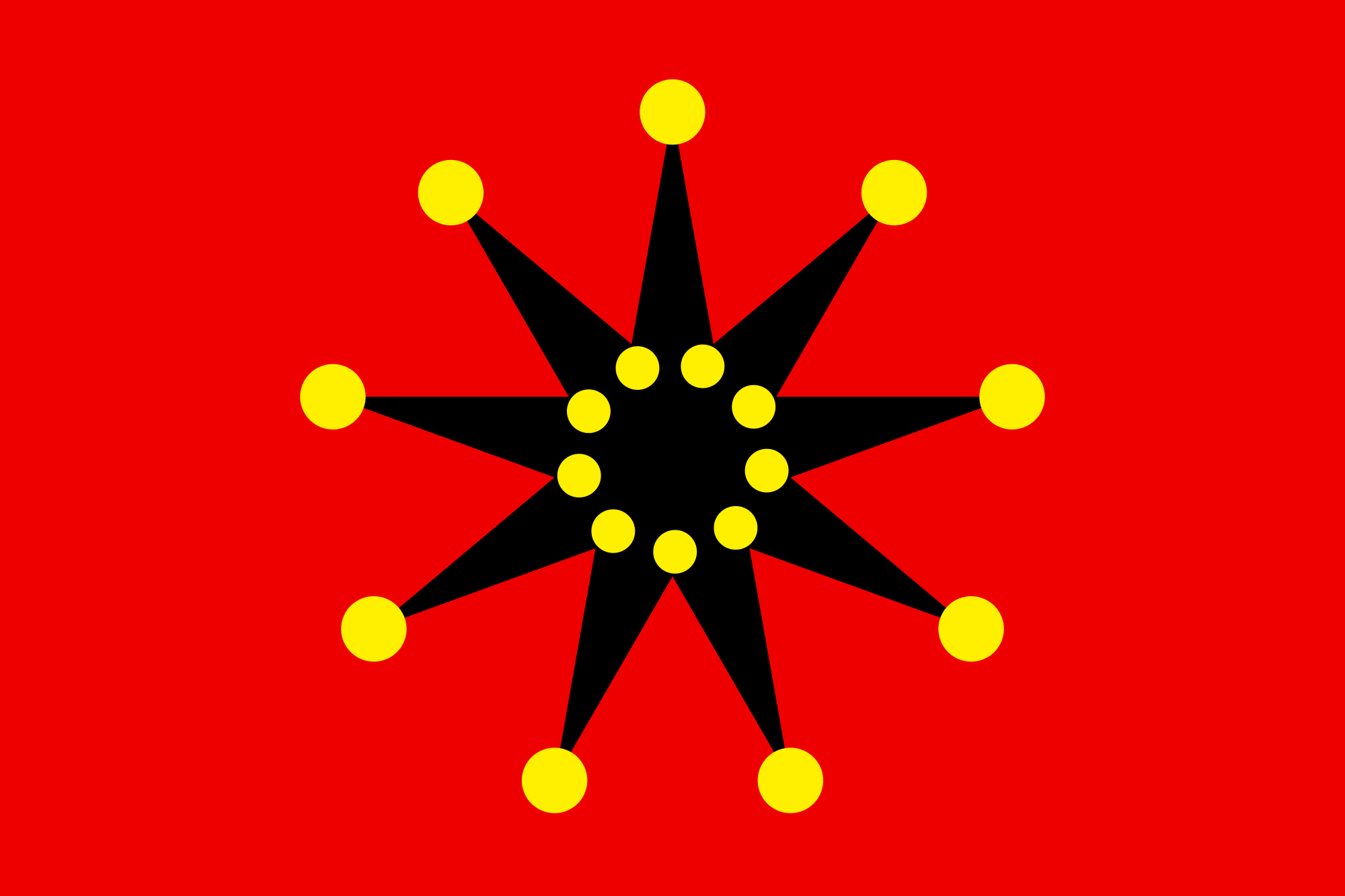 Banner of the Wuchang uprising
Banner of the Wuchang uprisingMeanwhile, between 1895 and 1911, there were no less than 11 anti-Qing uprisings led by the Tongmenghui, including 6 which took place in Guangdong. The last one, called the Huanghuagang Uprising took place in Guangzhou in March 1911, just 160 km away from Longgangli. Revolutionaries attacked the Viceroy Office of Guangdong and Guangxi, but failed to consolidate control over the seat, resulting in around 72 revolutionaries losing their lives. Two Overseas Chinese with ancestry from Kaiping, Li Yannan from Myanmar and Lao Pei from Singapore, were among those killed in clashes with Qing forces. They were later buried in the Huanghuagang Uprising Mausoleum for martyrs in Guangzhou.
Later that year in September, Sun Yatsen was reading the morning papers while on his American fundraising tour in Denver, Colorado, when he stumbled across incredible news: Revolutionary forces had successfully led an uprising in Wuchang, Hubei province.
1911: The Qing Is Dead, Long Live the Republic!
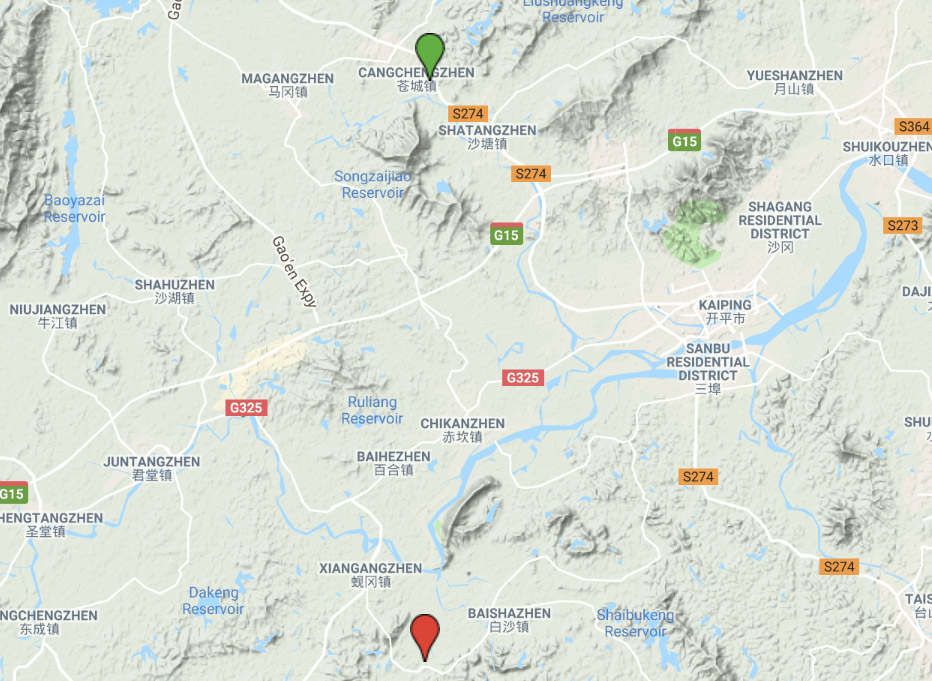 Cangcheng (green) and Longgangli (red)
Cangcheng (green) and Longgangli (red)Following the Wuchang uprising, several other uprisings arose throughout China as part of the beginning of the Xinhai Revolution.
In Kaiping, Wu Shen from Lougang led the revolutionary army and occupied the county town of Cangcheng, just 27 km north of Longgangli. The Qing magistrate of Kaiping county, Zhou Gongjin, then fled with his official stamp, marking the end of the rule of the Qing government in Kaiping.58
The Xinhai Revolution led by Sun Yatsen had just replaced the Qing government in Beijing, and on the first of January, 1912, the Republic of China was born, with Sun as its provisional president. Now, for the first time in more than 2000 years, the Chinese people did not have an emperor. The times they were a-changing.
The success of the Xinhai Revolution relied in large part on the support and donations of overseas Chinese from around the world. In Longgangli, the villagers we interviewed remember many villagers donating funds to Sun Yatsen’s revolutionary activities, including one generous donor called Zhang Chunyi, who had settled in America.59
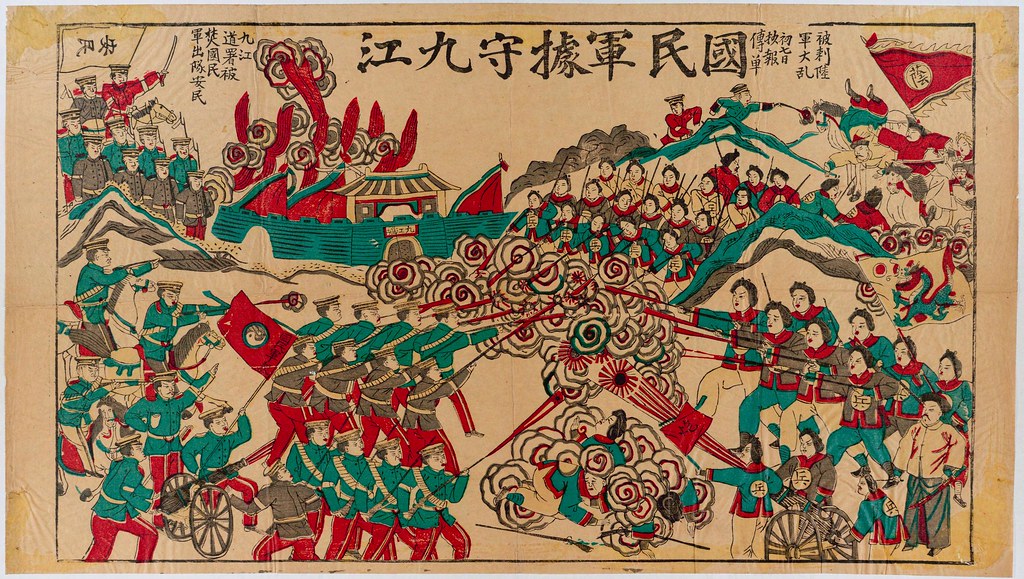 Xinhai Revolution
Xinhai Revolution1912: Moi Chung Leaves in the Wake of a Newborn, Chaotic China
Early 1900s: The Zhangs in Longgangli
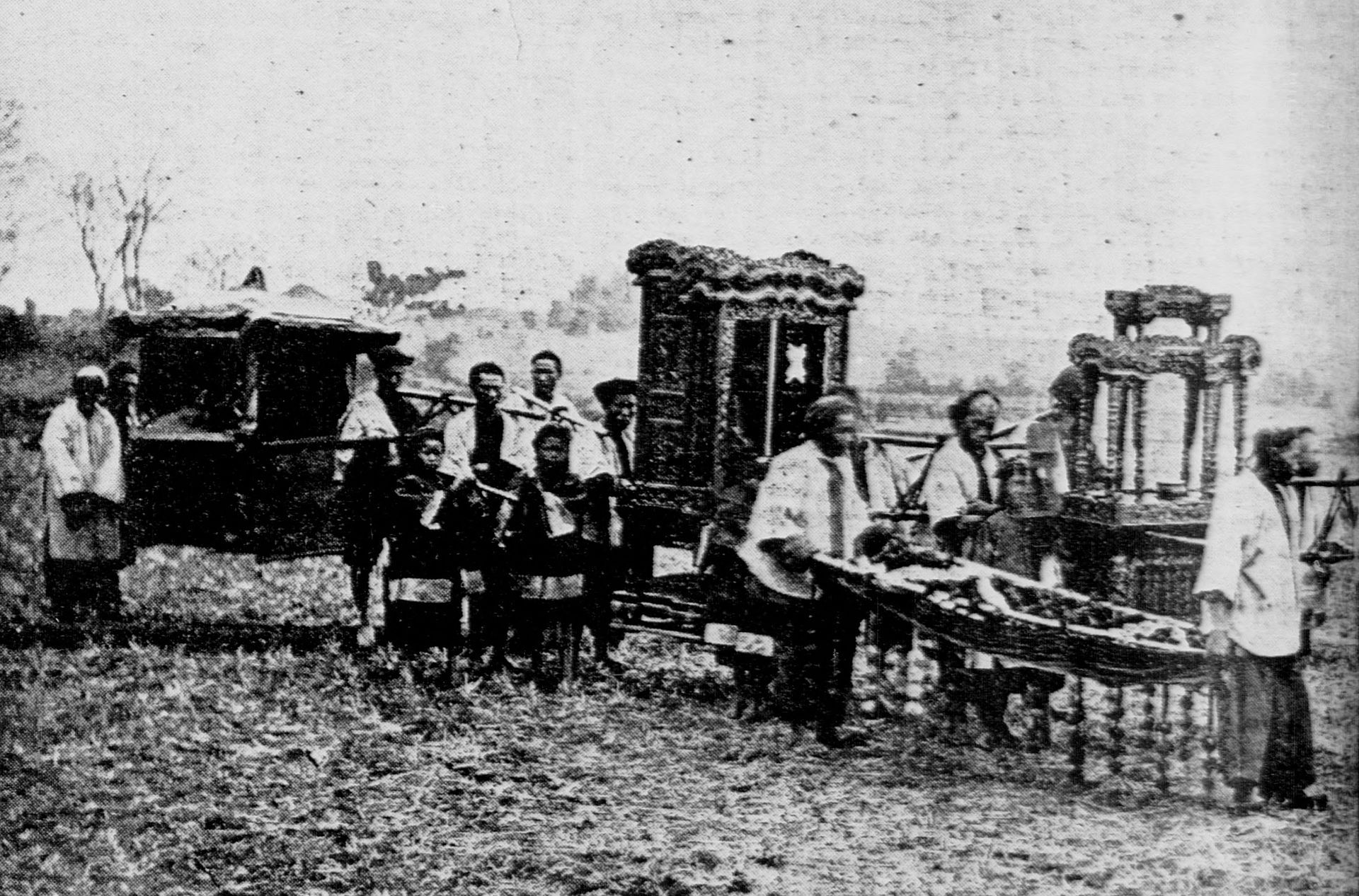 Traditional funeral march, ca. 1900. Wikimedia Commons.
Traditional funeral march, ca. 1900. Wikimedia Commons.Meanwhile, life had gone on in Longgangli. Living standards in rural China had continued to improve, and since 1907, western medicine and traditional Chinese surgeries had been appearing in Dihai, then in Xinchang, Changsha, Chikan, Yueshan, Chishui and other places in Kaiping.60
Moi’s grandfather Bein Yiu had passed away in 1910. His family may have called upon a Buddhist monk or even a Taoist shaman (also known as “Nanwu”) to perform the rites for his funeral ceremony. These rites consisted of a series of complex traditions associated with folk religion, such as lighting incense sticks (to “light up” the path to the underworld); waving a long banner with the deceased person’s name and date of birth (to call the escaped soul back to the body and prevent it from getting lost); washing the body of the deceased with water from the river to cleanse it before its departure; and carrying out a funeral procession led by a shaman or a monk before burying the body in a wooden coffin. The shaman would perform another ritual ceremony before the grave three days after putting the deceased below ground, and once again a month later. After several years had passed, the remains could be unearthed and transferred to an earthen jar.61
Despite the changing times that seemed to point to drastic cultural and political reforms in China, Moi had other plans. Like his father, his grandfather, and his great-grandfather, he aspired to a future in America, the land where everything and anything was possible. So he did exactly what his father and grandfather had done: he got married, and booked his passage across the Pacific the following year.
First Decades of the Republic: Warlords at the Regional Level...
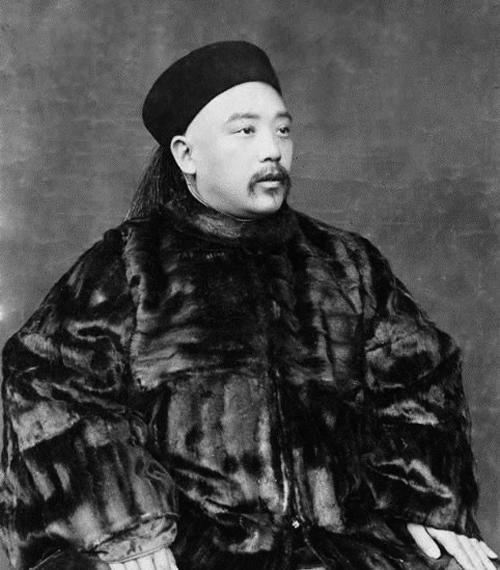 Warlord Yuan Shikai, ca. 1912
Warlord Yuan Shikai, ca. 1912The new China was a fragmented nation dominated by numerous warlords and factions. Sun’s power base was in the south of the country, and in order to reunify China, Sun had made a deal with the commander of the army that controlled the north, Yuan Shikai. The deal was that Yuan Shikai would support Sun in overthrowing the Qing Dynasty and founding a republic. In return, Yuan would become president of the new Republic of China.
After having been president for three years, Yuan declared himself emperor of China in December 1915. Due to the widespread rebellion that this caused in Guangdong and other southern provinces, and the strong protests from his own commanders, Yuan renounced the monarchy only four months later. When Yuan died in June 1916, China was still a politically fractured country.
While Moi Chung was in San Francisco from 1912 to 1917 and then Boston from 1917 to 1921, different warring factions had their armies stationed in the Kaiping towns of Shuikou, Sanbu, Chikan and Cangcheng – all within a 30 km radius of Longgangli. During this period, Kaiping, and especially the Shuikou region, functioned as a major battlefield that saw endless fighting against the backdrop of the “Warlord Era."62
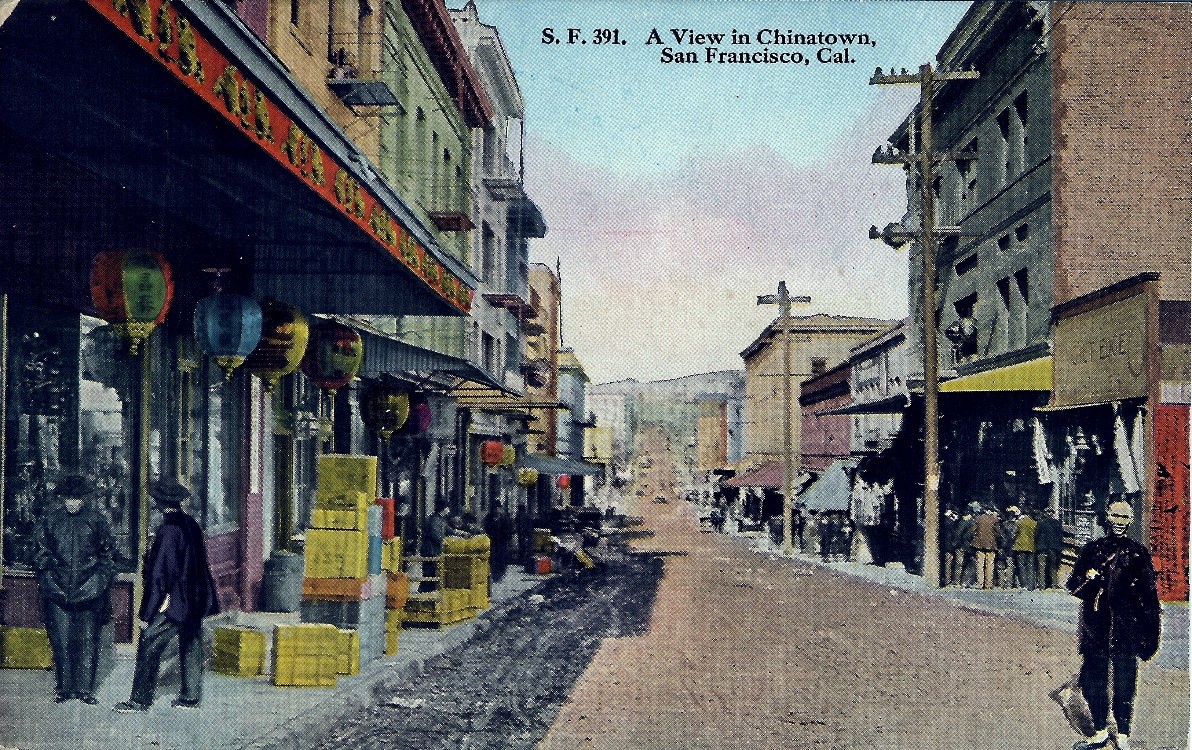 San Francisco Chinatown
San Francisco Chinatown ...and Bandits at the Local Level
At the same time, groups of bandits gathered in the mountainous regions, including Guru in the northeast of Kaiping; Yingbei, Baishuilang, Fushigang, Shuibianzai and Pengcun in the county’s northwest; Tutang in the west; Linglongjing, Shalan and Chongkou in the southwest and Shiliutang in the northern Liangjin Mountains – the formerly barren and inhospitable area that Zhang Chang had transformed into the dynamic area of Shagang, almost 900 years earlier.63
These groups conducted robberies and village raids across the county. As they had their camps and bases in steep, mountainous areas that were hard to find or access, it took the government over ten years to eliminate these bandit groups. Hu Dingnan, the county magistrate of Kaiping was so desperate that he begged locals to donate money to fight the bandits.64
The Diaolou: Defending Chishui and Longgangli from Bandits
Unfortunately, it was the increasing riches sent or brought back to Kaiping by its emigrant population (including the three generations before Moi Chung) that had attracted the interest of bandits near and far. During the first 20 years of Moi’s life, and after he left for America, gangs regularly plundered the villages in his home region of Chishui and often took people captive for ransom. These bandits ranged from river-pirates and “unemployed” soldiers, to former coolies, peddlers, traveling artisans, boatmen, banished villagers, and poor peasants. They were also typically members of local secret societies, more commonly known as “triads” or mafia.
Between 1912 and 1930 there were reports of more than a hundred murders, over a thousand abductions, and 71 major robberies, in addition to the countless thefts of buffalo and other goods in Kaiping. In addition, between 1912 and 1926, eight schools were attacked, leading to the abduction of over a hundred pupils and teachers.65
Because of the need to defend themselves from the bandits, the elders of the Kaiping clans, together with the overseas Chinese, began collecting donations to build countless Diaolou or watchtowers in the vicinity of the villages: fortified multi-storey towers made of stone, brick or concrete, and completely unique to Kaiping.66 While the very first Diaolou had been already built during the Ming Dynasty (1368–1643), also out of protection against banditry, 90% of the over 1,800 Diaolou in Kaiping today were built between 1900 and 1931.
 Kaiping diaolous
Kaiping diaolousOne particularly interesting element about the Diaolou was their architectural mix. Together with traditional Chinese architecture, there were traces of Roman and Greek columns, Mediterranean arches, Turkish domes, Scottish mansions and Mogul Indian manors. This mix was not the result of the influence of Europeans that had gone to China. Instead, it was the result of Chinese emigrants having returned to Kaiping from America, Europe, Hong Kong and Malaysia, bringing back new ideas influenced by overseas architecture.
The upper floors typically acted as living quarters, while lower floors were mainly for defence, with walls much thicker and stronger than normal houses, making it virtually impossible for bandits to break through or set them on fire. Windows were also smaller and protected by iron bars or iron shutters. The main entrances to the Diaolou were protected on the outside by an iron gate and on the inside by an iron door. Both doors and windows could be shut within a minute, making the Diaolou an easily defensible structure.
Meanwhile, Just 20 km North of Longgang, in Tangkou Town...
Xie Weili was born in the United States to Kaipingese parents. After a successful career as a chemist, his father sent him back to China to build a vast and luxurious garden. Xie decided to do some research before beginning this daunting task, so he travelled to Beijing, Suzhou and Hangzhou to study the most exquisite imperial gardens in China. His engineers also sought inspiration from Europe, Japan, and the U.S., so much that the garden is now a perfect mix of eastern and western features. Covering an expanse of 19,600 square meters, it took 10 years to build this vast complex of villas, pavilions, archways, small canals, ponds, aviaries, walkways. It was also an incredibly modern feat of architecture, incorporating materials and features found abroad, such as indoor plumbing. Six yellow villas with green-tiled roofs housed all six clan branches of Xie’s family. A four storey communal watchtower provided refuge during raids from bandits. Learn more.
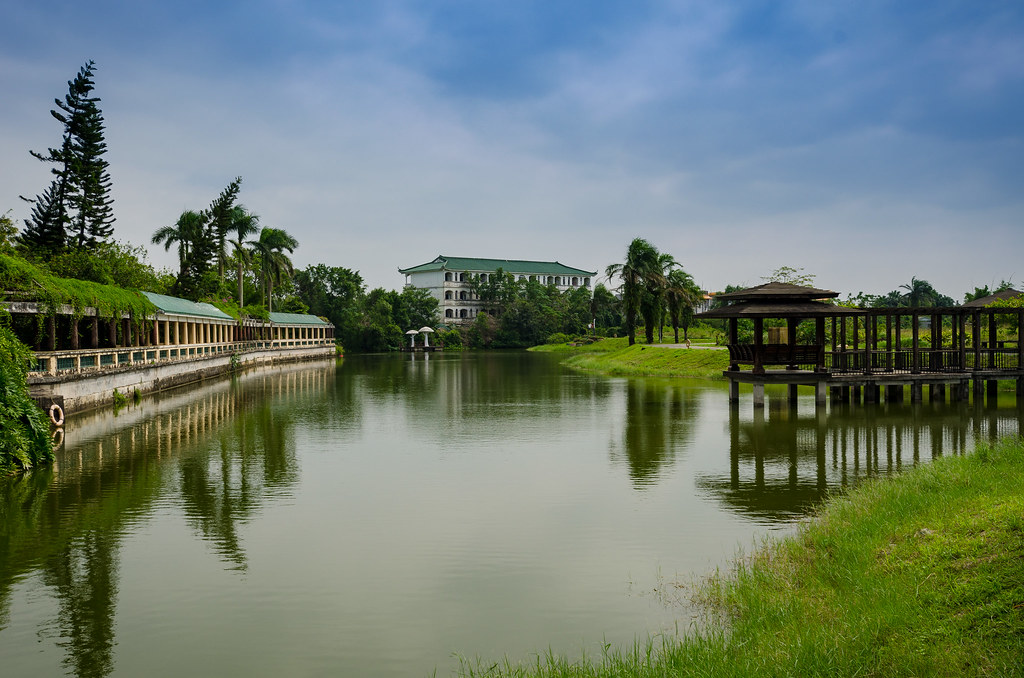 Liyuan Garden, Kaiping
Liyuan Garden, Kaiping1919-1921: May Fourth Movement and China’s Communist Party
Meanwhile in Beijing...
While violent winds, typhoons (and bandits) tore through Kaiping, political developments continued in China. The stipulations in the 1919 Versailles Peace Treaty, which formally ended the First World War, treated the Chinese unfairly in order to appease the Japanese. It was yet another “unequal treaty” that continued to humiliate China while benefitting other powers. Two years earlier, in 1917, China had declared war on Germany and Austria-Hungary, joining the allies in the hope of recovering Shandong province, which it had lost to Germany before the war. However, instead of giving the province back to China, the allied forces in Versailles officially handed it to the Japanese.
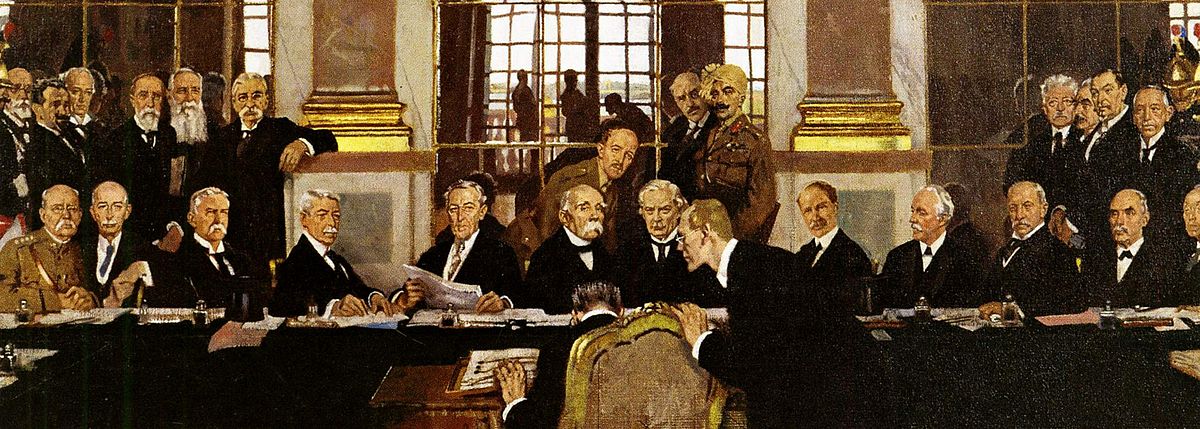 Signing of the Treaty of Versailles in the Hall of Mirrors, 1919
Signing of the Treaty of Versailles in the Hall of Mirrors, 1919Ever since the 1842 Nanjing Treaty, the Chinese had been feeling increasingly frustrated with the growing influence of foreign power in China. The unfair treatment at Versailles was the final straw, triggering the increasingly nationalistic emerging middle class and cultural leader to launch the "New Culture Movement" in 1919. This movement believed that traditional Chinese values were responsible for the political weakness of the nation. This created the rather peculiar situation where a Chinese nationalist movement called for a rejection of many traditional Chinese values and for the selective adoption of Western ideals of science and democracy.
May 4th, 1919
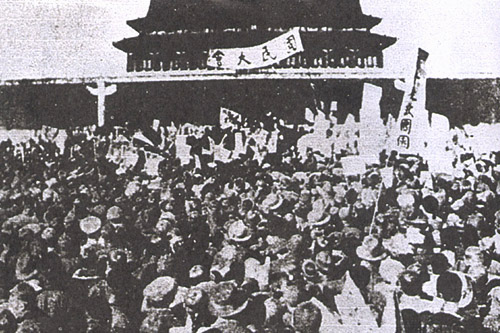 May Fourth 1919 on Tiananmen Square
May Fourth 1919 on Tiananmen SquareOn the afternoon of May 4, 1919, over 3000 students gathered together on Tiananmen Square in Beijing and fervently demonstrated against the “spineless” Chinese government in what is now known as the “May Fourth Movement.” The May Fourth Movement sparked widespread national protests advocating a path to true Chinese modernization, democracy, and “people’s power,” and formed the seeds for the foundation of China’s Communist Party in 1921.
China’s Communist Party
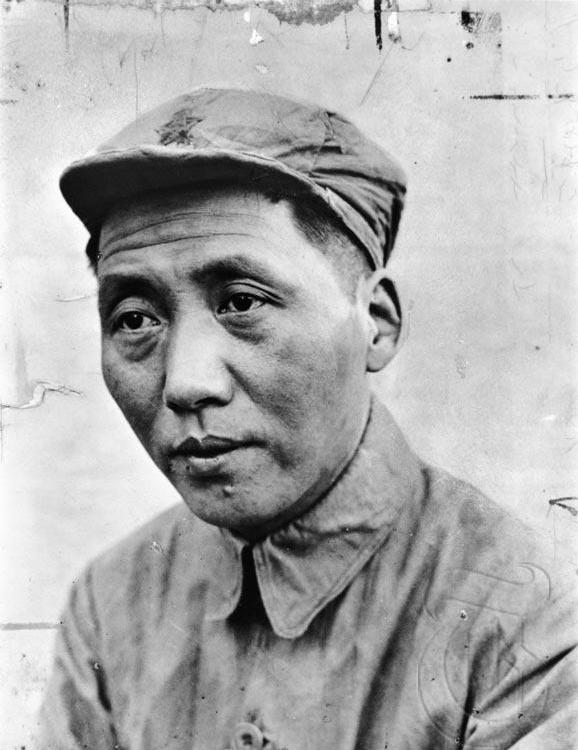 Young Mao Zedong
Young Mao ZedongWhile 29-year-old Moi Chung was toiling away in a Boston Chop Suey restaurant, the New Culture Movement in Beijing attracted many young progressive intellectuals eager to debate issues such as how to build a strong and modern China, all the while preserving its “Chinese-ness” in a world of competing nations.
28-year-old Mao Zedong, recently arrived from Hunan province, took an interest in western liberal culture and politics, in particular Marxism-Leninism. The successful Bolshevik Revolution of 1917 proved an inspiring anti-western, anti-imperialist model capable of bringing revolution to a backward country such as China, and with the help of the COMINTERN (the Russian-led organization to promote communist revolution throughout the world), the Chinese Communist Party was founded as a secret, exclusive party in July 1921.
1921: Moi Chung Returns and Marries Cun Chuen Wong
Back to the Motherland
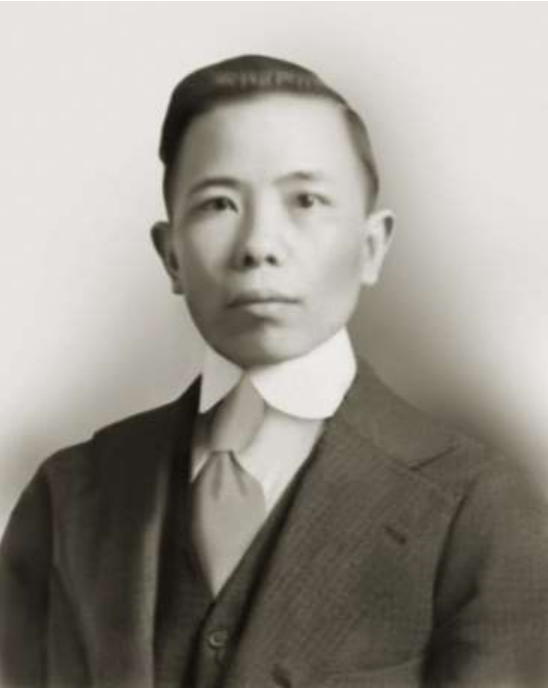 Moi Chung
Moi ChungThat same year, 1921, Moi Chung decides to return to Longgangli. If he arrived via the port of Changsha in Kaiping, some 30.4 km northeast of Longgangli, he would have seen that the port already had electricity. After two private electricity companies established themselves respectively in Changsha and Chikan, in 1928 the state-funded Guangyuan Mingji Electric Light Company moved in to Shuikou, 14 km downstream on the Tan river.67
While it is unclear what happened to his first wife, Kai Leung, that year he married his second wife, Cun Chuen Wong, aged 27. Their child, your father Gim Suey Chong, was born the following year, 1922.68 The following is a description of your grandparents’ wedding if that wedding had proceeded in accordance with local Kaiping marriage traditions.69
The (Likely) Wedding of Moi Chung and Cun Chuen Wong
While the average marrying age in Longgangli for girls was around 14, your grandmother had already reached the remarkable age of 27 when she married your grandfather; supposedly, she had not been married before.
Your grandparents’ wedding would have been contracted through a matchmaker, who will have compared Moi Chung and Cun Chuen Wong’s birthdates, zodiac signs and family backgrounds before organizing a blind date. The blind dates was by no means a private affair, but rather surrounded by family on both sides. Your grandparents will not have spoken to each other on “their” date, besides demonstrating they did not have a speech impediment by saying “Mum, let’s go...” at the end of the date.
Following the date, your grandmother’s family sent cash and gifts to your grandfather’s family. Moi Chung’s family then chose an auspicious day to send back similar tokens, indicating that the engagement was now final. In the lead-up to the wedding, your grandmother stayed at home with her sisters and/or other female relatives, regularly singing lamentations that conveyed her gratitude to her parents.
On the morning of the wedding day, Moi Chung sat on a dustpan containing some grains, some coppers coins and wooden sticks. In the absence of Hoy Lun, an uncle would have combed him while singing blessings; this was to ensure Moi Chung would have sons. Then, with a crown of red flowers on his head, Moi Chung walked to your grandmother’s village to pick her up in a sedan chain and bring her to his home. Your grand-aunts and other relatives accompanied her, showering her with grain and rice for good luck and prosperity.
Arriving at Moi Chung’s village of Longgangli, several women carried Cun Chuen Wong flat on her back and dropped her off in front of your grandfather’s house. A long and solemn ceremony followed, during which they bowed to their (i.e. Moi Chung’s) parents, to their ancestors, and finally to each other. After the wedding banquet, young children climbed up the bed to scramble for candies, oranges and candied rice puffs thrown by the women.
Moi Chung did not stay long after the festivities. Once his husbandly duties were accomplished, he went back to the U.S. He would not see his son for another 9 years, or his wife Cun Chuen for a staggering 43 years.
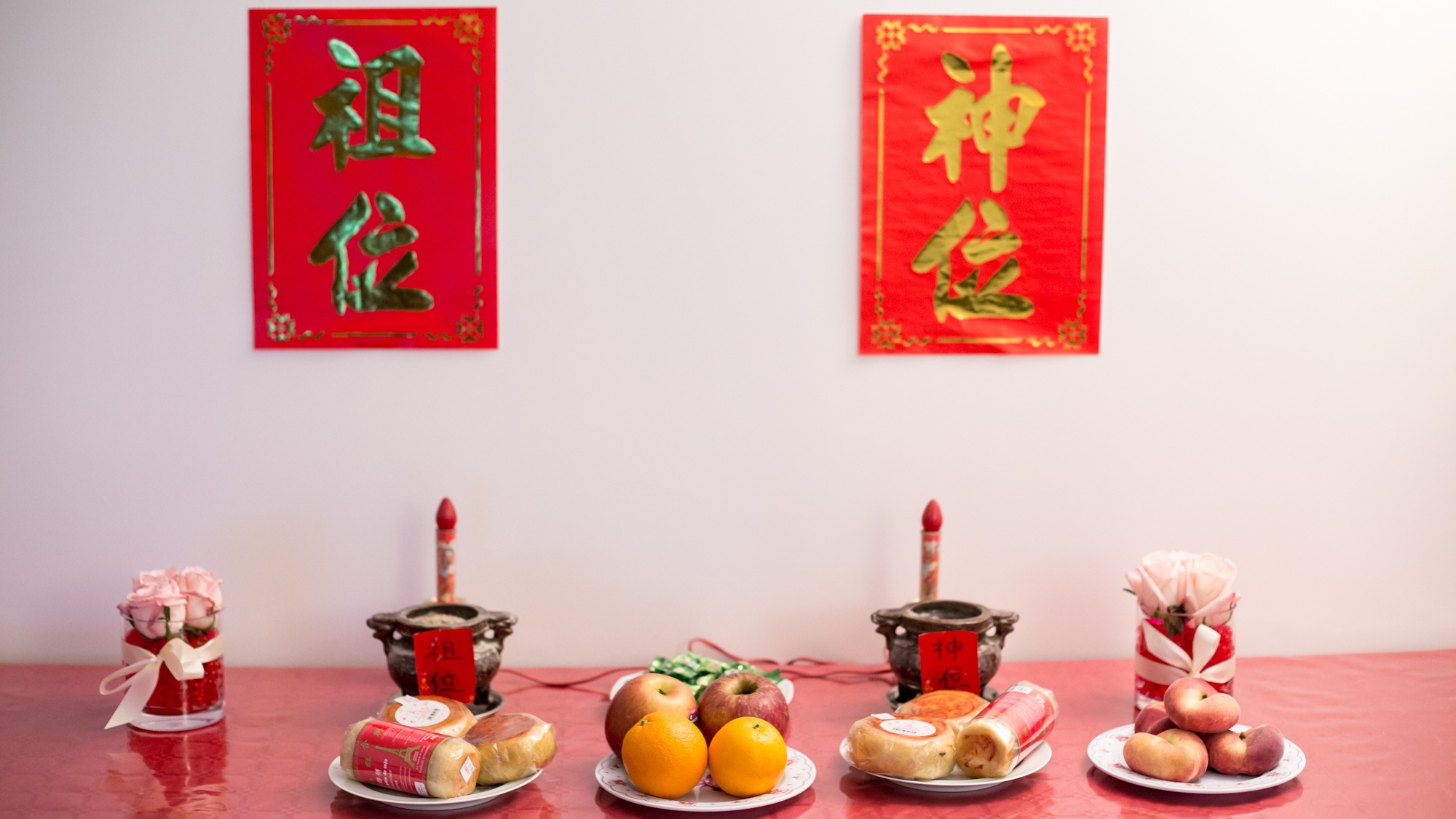 Traditional food offerings at a Chinese wedding
Traditional food offerings at a Chinese wedding1926: Hoy Lun Returns to Longgangli, Civil War Starts
Coming Home with a Splash
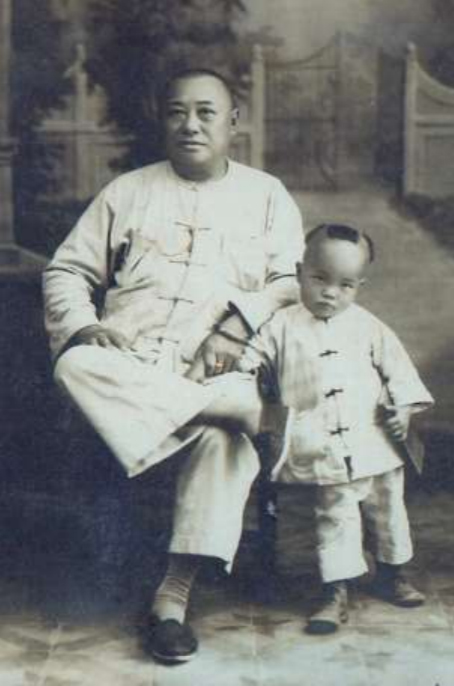 Hoy Lun Chung and Gim Suey Chong
Hoy Lun Chung and Gim Suey ChongWhen Hoy Lun made his grand return to Longgangli in 1926, the story goes that he wanted to buy properties and do business in Guangzhou, but his wife, Ms. Wang, did not want him so far from the village. Instead, he built houses in Longgangli, and bought a shop in Baisha Market, Taishan, which perhaps even his daughter-in-law, Cun Chuen, would later visit on her regular market trips.
As a respectable and prominent member of his local community, Hoy Lun was quickly nominated as village leader by his peers. In those days, the position of village leader was not an officially recognized or government appointed role; instead, villagers would choose the most prestigious, educated, and/or influential person in the village. His tasks would have included dealing with tax collections and turning over payments to the government; settling disputes between villagers, and maintaining the general order in Longgangli.
To this day, locals hold your family in high esteem. In particular, not one but several of your ancestors were able to return home in a row after making money abroad; this was a great rarity considering the dangers of working on sites such as the Transcontinental Railroads.
Gim Suey was 4 years old when his grandfather returned; it was a nice change from being in a village full of women, mostly wives of men who’d gone overseas. Thanks to Hoy Lun’s fortune, he never wanted for anything as he grew up.
Market Days
As your family’s house was located right by the path leaving Longgangli, every 5th and 10th day of the month in the Lunar Calendar, your grandmother Cun Chuen would pop out and walk 6 km to Baisha Market. There, she did her groceries, had a quick meal, and chatted with her relatives and friends from her hometown in Gongbian.
Typical produce on sale included vegetables, tea, rice, wine, chicken, pork, fish, beans; there, one could also buy cloth for sewing, paper, firewood, brooms and pans. The market could serve up to 50 villages in the surrounding area, making it a real bustling hub of social interaction, gossip, and catching up on the news.
1920-1927: Educational Reforms Ripple in Guangdong
Instilled with ideals from the May Fourth Movement, Guangdong introduced far-reaching educational reforms from 1920 to 1923. In 1921, around the time of Gim Suey’s birth, Guangdong had approximately three million children of school-going age. Unfortunately, only one in ten of these children actually had the means to go to school.
Guangdong was the first province in modern China to attempt to fulfil the ideal of “popular education” and design a system of compulsory and free education.70 Accordingly, all children in Guangdong, boys and girls, were to receive a mandatory six years of continuous and free education, starting at the age of seven. The newly established six-year curriculum for Guangdong primary schools included the following subjects:
- Morality (moral principles and the basics of the Republic's legal system)
- Chinese composition
- Mathematics
- Handicraft
- Story books
- Music (singing)
- Gymmnastics
- Science (addressing animals, plants, minerals, physical and chemical phenomena)
- History
- Geography
- Mandarin (starting in the fourth year)
- English (starting in the fifth year)
Nevertheless, Sun Yatsen, who had been a strong advocate against the May Fourth Movement, worked to rewind the Guangdong educational reforms when he returned to power after 1924. By 1927, Sun had re-organized his Kuomintang (KMT) Party along the lines of the Russian model, and had substituted an independent educational system that was free from political interference for an education system tightly controlled by the KMT, adhering to a rigid educational methodology with no room for criticism or independent thinking. Unfortunately, as Gim Suey turned seven in 1929, he missed going to one of the most open and progressive forms of education that (arguably) China has ever had, up until this day, by just a few years.
Sun Yatsen and the Northern Expedition
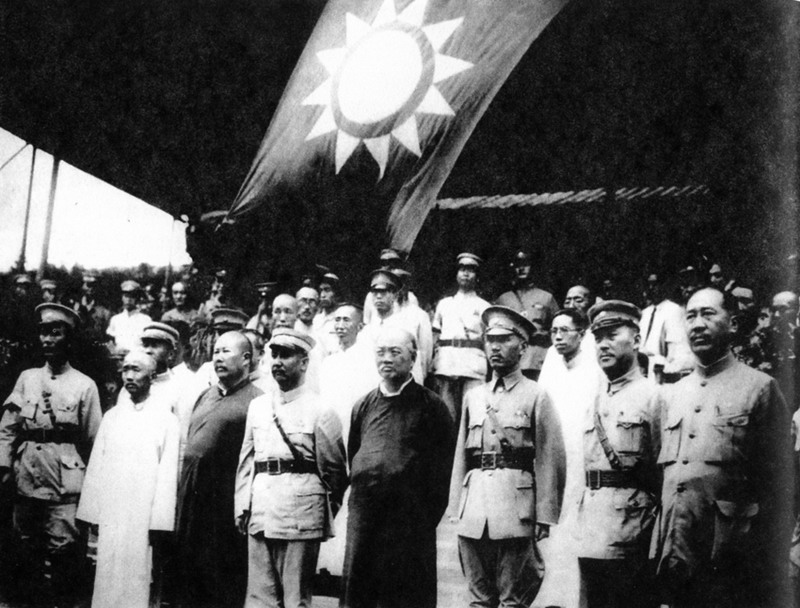 Kuomintang leaders pay homage to the Sun Yat-sen Mausoleum in Beijing, 1928.
Kuomintang leaders pay homage to the Sun Yat-sen Mausoleum in Beijing, 1928.With China divided under many military leaders and no central government, and a general populace sick and tired of being pushed around by foreign powers, Sun saw that the times were problematic. He started a self-proclaimed military government in Guangzhou and planned a national military conquest from his base in the south. The military campaign was termed “the Northern Expedition.”
To implement his Northern Expedition, he formed an alliance between the Chinese Nationalist Party or Kuomintang (KMT), founded by his friends at the Tongmenghui, and the relatively young Communist Party of China (CPC) in 1924. With the Soviet’s help, he now had enough military backing for his national military campaign, and had started to create a loyal officer corps to rid the KMT of its dependence on unreliable and opportunistic southern generals, set up the Whampoa Military Academy near Guangzhou and promoted Chiang Kai-shek as the commander of the National Revolutionary Army.
Unfortunately, Sun Yatsen never got to live to see a proper execution of his Northern Expedition as he succumbed to cancer in March 1925.
1927-1937: Civil War between the CCP and KMT
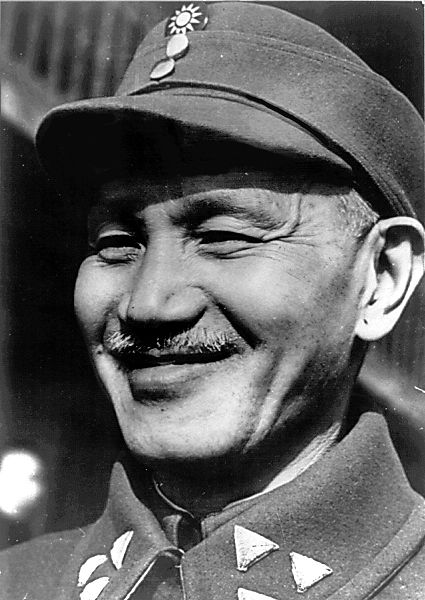 Chiang Kai-shek
Chiang Kai-shekAfter Sun Yatsen’s death, the KMT split into left and right-wing movements, and CPC-KMT relations began to sour. Both claimed to be the true heirs of Sun Yatsen’s revolutionary efforts. By then, most of eastern China was under the control of the KMT, with the capital in Nanjing. Fighting broke out in 1927 when Chiang Kai-shek turned on the Communists, launching a bloody purge of Communists and their sympathizers in Shanghai. The CPC decided to take power by force, sending their Red Army southwards in an attack on Guangdong.
The CPC initiated several peasant uprisings, including one in Guangzhou in late 1927 that was quickly quashed by the KMT. Peasant uprisings continued into the 1930s. After the Guangzhou insurrection, a general named Chen Jitang gained uncontested control of Guangdong. He further consolidated his position by strengthening his military forces and allying himself with Chiang's political foes, which had established a rival Kuomintang group in Guangzhou in 1931 to challenge the Nanjing government. Chen became the dominant figure in the group and was known by the nickname Nantian Wang, “King of the Southern Heavens."71
General Chen expanded his military forces to 150,000. He was also in command of the Guangdong Air Force, the strength of which rivaled that of the Nanjing government. He also sought to develop the economy as a firm foundation for his power, by encouraging the building of modern industrial plants, many of which were helped by contributions and investments from Guangdong emigrants abroad. A number of Chinese from North America also served in the Guangdong Air force.
1932: Gim Suey Chong Leaves for America
Number Five...
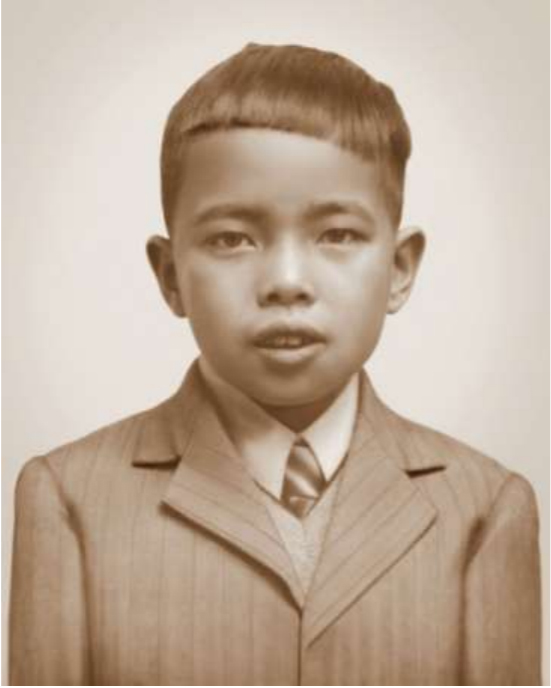 Your father Gim Suey Chong, 1932
Your father Gim Suey Chong, 1932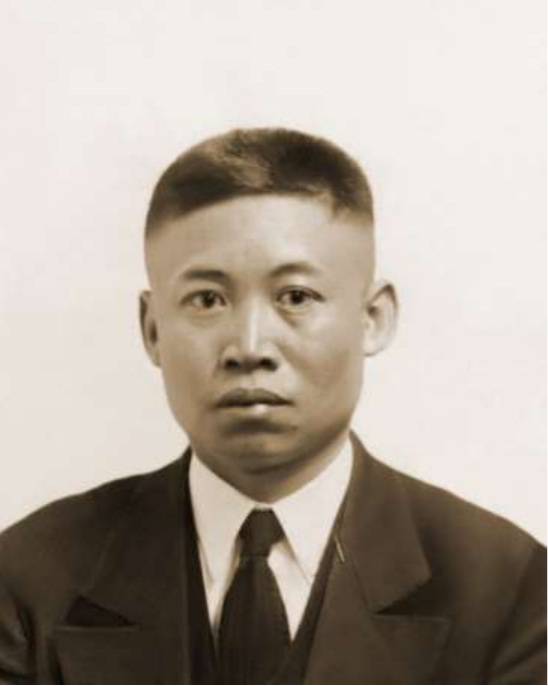 Your great-uncle Quock Hung Chong, your father's "Paper Father"
Your great-uncle Quock Hung Chong, your father's "Paper Father"As if the civil war and local power-hungry warlords weren’t enough to worry about, a disastrous typhoon wrecked Kaiping in 1929. The devastation and impending dangers must have been too much to bear for Moi Chung, who sends for his young son to join him in the U.S.
And so it was that in 1932, your father travelled to the Port of Boston as the paper son of his uncle Quock Hung Chong, a.k.a Zhang Peizhou. He lived and studied at the Imperial Restaurant, a Chop Suey house, at Central Square in Cambridge, where Moi Chung was partner and manager.
The Chinese Exclusion Act was still very much in sway, but the San Francisco earthquake of 1906 created a new opportunity for young Chinese to apply for citizenship, as hundreds of public birth certificates had been destroyed in the fires that ensued. Chinese men who were in the U.S. could claim they were born there, while others with U.S. citizenship claimed that their wives in China had given birth to a child, making the child eligible to U.S. citizenship, and for which they could receive a specific document stating the child’s eligibility. These documents could then be used by the men’s actual sons, their neighbours’, as well as strangers. The boys and young men that arrived were hence called “paper sons.”
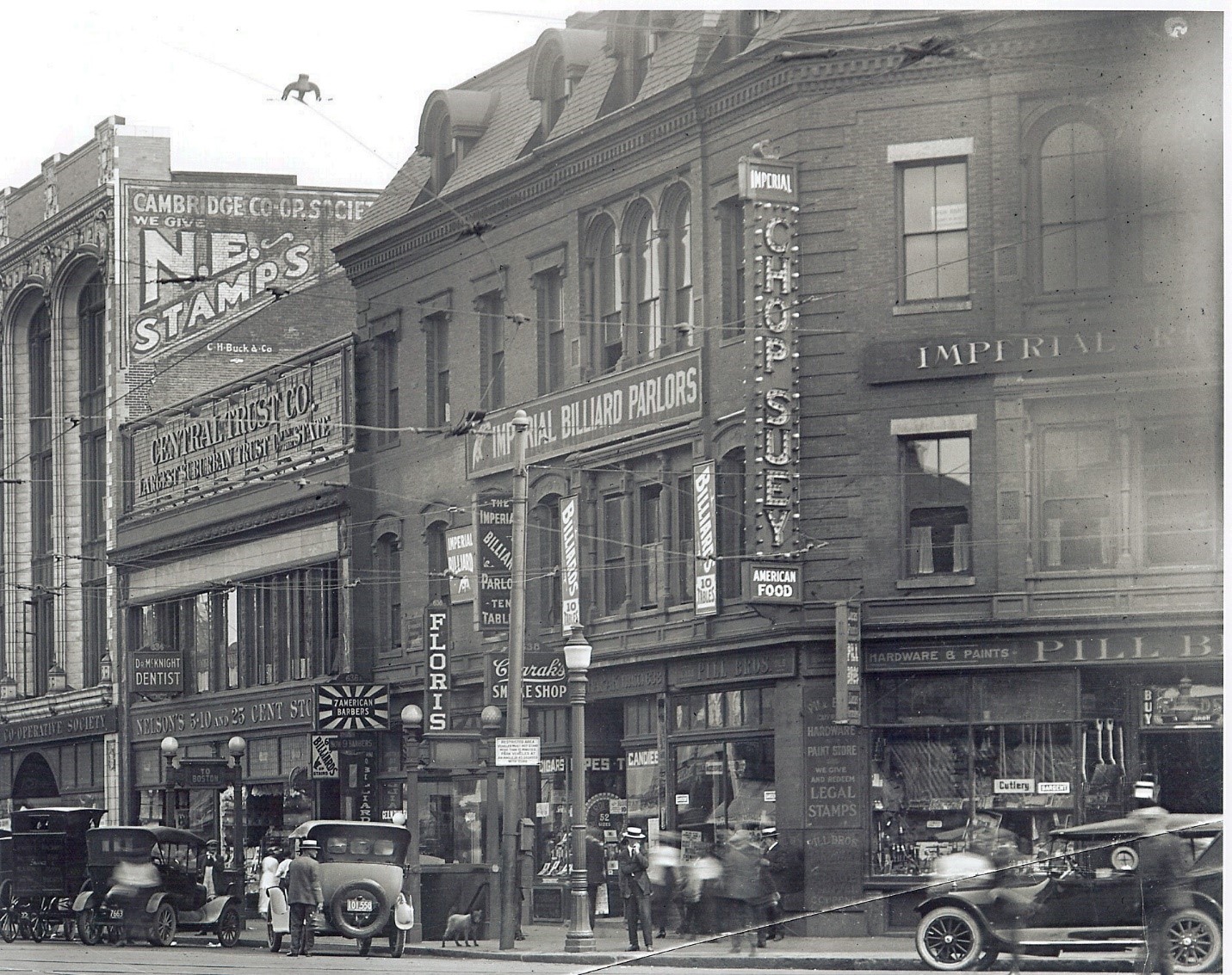 Imperial Restaurant at Central Square in Cambridge
Imperial Restaurant at Central Square in Cambridge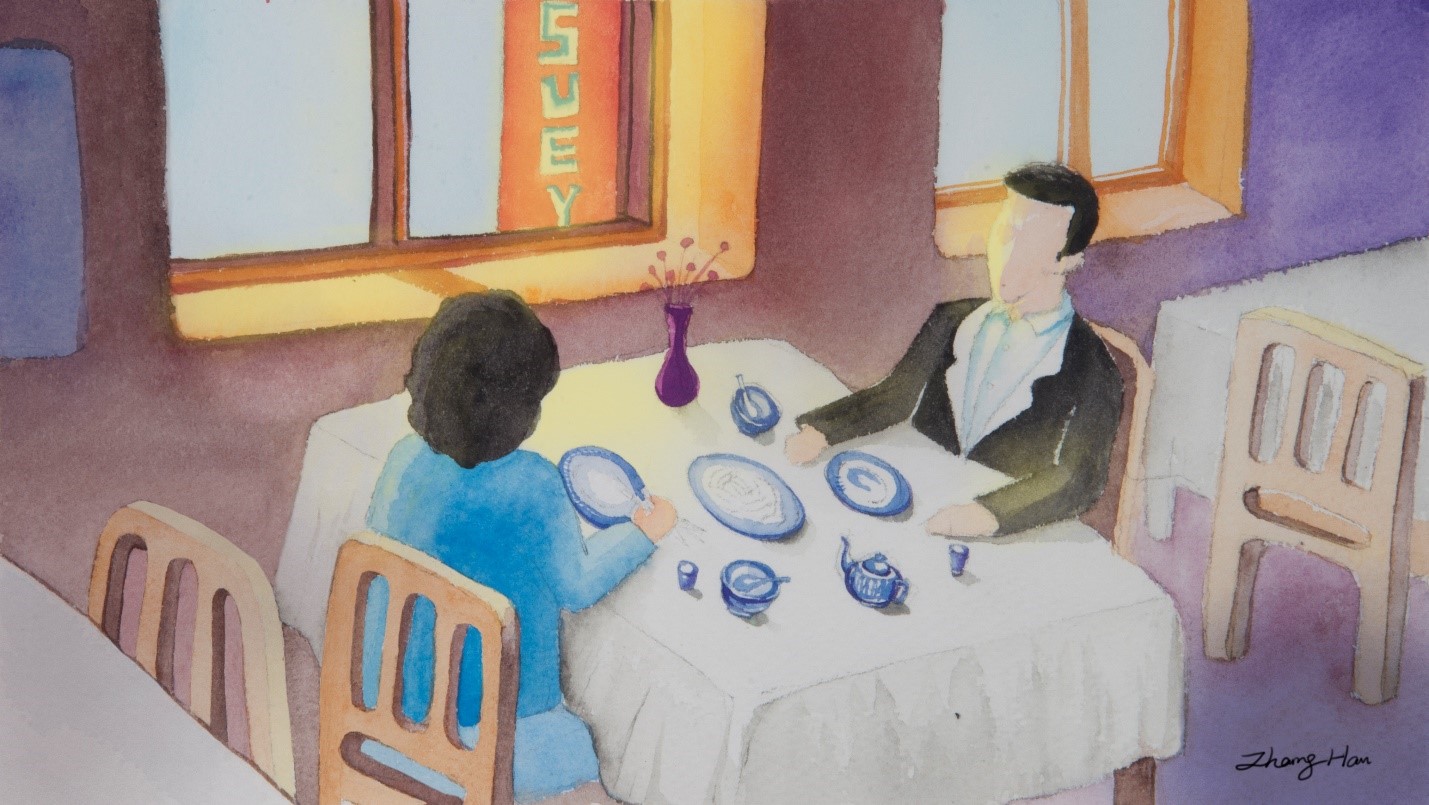 At Central Square of Cambridge in Massachusetts, Moi Chung managed the Imperial Restaurant, a high-class Chop Suey house. Zhang Han.
At Central Square of Cambridge in Massachusetts, Moi Chung managed the Imperial Restaurant, a high-class Chop Suey house. Zhang Han.Chinese Exclusion Act (1882-1940)
During the 1850s and 1860s, the Chinese were mostly welcomed in the U.S. as much needed physical labor. However, the tide turned with the economic depression of the 1870s, which left many blaming the Chinese for taking away American jobs. California labor unions and newspapers started an anti-Chinese movement that spread through the country and made its way to Congress.
In 1882, Congress passed the first Chinese Exclusion Act: the first time in history that the U.S. restricted immigration on the basis of nationality or race. Canada and Australia passed similar discrimination acts to stop Chinese laborers entering their territories. It wasn’t until the 1940s that these acts were finally repealed.
“Piglet Papers”
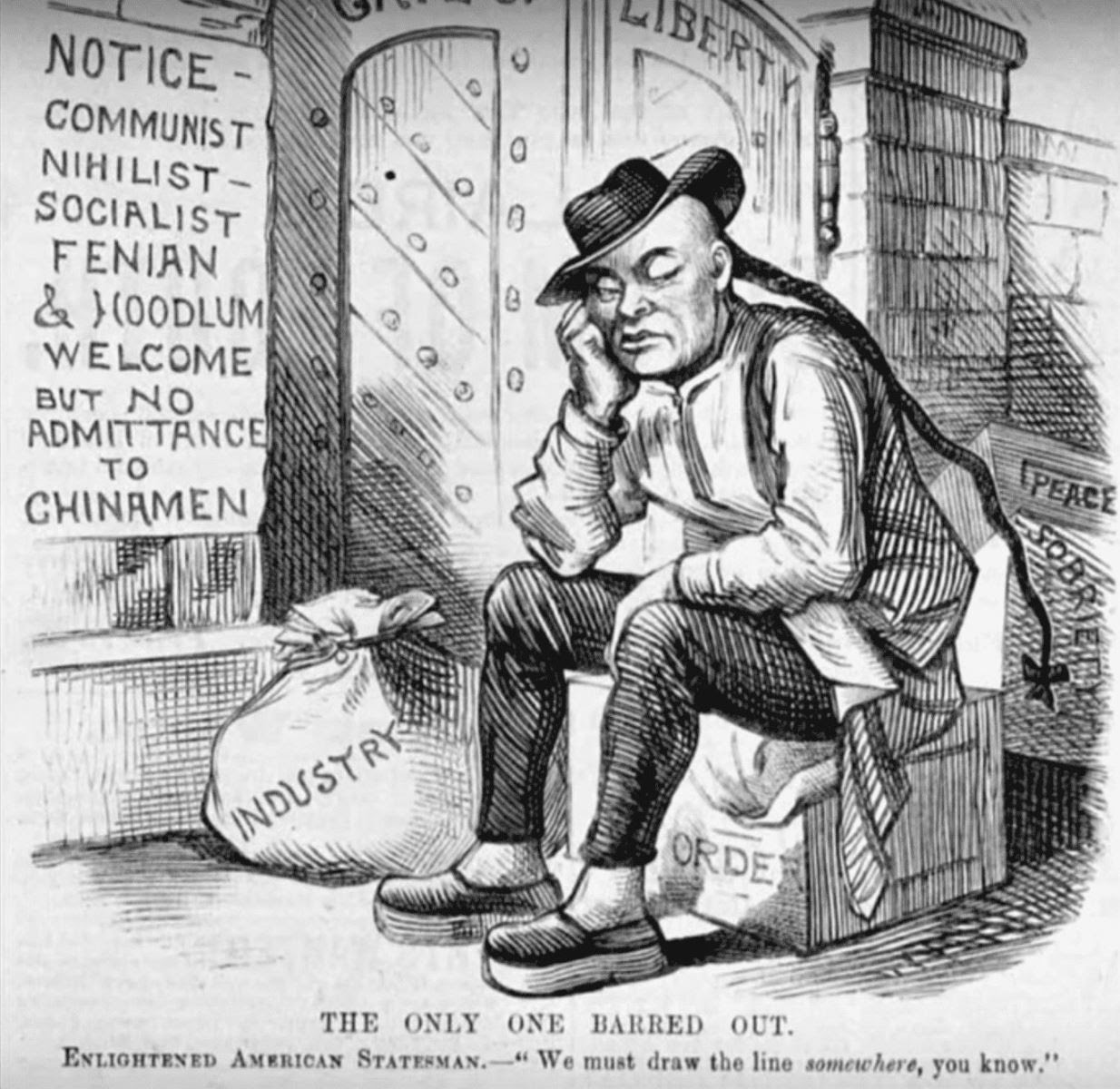 “The Only One Barred Out.” Caricature from Frank Leslie’s illustrated paper, 1882. Wikimedia Commons.
“The Only One Barred Out.” Caricature from Frank Leslie’s illustrated paper, 1882. Wikimedia Commons.Probably because Moi Chung had not applied for the document, he asked his brother Quock Hung Chong, to act as Gim Suey’s paper father. To truly enforce the Chinese Exclusion Act in the wake of the San Francisco fires, the U.S. government created an immigration Station on Angel Island, nicknamed “the Ellis Island of the West,” located in San Francisco Bay.
Between 1910 and 1940, up to 175,000 Chinese wanting to enter the US were detained and interrogated, and then either approved or denied access at Angel Island. The countless interrogations about where you were from, who your family was, what each of them did, were grueling, and Gim Suey will have had to prepare for weeks, perhaps even months, in advance. Sometimes, detainees were asked to state the exact number of houses in their village, and so-called relatives were called in to corroborate their statements. Language and translation mistakes further added to the torment. One immigrant recounted: “When we arrived, they locked us up like criminals in compartments like the cages at the zoo.”
Local villagers still commonly refer to the documentation of paper sons as “piglet papers.” This is probably due to the fact that the word “paper” and “piglet” sound almost identical in Taishanese. To them, the entire practice was like trading and selling piglets; everyone wanted to buy the piglets born and cooked over there, across the ocean, and nobody wanted those that were born and bred in China.
1937-1945: Cun Chuen Wong and the Second Sino-Japanese War
Your Grandmother Stays Behind in Longgangli
Your grandmother Cun Chuen could not have known then, as she was waving goodbye to her only son, that she would not see him for another 34 years – by which time he had become a grown adult with a family of his own, and she an old woman.
When an incident involving Chinese and Japanese troops escalated into a battle, the CPC and the KMT were forced to take a break from fighting each other to repel invading Japanese imperial armies. However, their collaboration was only nominal; Chiang believed the CPC was a much greater threat to China than the Japanese, famously saying "the Japanese are a disease of the skin, the Communists are a disease of the heart."
In late October 1938, the Japanese invaded Guangzhou. Due to the strategic placement of Guangdong, and to prevent China from importing weapons, they proceeded to occupy various places along the Guangdong coastline, including the wider region of Kaiping. Hundreds of Kaipingese, including locals from Longgangli, fled to the British foreign concessions of Hong Kong and Macau. Hong Kong especially became a temporary safe haven for activities supporting the war of resistance to Japan.72
Your grandmother must have been terrified to hear that the Japanese had marched to Kaiping, and had set up camp in Baisha town, a place she had gone to countless times to go to the market and meet with friends and family. Luckily, they never came as far as Longgangli, as the village itself was fairly isolated.
Anti-Japanese Resistance
In the countryside, the Japanese plundered, raped and burnt down entire villages. Civilians and even returning overseas Chinese took it upon themselves to create militias and guerrilla units to fight the Japanese. Some of the wealthier families also donated funds to purchase much-needed materials and weapons. In 1939, the Kaiping Anti-Japanese Vanguard Unit was created, with a starting force of 500 volunteers. 20 sub-units were formed serving various geographical areas, including Wapiankeng village (under which Longgangli was administered).
In Chikan, just 15 km northeast of Longgangli, seven members of the Situ clan fought against Japanese invaders from the top of the Nanlou Dialou of Tengjiao village. Among the seven men now lauded as heroes, was a young overseas Chinese man names Situ Xu.73
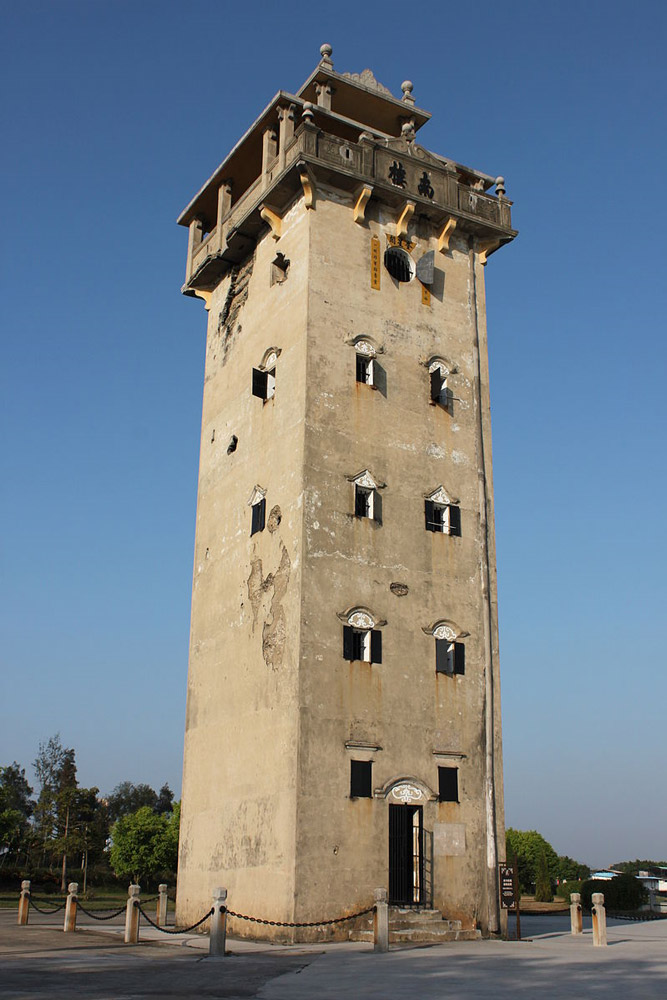 The Nanlou Diaolou in Chikan
The Nanlou Diaolou in ChikanAs a young boy, Xu enjoyed going to the river and nearby woods to fish and hunt for small animals with his friends. He had impeccable aim. When he heard the Japanese had reached his beloved home, he decided to rush home to defend his hometown. He wrote to various cousins, brothers and friends who had moved to Southeast Asia, and managed to enlist over twenty dedicated overseas Chinese willing to return and defend their hometown. Together, they formed the “Four Villages’ Situ Self-Defense Squadron,” and held their main defence post at the Nanlou Dialou. Built in 1912, the watchtower was 19 meters high and equipped with guns and searchlights in case of an attack.74
In 1944, the Imperial Japanese army was on its way from Sanfu dock to Chikan when it was attacked by the Situ Squadron, stationed at the Nanlou Diaolou. The assault lasted eight days and nine nights, and the last seven Situs were only defeated and captured after the Japanese fired poison gas. In 1999, a monument in their memory was erected by the Tan river.
In May and June of 1939, a Communist filmmaker called SZETO Wai-Man (Situ Huimin in Mandarin pinyin) documented the movement against Japanese forces in Chikan, Chishui, Shuikou, Ruliang, Hulong, Yijing, Tanxi and Sanbu. He later produced a documentary in Cantonese entitled "Guarding The Great Siyi." 75
Shortly after in July 1939, acute cholera spread all over Kaiping, leaving two to three hundred dead. With Baisha under Japanese control, access to the rest of Kaiping via the Tan River was extremely difficult, as the river was the doorway to the rest of the province, and the outside world. Moreover, the market had been closed down, and access to basic necessities and food became difficult. Many desperate farmers joined countryside militias or even the Communists to fight as guerrillas, just so that they didn’t have to go to bed on an empty stomach.
Cun Chuen Wong Survives
Imagine how worried your grandfather Moi Chung must have felt, knowing that his wife was stranded in the village, possibly starving or even dead at the hands of the Japanese! During this entire time, he would not have been able to send her any money, nor receive any letters from her. Luckily, your grandmother more than survived: with the 3 mu76 of land he had left her with, farm workers at her service, and a few spare cattle, she did not go hungry. In fact, she might even have had three maids working for her at that time.
Zhang Yinhao, Your Grandmother’s Maid
During our visit to Longgangli, we interviewed Zhang Yinhao / 张银好 (also known as Zhang Ruilian / 张瑞莲), who worked for your grandmother from age 9 up till age 18, when she got married. When we spoke with her, she said that it wasn’t the case that she was sold by her family for money. Instead, her father had entrusted her with your grandmother to help raise her, since your grandmother enjoyed a more comfortable living situation. Zhang Yinhao does not remember her own hometown.
Zhang Yinhao mentioned your grandmother Cun Chuen Wong had one boy and one girl, that she herself had never met your father or your grandfather, and that your grandmother did not mention them very often. At the beginning, your grandfather wrote letters to your grandmother (who was literate), but later he would only send money.
Your grandmother’s life was quite ordinary, and she spent a lot of time knitting clothes. She was very kind to others, and her maids led an almost leisurely life. In the village, the children of family relatives often came to her house for some small snacks, such as fruit candy and sweet potato.
In the late 1940s, Yinhao married a man from Yong’an village, Niujiaolong, Baisha town, Taishan / 台山白沙镇牛角龙大队永安村, a predominantly Huang village some 10km away from Longgangli. She is now 85 years old. After 1949, your grandmother did not employ any new maids.
Famine, Inflation, Starvation
In 1940, Longgangli experienced a small famine, when all there was to eat was watered-down congee. In the Siyi region, the price of rice rose from 36 to 50 old Chinese yuan per dan (50 kg) in under 20 days. To mitigate the risk of famine, the government sent approximately 1,000 dan (50,000 kg) of rice to Siyi, of which Kaiping county received 200 dan (10,000 kg). Only when rice vendors in Sijiu, Magang, Jinhu, Chishui began selling the newly arrived rice did the price start to drop.77
In 1942, tens of thousands of Kaipingese fled from Hong Kong as it was invaded by the Japanese. Due to food shortages in the colony, the Japanese enforced a “Return to the Hometown” policy, which prompted any non-residents to move back to their homes in Mainland China. Between 1941 and 1945, the population in Hong Kong dropped from 1.61 million to 60,000.
1943 was a grim year for Longgangli villagers. The Kaiping Gazetteer records that drought in the month of March brought on a terrible famine: “People starved to death. Corpses were scattered in the streets. Abandoned children roamed everywhere.” Villagers in Longgangli remember that there were days when all people had to eat were bamboo seeds.
 How much could 100 Chinese yuan (old Renminbi) buy in the 1940s? Source: Ebrey, Cambridge Illustrated History of China (2010)
How much could 100 Chinese yuan (old Renminbi) buy in the 1940s? Source: Ebrey, Cambridge Illustrated History of China (2010)1945: End of Sino-Japanese War, Civil War Resumes
When Japan surrendered after the atomic bombings of Hiroshima and Nagasaki in August 1945, there were over a million Japanese troops in China proper, a million in Manchuria, and another 1.75 million Japanese civilians. It would take several months to disarm and repatriate them all, even with the assistance of the United States and the Soviet Union. Until 1947, the U.S. tried to avert civil war by trying to convince Chiang Kai-shek to establish a government in which opposition parties could participate. When these efforts failed, the CPC and the KMT resumed their struggle for control.
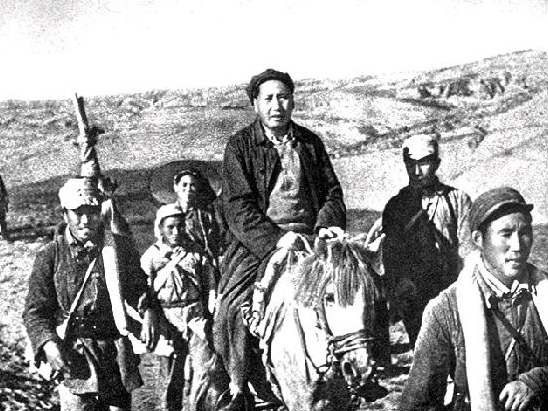 The Long March
The Long MarchThe KMT had been significantly weakened after the Sino-Japanese war, and their initial reluctance to face the Japanese threat head-on had tainted their legitimacy as the true defenders of the people. Meanwhile, the Communists had made some real gains in the countryside, in particular after the greatly mythologized Long March (1934-1935) had gained the trust of many peasants whom they mobilized in the war against the Japanese. Starting in 1934, an enormous group of 80,000 Communist soldiers, cadres and porters under increasing Nationalist pressure broke out from their encirclement, and began a 6000 mile long march to find a new base. Although they only crossed through Northern Guangdong on their way to Yan’an, Shaanxi province, your grandmother will surely have heard of the bitter struggles endured by these determined revolutionaries. Only about a tenth of the original force that left Jiangxi survived. Those that did would later occupy key positions in the leadership of Communist China. Amongst them was an embattled Mao Zedong.
In Longgangli, villagers lived in uncertainty, with the wider area of Kaiping still recovering from the devastations of the Second World War, Japanese air raids in the early 40s, and destructive floods in 1948.
In addition to the communal diaolou in Longgangli, villagers also constructed a watchtower equipped with a light and a generator in the 1930s to keep a lookout for thieves and bandits. In the late 1940s, several villagers stole the equipment and sold it. When their crime was discovered, those implicated denied the claim and blamed other unlucky villagers, who had no choice but to flee. One person died over this whole affair.
1949: The Founding of the People’s Republic of China
“The Chinese People Have Stood Up!”
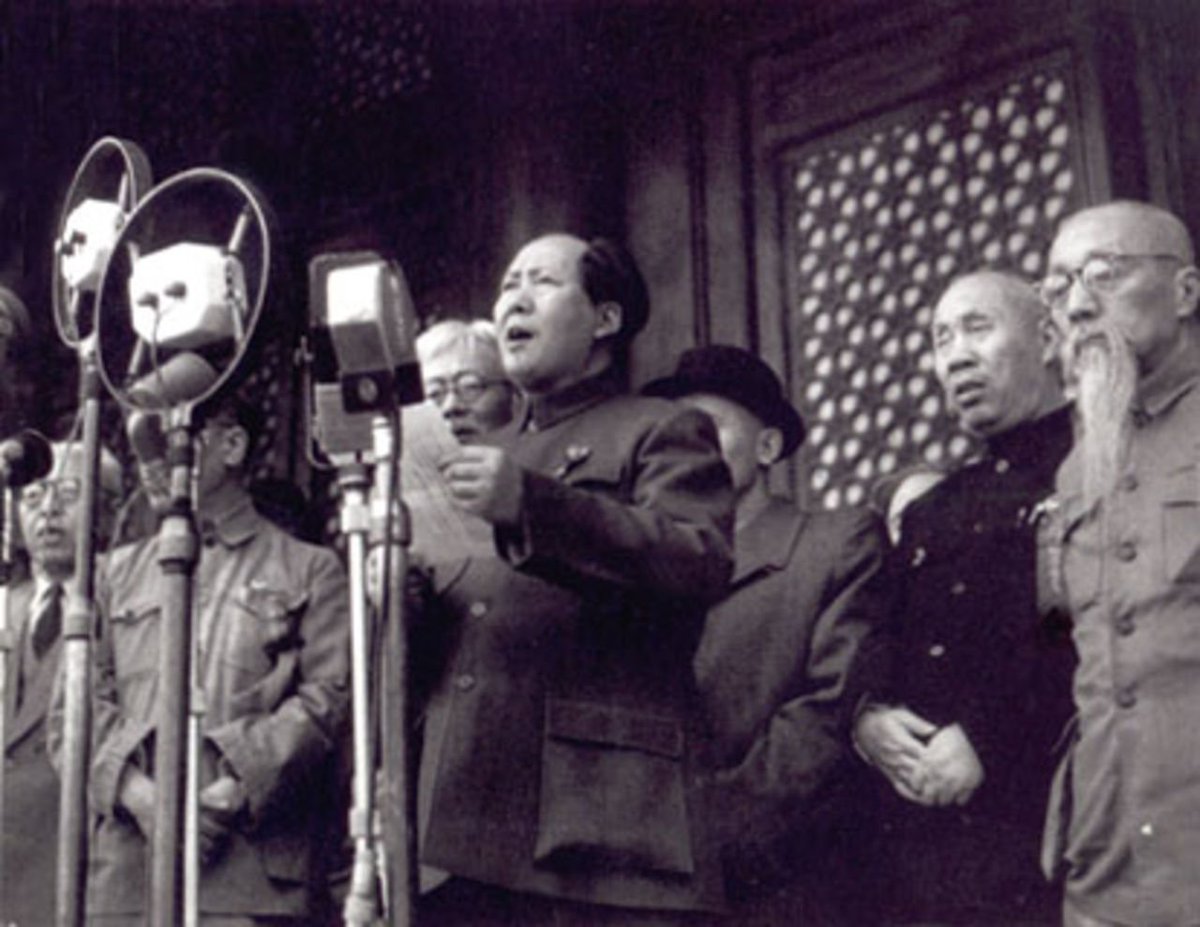 Mao declares the founding of the PRC at Tiananmen Square, 1949
Mao declares the founding of the PRC at Tiananmen Square, 1949In February 1949, the 5th Regiment of the Taishan Guangyang Detachment Troops joined forces with the peasant militia of Jianshi town, which was located some 90 km northwest of Longgangli. Together, they attacked Kuomintang-held Cangcheng, seizing over 100,000 kilos of rice from the KMT’s granaries, of which 20% went into the Red Army and 80% was given to local peasants in case of famine.
In early May 1949, the Communist Liberation Army peacefully gained control over Chishui; in response, the KMT withdrew from Taishan and moved in from Xiangang and Baisha to attack Chishui and Chongkou in Kaiping.
To stop them from reaching Chishui and Chongkou, the CPC army, aided by peasant militias, sabotaged the Wapiankeng and Chongkou bridges on Shaxianchi main road, and the Xianglan Bridge on Shadong road.78 Nevertheless, the KMT still managed to take hold of Chishui and Chongkou, fighting between local communist guerrilla units and KMT forces proceeded until after three days the KMT finally abandoned Chishui and Chongkou.
It would take another couple of months for the rest of Kaiping to be entirely rid of KMT forces. The defeated Nationalists fled to the island of Taiwan and on October 1st, 1949, Mao Zedong was proclaimed as Party leader of the People’s Republic of China.
In mid-June of 1950, your grandmother might have seen the Liberation Army march through Kaiping, on its way back from freeing Hainan Island, south of Guangdong.
Early 1950s: Cun Chuen Wong and the Land Reform Era
The Worst Yet to Come?
By the time the Communists had “liberated” China, Cun Chuen was 45 years old. She had lived through the fall of the Manchus, the end of imperial rule, two revolutions, and foreign invaders on her doorstep. While hard to imagine, it would appear her most trying times had yet to come.
Immediately after taking power, the CPC worked on reorganizing China on the model of the Soviet Union by implementing reforms on a political, economic and social scale.
Political Reforms
To set up a “democratic dictatorship by the people,” they began by creating a hierarchy of People’s Representative Congresses, from village to national level, to represent the Chinese populace. In reality however, the real power lay with the Communist Party, with Mao Zedong at its head.
To ensure no opposition or obstacles came in the way of reform, the Communists proceeded to “purge” the country of so-called counterrevolutionaries in 1951: those who had served the KMT or the KMT Army were executed by the tens of thousands, and similar numbers were sent to harsh labor camps. At the same time, this allowed the government to disarm civilians; over 500,000 rifles were collected in Guangdong alone. In April, Communist forces rounded up a total of 807 counterrevolutionaries in Kaiping.
China and the Korean War (1950-1953)
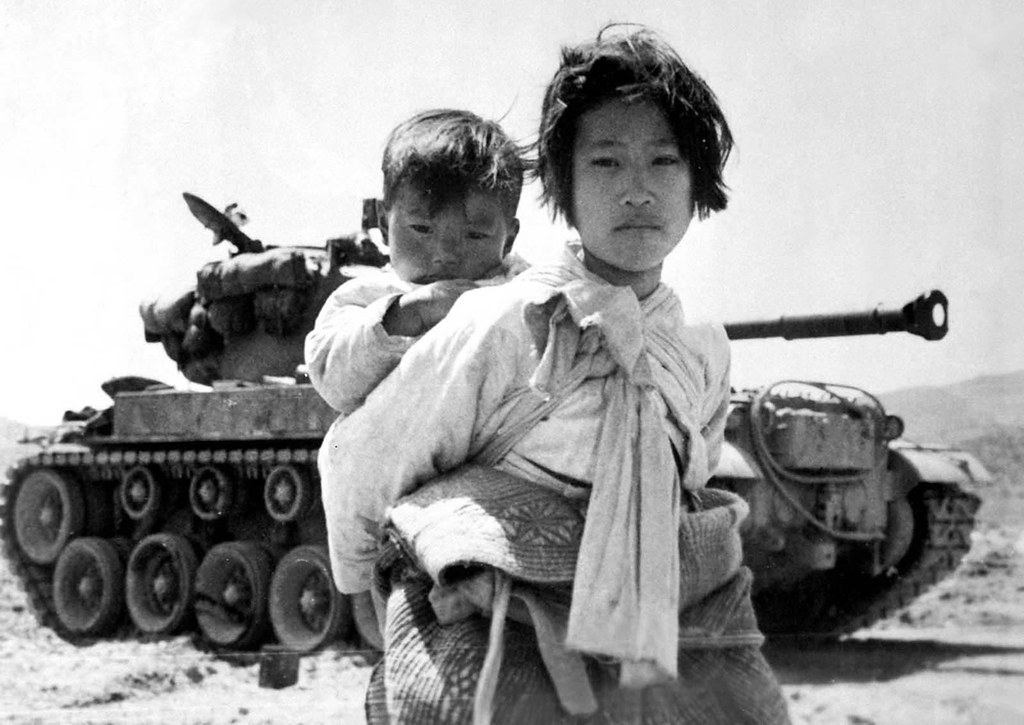 Refugees during the Korean War
Refugees during the Korean WarSoon after its founding, the PRC was caught up in its first international conflict: North Korea had just invaded South Korea, and when U.S. forces fighting under the U.N. flag threatened to side with the South, Kim Il Sung called for Mao’s help.
Following WWII, North Korea had been occupied by the Soviet Union and the South by the U.S. Stalin had no desire to engage in direct confrontation with the U.S., leaving Mao no choice but to intervene. When American troops crossed the 38th parallel and headed toward the Yalu River on the border of China and North Korea, Chinese troops pushed them all the way back south of Seoul. The border between north and south was pretty much back to its original position, and the U.S. was forced to accept the stalemate. Peace talks ensued in 1953, but as both Koreas never signed a ceasefire, they are still technically at war.
At the height of the Cold War, the U.S. imposed an economic embargo and extended their support to the KMT, exiled in Taiwan. In China, the U.S. came to be vilified as public enemy no.1.
U.S. aggression against Korea and China did not go unnoticed in Kaiping. On the 1st of May 1951, over 110,000 people protested against U.S. involvement in the Korean War. In July 1951, locals further donated weapons in aid of Korea, led by a Kaiping county council dedicated to the fight against the U.S.
Late 1940s–Early 1950s: Violence During the Land Reforms
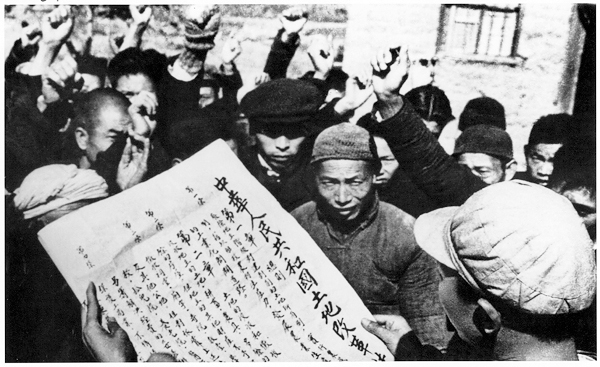 A man reads the Land Reform Law
A man reads the Land Reform LawIn the 1940s, there was one Chinese peasant for every six people in the world. As the Communists took control of new areas throughout China it taught people that inequalities were the result of a feudalist, antiquated system.
Redistribution of land was a major step toward reorganizing the country, though it was carried out with various degrees of hostility and scare-mongering tactics. Typically, a party representative would visit villages, identify wealthier vs. poorer peasants, and organize struggles against those most resented. They supervised the classification of villagers, from landlords to poor peasants, though this classification was not strict and people tended to use it as an excuse to settle scores with neighbours.
Land and goods were redistributed amongst other villagers, and terror tactics were often employed to force landlords to reveal where they had buried their gold. Sometimes, they were physically beaten and even executed for past crimes.
Violence in Longgangli
In Longgangli, some of the punishments ranged from forcing landlords to kneel on glass shards, removing their nails using pliers, or tying heavy goats’ udders to the bottom of their trousers, so that their trousers would always be falling down, causing them to stumble and trip. Meanwhile, villagers and onlookers would hurl insults at them, spitting on them as they were tied up, strung upside down in the middle of the ancestral temple.
Wealthy Overseas Chinese in Longgangli (and their families) were the first targeted by these attacks, including your grandmother, and several fled the violence and persecution that it entailed. The three families below were particular victims of the reforms.79
First, Zhang Bingkai was killed along with his wife and unborn baby;80 they owned a three-story house at the entrance of the village, and he had been a teacher. The second family was that of Zhang Qianbing,81 whose wife could not bear the shame and profanities villagers threw at her everywhere she went, so she committed suicide by hanging herself. Her husband Qianbing had previously donated money to help build a roadside pavilion called the Longgang pavilion at the intersection of the village road. During the land reforms, his land was divided among peasant villagers.
Your Grandmother Cun Chuen Wong
Thirdly, your grandmother was targeted. Perhaps because she was a single woman, left behind by her husband to look after land and property which past generations of his family had amassed, villagers were reluctant to classify her as an “all-out” exploiter landlord. In addition, and in this case fortunately, she owned less property than other overseas Chinese families in the village.
Nevertheless, Cun Chuen Wong was an easy prey in the village, and troublemaking villagers harassed her at all hours of the night, taking her money, her food, and breaking things in her house. Although she was at times dragged out of her home, shamed, and forced to watch as other, bigger landowners were shamed and violently beaten, she did not suffer the same physical brutality as Zhang Bingkai or Zhang Qianbing.
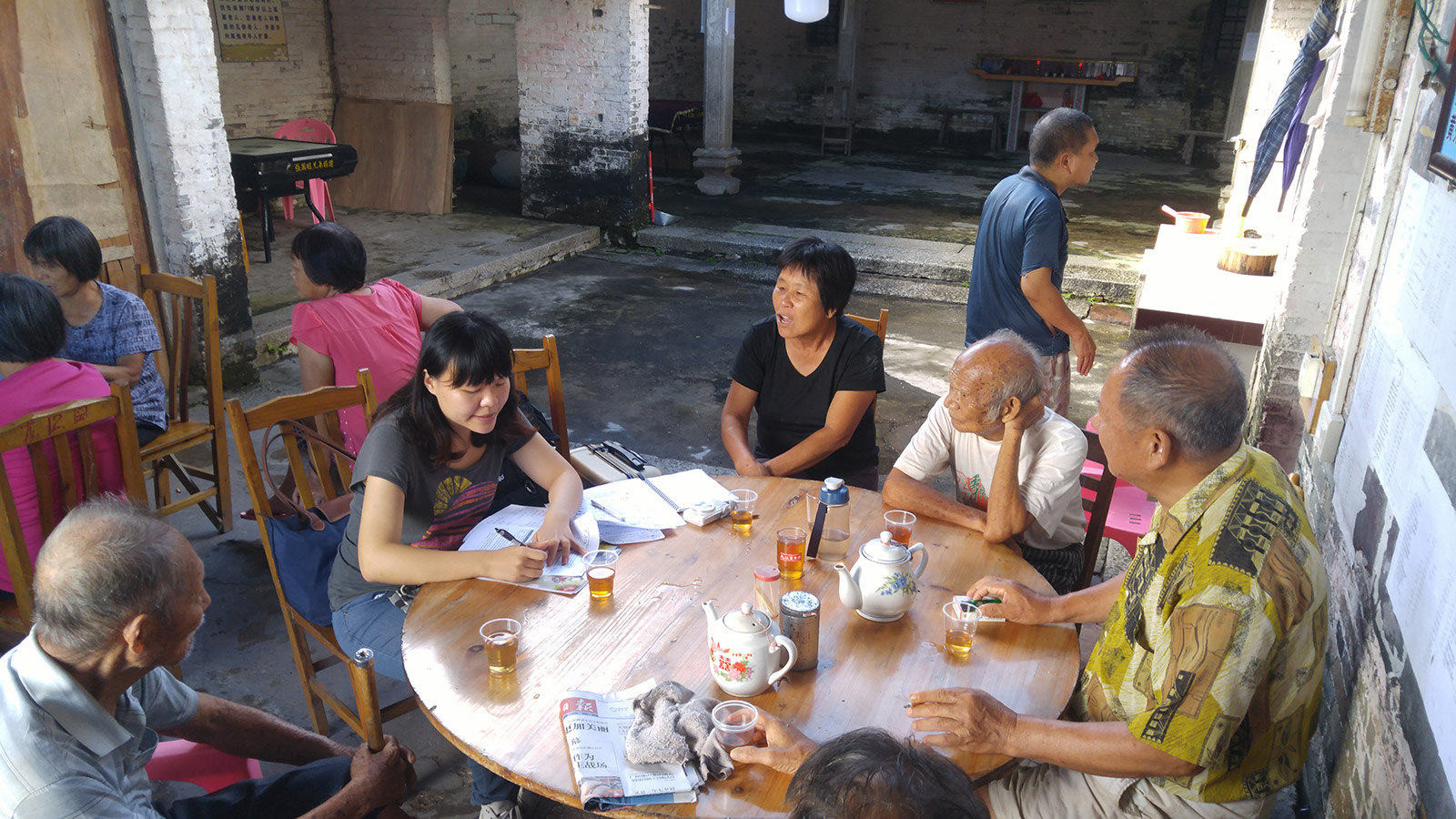 Villagers in Longgangli share their memories with a My China Roots researcher
Villagers in Longgangli share their memories with a My China Roots researcherHow Your Grandmother Coped
It is around this time that Cun Chuen Wong started living with a lady called Ma Meiying, another woman whose husband had gone overseas and lived alone in the village. They kept each other company and looked out for each other. Ma Meiying is the first wife of Zhang Xiqiao; Xie Guilan, one of our interviewees, is her daughter-in-law.82
In fact, overall, because most of the landlords under attack were the wives and children of men who had gone abroad, the land reform in Longgangli mostly saw women bullying other women.
The villagers we interviewed in Longgangli look back at the mid-fifities, the worst years of the land reforms, as times of utter madness, the absolute worst in the last 100 years or so. Villagers turned cruel and vicious towards landlords that in reality had never truly exploited their workers, like some “evil” landlords had done elsewhere.
In 1979, a policy favoring Overseas Chinese villagers was implemented to return the houses to their rightful owners, though this did not include the land that came with them.
Longgangli's Ancestral Temples
There used to be four ancestral temples in Longgangli – one for each clan branch – and an arch at the entrance of the village. During the land reforms in the early 1950s, three of the temples and the arch were redistributed to several peasants and subsequently torn down. The only temple left today is the Shiquan ancestral temple.
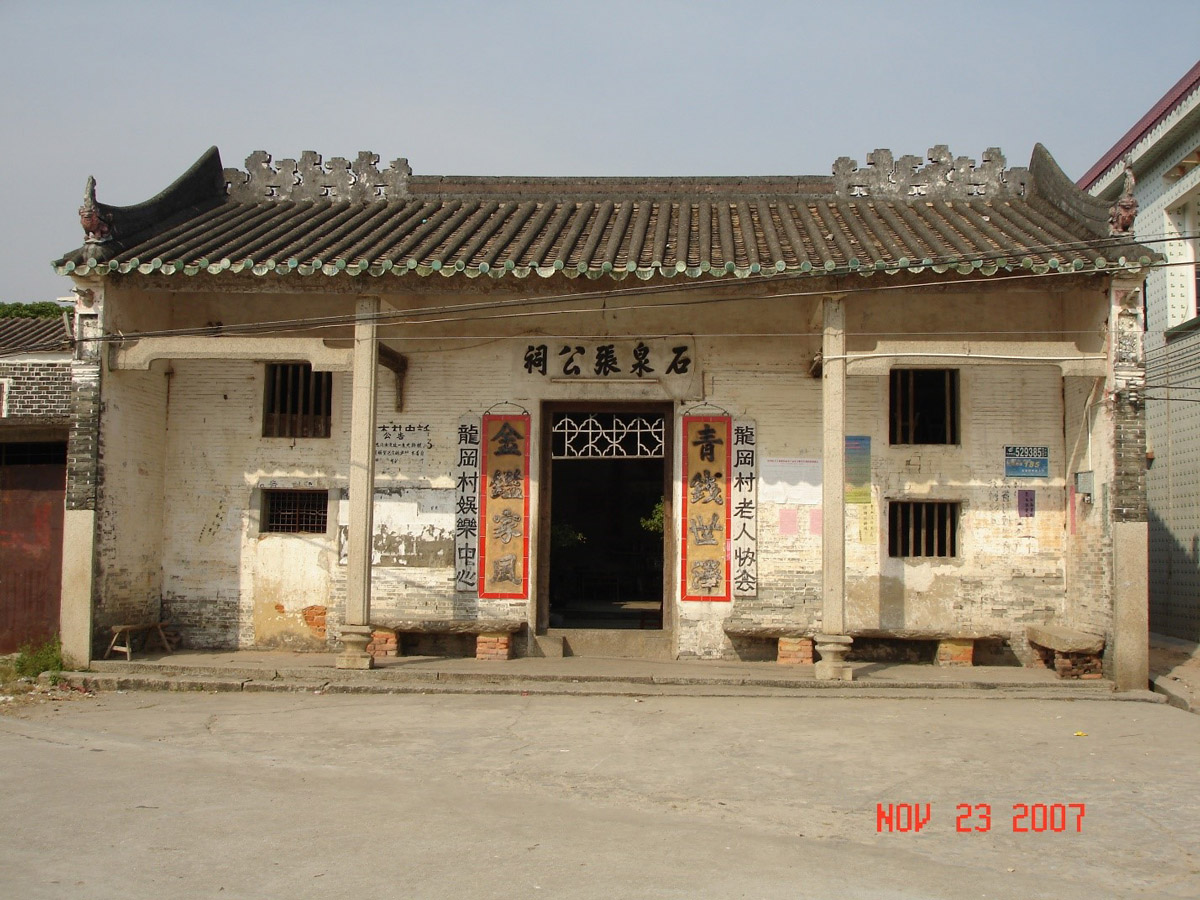 Zhang Shiquan Ancestral Hall
Zhang Shiquan Ancestral HallLate 1950s–Early 1960s: Collectivization and People’s Communes
Chishui Commune
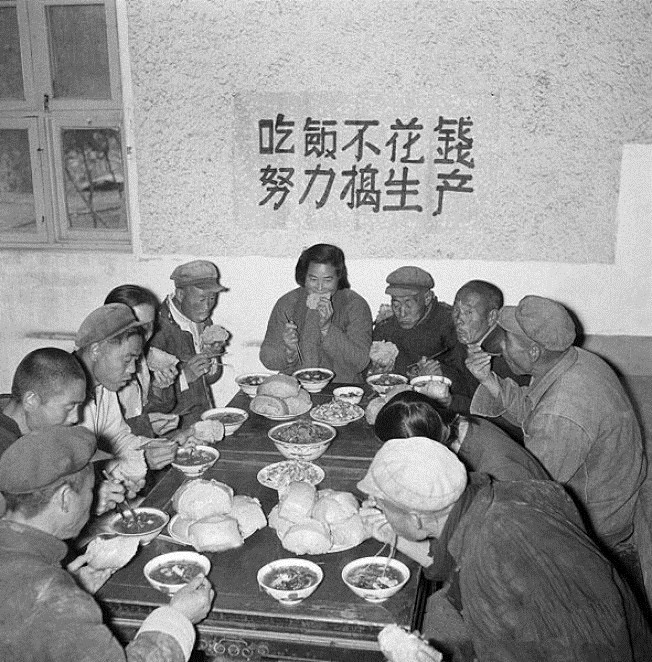 Members of a commune sharing a meal
Members of a commune sharing a mealAfter the redistribution of land, agricultural collectivization followed. The government began by restructuring the administrative and geographical divisions of the territory. Chishui town, which was under District 6 during the KMT period, was reassigned to District 5 in 1950. In 1958, Chishui town was merged with Jinji, Dongshan, Xiangang to form Chishui Commune. In 1960, Chishui Commune was divided once again as per its previous divisions.83
Communes had governmental, political, and economic functions. As the largest collective units, they were divided into production brigades and teams. Under the commune system, all resources were shared, from food and cattle to furniture and agricultural tools. Private ownership of farms or land was forbidden, as was taking private meals.
The Downsides: Departure of Cun Chuen Wong to Hong Kong
In reality, the system was inefficient and labourers had no incentive to be productive. From 1953 onwards, all communes were required to sell grain to the government, at prices and levels set by the government. Some of this grain was redistributed back to the farmers. Most, however, was sent to the cities, sold as export grain, or distributed as foreign aid, to create the illusion of a booming economy.
Coupled with severe droughts and typhoons, this proved a devastating policy for many regions of China. The Kaiping county government was forced to hand out 15,300 kg rice, 53,750 kg grain and 115 million old Chinese yuan to struggling peasant families to survive a famine that lasted an entire year. In October 1953, some 25 square km of fields had been flooded as the result of a typhoon and subsequently ruined by parasites. Food stamps were introduced to ration supplies.
While during this period, the Longgangli population was at its historical high with 500 inhabitants, it is safe to say it was also one of the hardest periods. Your grandmother, possibly worried for her life, fled to Hong Kong in 1955.
Remittances to Longgangli
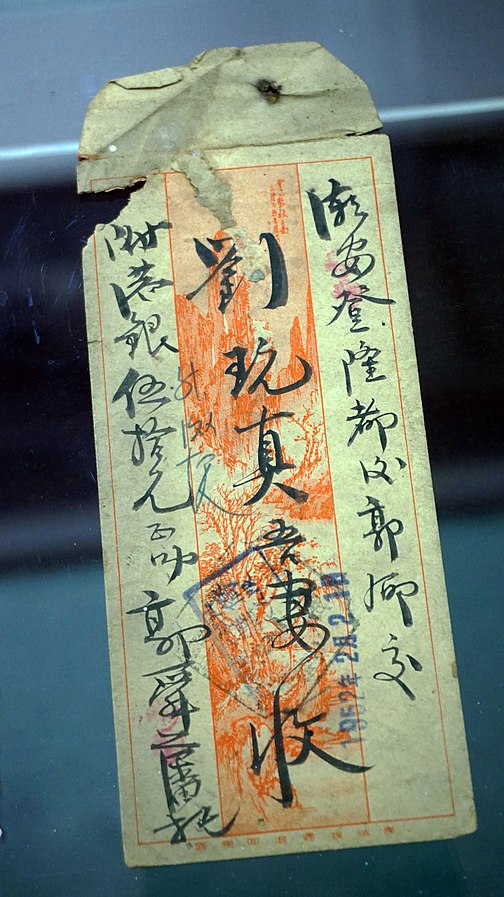 Remittance letter
Remittance letterIn the 1950s and 1960s, Overseas Chinese would send around RMB 100 each year, which was more than enough to ensure that their family could live comfortably. At the time, one had to send money via the bank, and use the bank draft to purchase various items. The villagers we interviewed remember that, in those days, RMB 100 was roughly equivalent to 417 Hong Kong dollars or 12.5 USD. School fees, for example, were 2 RMB per trimester.
1958-1961: The Great Leap Forward and the Great Famine
The Great Leap Forward
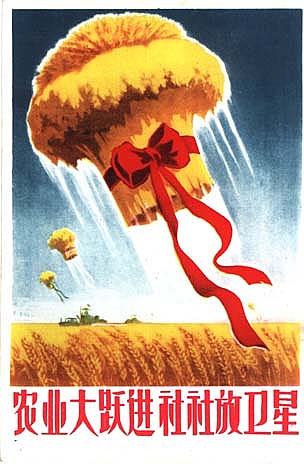 Propaganda for the Great Leap Forward
Propaganda for the Great Leap ForwardThe People’s Commune went hand in hand with the Great Leap Forward, another nationwide project devised by Mao Zedong to place China’s industrial sector on par with the United Kingdom and United States. He saw grain and steel production as key to China’s success, encouraging the establishment of small steel furnaces in every commune and urban neighbourhood so people could produce steel from scrap metal (though he himself knew nothing about metallurgy). Peasants and workers mobilized en masse to melt whatever metal scraps they could get their hands on, from pots and pans to bolts and spoons.
In Longgangli, there were only a handful of metal windows, doors and other utensils in some of the richer households which could be donated to the country’s industrialization efforts, so the metal-burning craze was not felt as much there.
Another focus of the Great Leap forward was irrigation and water conservancy, for which the PRC launched a series of massive-scale but poorly planned construction projects. Longgangli and the rest of Kaiping would definitely have benefited from a reliable reservoir; between 1954 and 1959, the region that your grandmother lived in experienced 3 powerful typhoons which unleashed torrential floods. It was so bad that in 1959, losses were estimated to have reached 1.1 million yuan.
In between floods and the coldest winter ever recorded in Kaiping in 1956, the agricultural areas suffered severe droughts. To combat regular flooding, Longgangli villagers built a dyke to prevent the water from reaching their crops.84 Still they struggled to produce enough to feed themselves, and in 1957, the county introduced food stamps for non-staple foods such as vegetables, eggs, and meat.
Impact
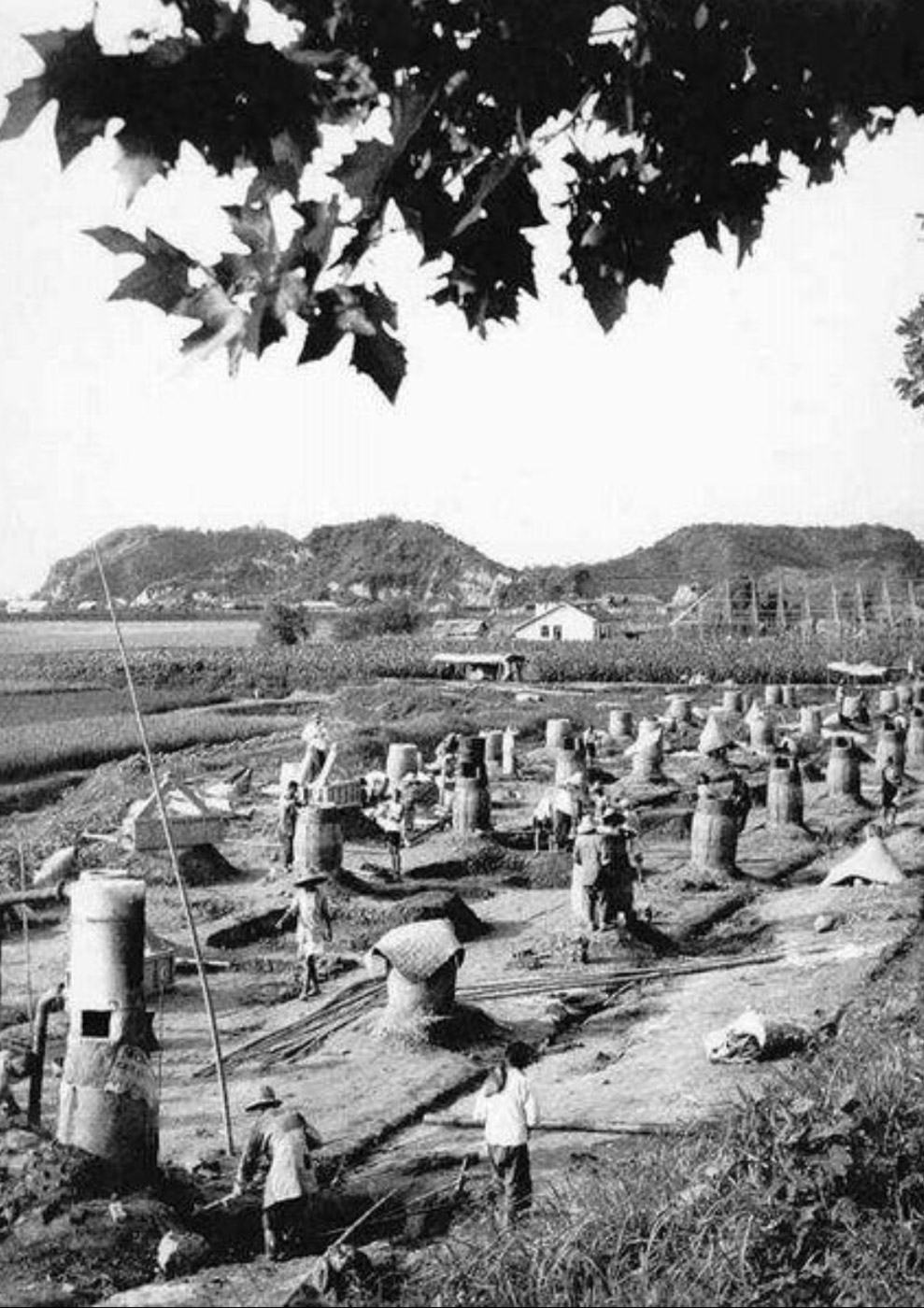 Backyard furnace in rural China, 1958. Wikimedia Commons.
Backyard furnace in rural China, 1958. Wikimedia Commons.Between 1958 and 1961, an estimated 15 million died in the Great Chinese Famine.
Drought and poor weather played some part in the disaster: In 1961 in Kaiping alone, freak cold weather destroyed 93.3 square km of sweet potato fields, followed by devastating storms and floods causing an estimated 3.3 million yuan in losses. However, the disastrous policies from the Great Leap Forward made things endlessly worse, resulting in millions of agricultural workers being ordered away from their fields to collect iron and steel scraps. On another occasion, they were ordered to kill sparrows to prevent the birds from eating crop seeds. This caused an explosion of vermin insects that decimated large amounts of crop. Leaders and cadres in charge of large agricultural areas without any technical knowledge introduced devastating techniques designed to maximize crop output, such as ploughing so deep that the soil became salinized.
It did not help that local leaders were pressured into bumping up the production figures for their respective communes to please their superiors, which in turn allowed production groups to sell more grain than was readily available based on these false figures.
The Early 1960s
In the aftermath of the famine, your grandmother will have seen a drastic increase in emigration to Hong Kong and Macau from Kaiping and the rest of Guangdong. To keep up with the population movement, the Kaiping county government set up a migration office dedicated to the area’s overseas Chinese population.
The failures of the Great Leap Forward and agricultural collectivization led to central and county governments to re-think production techniques. In 1964, Kaiping county called a meeting to discuss the establishment of up to five agricultural schools in Chishui, Xiangang, Baihe, Yueshan and Changsha, as well as one forestry school near the Workers’ University in order to educate and train agricultural workers.
Typhoons and Floods
Typhoons continued to affect the Kaiping area on almost a yearly basis, but 1964 saw one of the most active tropical typhoon seasons in the northwest Pacific, with up to ten typhoons in the South China Sea that year. In 1965, there was a great flood of unforeseen magnitude, possibly caused by the Shishan reservoir that had been built only a few years prior. Water levels reached 1.6 meters, forcing all villagers to take refuge on the second floor of their homes. Nobody died or was injured, but it took a full three days for the water to recede. The Guangdong and Hong Kong Army came to the rescue of the villagers, dropping provisions (such as biscuits and crackers) from the skies.
The area had barely recovered from the floods that in 1966, over 1800 teachers and students from Sun Yatsen Medical Institute were mobilized to combat drought in Chishui, Jinji and other areas.
1966-1976: The Cultural Revolution
Out with the Old, In with the New
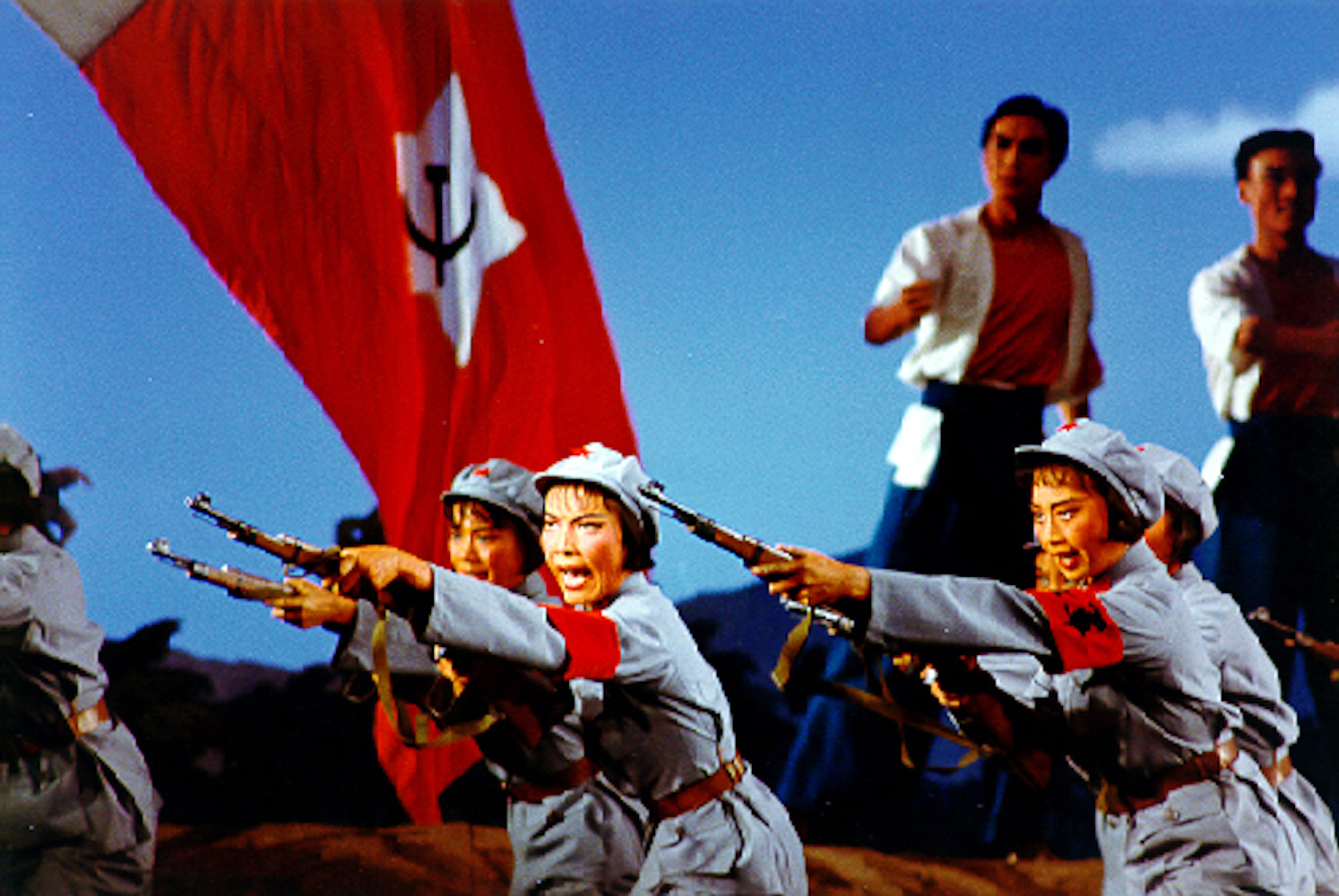 A revolutionary ballet production, 1972
A revolutionary ballet production, 1972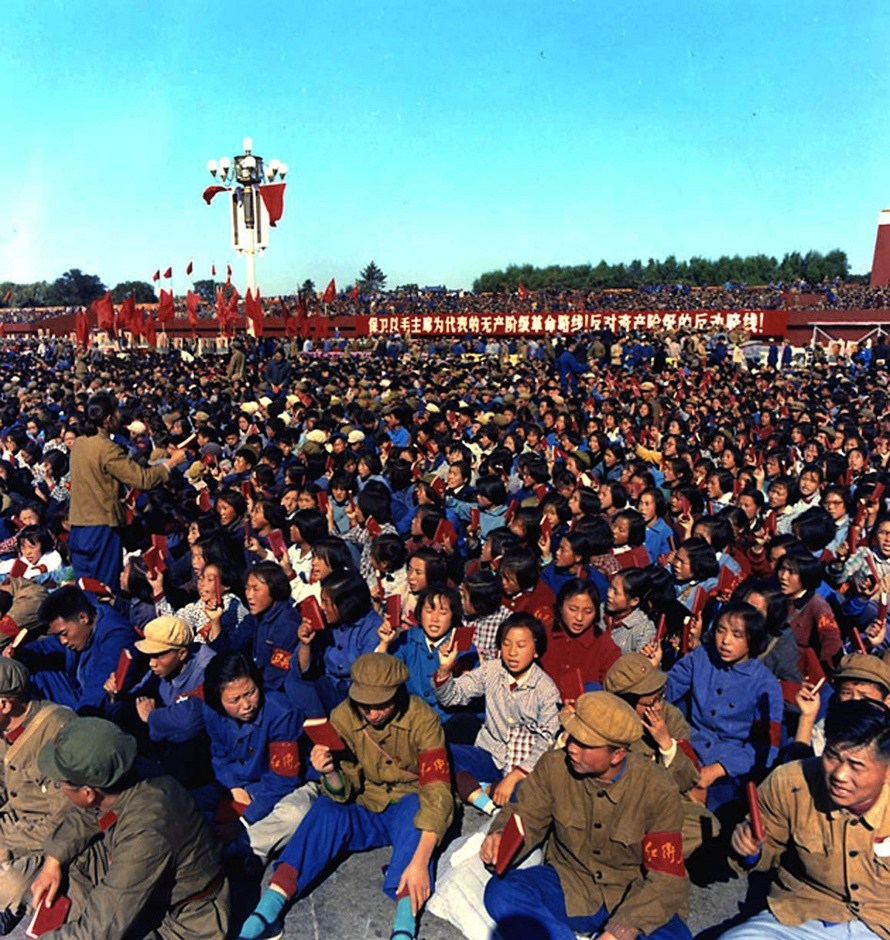 Red Guards in Tiananmen Square, 1966
Red Guards in Tiananmen Square, 1966After the embarrassing failure of the Great Leap, Mao retreated from active decision-making, letting other leaders focus on reviving the economy. In 1966, eager to restore himself as the central figure of the party, Mao launched a socio-political movement that he hoped would purge the country of any remnants of capitalist and feudalist elements from Chinese society, and to reinstate “true” Communist ideology into the PRC. In response, millions of youths formed Red Guard teams to rid the country of the “Four Olds”: old customs, habits, culture, and ideas. Mao gave full reign to the Red Guards, urging them to create utter chaos, which would allow him to then institute complete Communism in the country.
The campaign quickly spun out of control, affecting all elements and levels of Chinese society: prominent political leaders were purged from the CPC itself; teachers and intellectuals were persecuted and sent to labor camps, leaving most schools and universities closed; authors, artists, actors and singers were persecuted, as any art form or performance that did not glorify Mao and the PRC was seen as veiled criticism of the government. Millions of so-called “capitalist roaders” were subjected to torture, murder and public humiliation during the “struggle sessions” organized by the Red Guards, who forced them to pronounce self-criticism speeches and sometimes pushed them to suicide.
The material and historical damage was equally massive: hundreds of temples, statues, artefacts and tombs were ransacked and desecrated by the Red Guards; literature and philosophy books, including the great Classics, genealogies, and foreign books were burned.
Cun Chuen Wong Leaves Hong Kong
Your grandmother did not wait to witness the horrors of the Cultural Revolution. In 1966, she left Hong Kong and joined her husband and your father in the U.S., after 43 years of being separated.
After she left, the Zhang Shiquan ancestral temple was looted by villagers, and used to store grain. Most of the ancestral tablets enshrined within it were destroyed. Fortunately, besides the burning of the ancestral tablets, Longgangli was overall spared from the destruction that the Cultural Revolution brought elsewhere.85
Longgangli Moves On
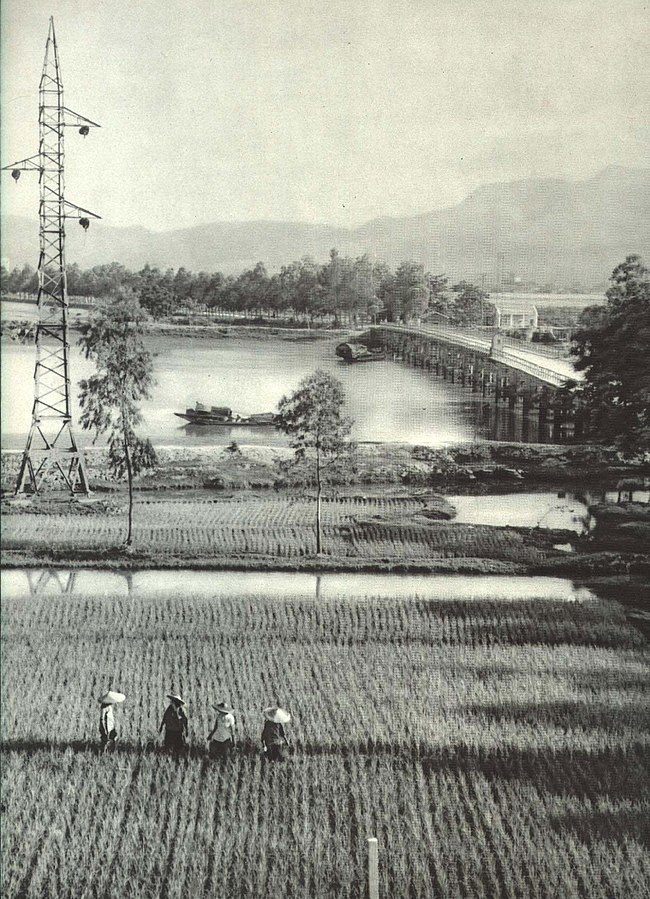 Power grid in Kaiping, 1963.
Power grid in Kaiping, 1963.Longgangli received electricity in 1966, which was considerably late compared to the rest of Kaiping. In 1970, over 40,000 people from every commune were mobilized to participate in the building of flood control systems in the Tan River. Workers focused on the middle section of the Tan River, the Chikan area upstream, as well as Baihe, Xiangang, and Chishui. In 1973, a devastating livestock disease affected cattle in the communes of Yueshan, Changsha, Shuikou, Shatang, Chikan, Chishui, Xiangang and Baihe. Over 2,700 pigs and 4 farming cattle were contaminated.86
After the end of the Cultural Revolution in 1976, the Zhang Shiquan ancestral temple was restored to its function as the village’s ancestral hall, though people kept their ancestral tablets in their own homes.
In 1977, a new technique to combat drought is introduced in Cangcheng, Tangkou, Dongshan, Jinji, Yueshan, Chishui communes. The county experiments with chemical aeroguns to produce artificial rain.
Post-1978: Economic Reforms and Opening-Up
Following a struggle within the Communist Party after Mao’s death in 1976, Deng Xiaoping rose to power and introduced a series of economic reforms and policies to open up China’s economy. The 1980s saw a rapid development in China’s consumer and export sectors, with many foreign firms moving to the newly established Special Economic Zones, mostly located in Guangdong province. Life expectancy, education, and living standards overall improved from this period on.
In 1979, the one-child policy was introduced to limit population growth, by restricting the number of children per family to one. This policy was applied to Kaiping county in 1981. Though it was particularly strict in urban areas (families with more than one child were forced to pay a fine), certain rural areas were allowed up to three children per family.
In December 1990, over 16,000 phone lines and 11,000 telephones were installed in Kaiping.
Zhang Weiming - My Kaiping Journey - From Gold Mountain To Dragon Hill Village
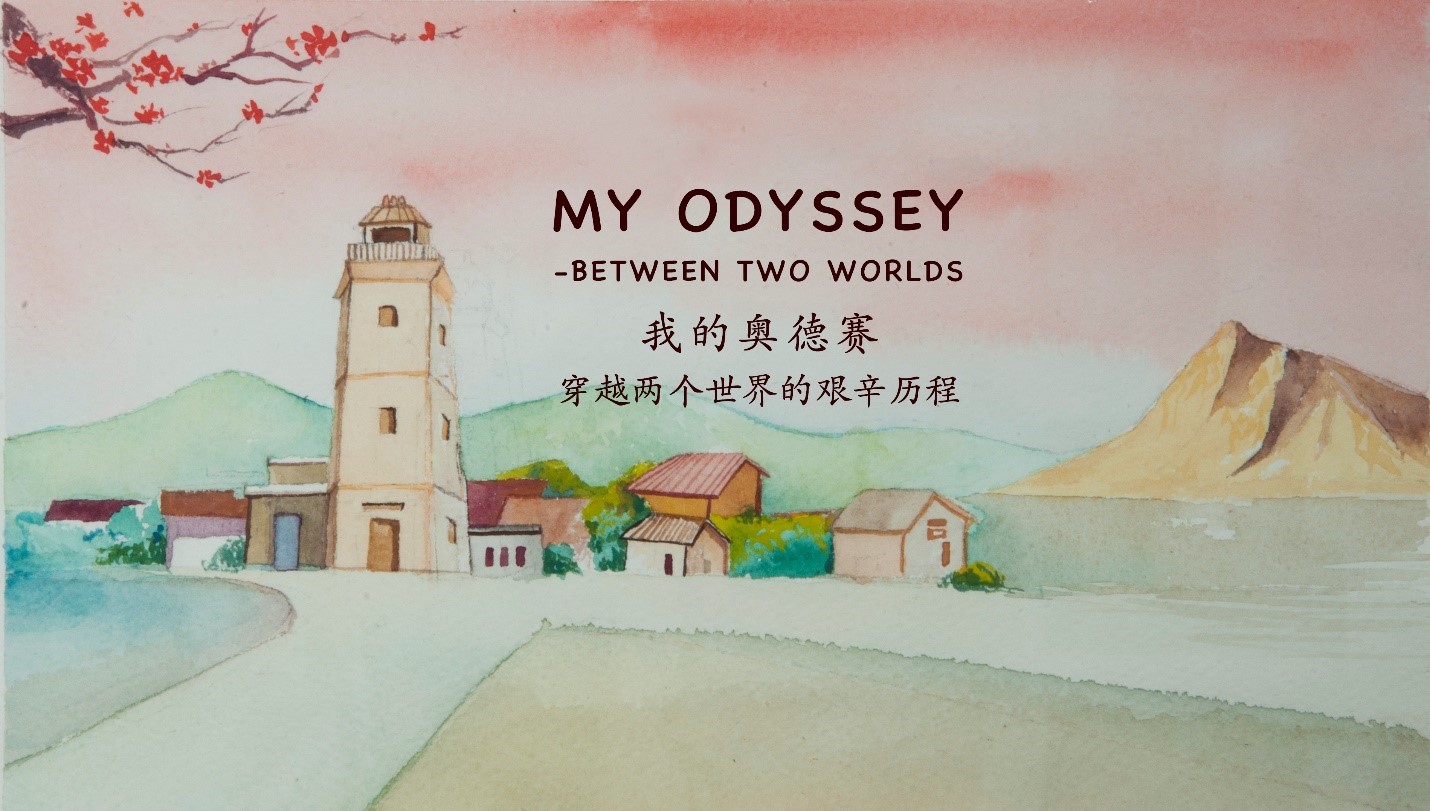 “MY ODYSSEY – Between Two Worlds” documentary is about an intimate pursuit by Zhang Weiming (Raymond Douglas Chong) to discover his ancestral roots in Gold Mountain and in Cathay. Zhang Han.
“MY ODYSSEY – Between Two Worlds” documentary is about an intimate pursuit by Zhang Weiming (Raymond Douglas Chong) to discover his ancestral roots in Gold Mountain and in Cathay. Zhang Han.Beginning (2003)
As a sixth generation American Born Chinese (ABC), I grew up in a barrio (neighborhood) of Elysian Valley near Chinatown of Los Angeles, City of Angels, in California, The Golden State of America - Gold Mountain. I was vaguely aware of my Chinese heritage and was utterly ignorant of my Zhang clan ancestry. My narrow realm was Chinatown and Little Tokyo in Downtown. I ate our Chop Suey, Cantonese cuisine. I attended family affairs. I celebrated traditional festivals. But I was a jook sing, bamboo rod, one who looked Chinese (solid) outside but who thought American (hollow) inside.
I quietly lived and studied in an insular enclave of Chinese from Canton with dark secrets, a dreadful legacy of racist Chinese Exclusion Act (1882), paper son scheme, and Chinese Confession Program (1956-1965) during the scary Red Menace. As a youth, my parents and elders never shared their tales about our forefathers nor their lives in Kaiping. Except for brief forays into Chinatown, I knew very little about China, an exotic world in a far place, and had no reverent respect for my Zhang elders or my Chinese heritage.
After a defining moment on a stark winter day of January 30, 2003, my life paradigm drastically changed. It has led me to My Kaiping Journey - From Gold Mountain to Dragon Hill Village.
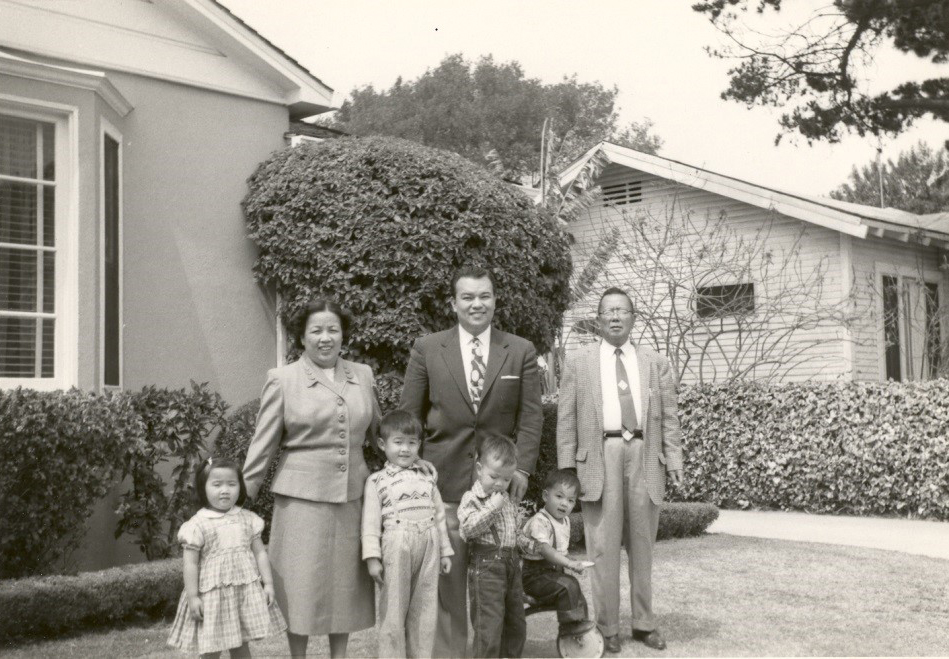 Zhang Weiming with Zhang Baoshen, father, and Zhang Xishou, grandfather, in Los Angeles.
Zhang Weiming with Zhang Baoshen, father, and Zhang Xishou, grandfather, in Los Angeles.Kaiping (1506)
Kaiping County lies in the southwest region of the rich Zhu Jiang Pearl River Delta near Jiangmen City of Guangdong Province in The People’s Republic of China. Facing the South China Sea, it is a fertile land of rice and fish with beautiful evergreen panorama of vales, glens, and mesas.
Long Gang Li, Dragon Hill Village, is located in the Chishui Township of Kaiping County of Jiangmen City. It lies on the east bank of Tan Jiang Tan River Valley near the glorious emerald Mount of the Eight Immortals Crossing the Sea. Long Gang means dragon hill. The five-clawed dragon was an imperial symbol of the Chinese emperors.
My ancient Village has a long history that extends back to 1506 A.D. during the Ming Dynasty. Today, about 250 people, mostly elders and children, of the Zhang Clan live in this crumbling Village among rice fields, vegetable gardens, tropical fruit orchards, and fish ponds near bamboo groves. In diaspora, six hundred Zhang descendants live overseas in Southeast Asia and America.
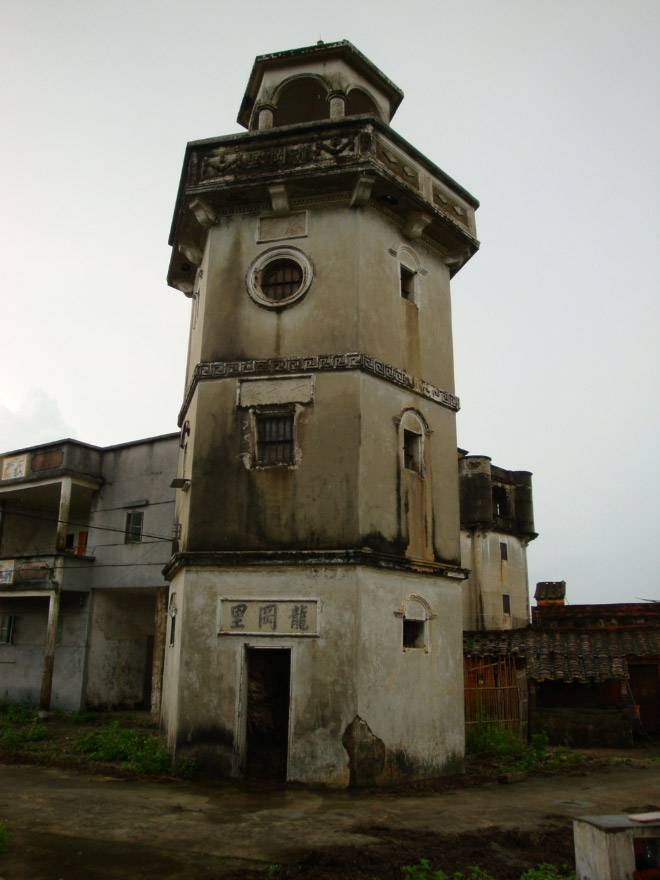 Zhang Clan Diaolou of Long Gang Li
Zhang Clan Diaolou of Long Gang LiHomecoming (2007)
After a sojourn of one day, from Los Angeles to Guangzhou, across the azure Pacific Ocean, I finally gazed upon the vivid scenery of Kaiping for my homecoming. As the Toyota white van carried my mother, Yu Xinkai (Seen Hoy Chong nee Tong), and I toward Long Gang Li along a tree-lined concrete road, I saw myriad farm villages of rice fields and fish ponds with their magnificent Diaolou (watchtowers and villas). Bamboo groves, evergreen woods, and emerald mounts surrounded the fertile valleys of the Tan Jiang.
On a fall day of November 21, 2007, we entered Long Gang Li as the van slowly drove us into the Village square on a dirt road. During commotion of our surprise visit, jubilant villagers greeted us as they poured from the temple and their homes. They recognized me as a fallen leaf from America.
I was quickly introduced to Zhang Yongchang and Huang Meihua, the caretakers of the house where Zhang Baoshen (Gim Suey Chong), my father, was born in December 26, 1922. The couple led me to the ninth house of the sixth alley in Long Gang Li and through a narrow alley, I saw an early twentieth-century house made of gray brick and topped with a red tile roof, the house built by my great-grandfather, Zhang Peilan (Hoy Lun Chung).
Inside the house, I saw a parlor with a skylight, two kitchens and two bedrooms on the ground brick floor. The upper wood floor contained the family altar and storage lofts. Both kitchens had brick hearths with shrines. The parlor had a rice grinding pit and a water basin with a God of Heaven shrine below the family altar. The couplets on the Zhang family altar read: The Light of the Lamp Can Bring Bright Future. Above the lintel of a parlor door, I saw stuccowork showing a soaring dragon with two peaches. On the other parlor door, the stuccowork depicted a soaring phoenix. In the lofts, I found precious family treasure in a cupboard. Inside was the December 1921 wedding china dishes of Zhang Xishou (Moi Chung), my grandfather, and Huang Qinchun (Cun Chuen Wong), my grandmother. One dish reads Zhen Ri, which means Day of the Wedding Ceremony. Another dish reads Xi, which means Double Happiness. I cherish these family treasures and brought several dishes back to America as keepsakes.
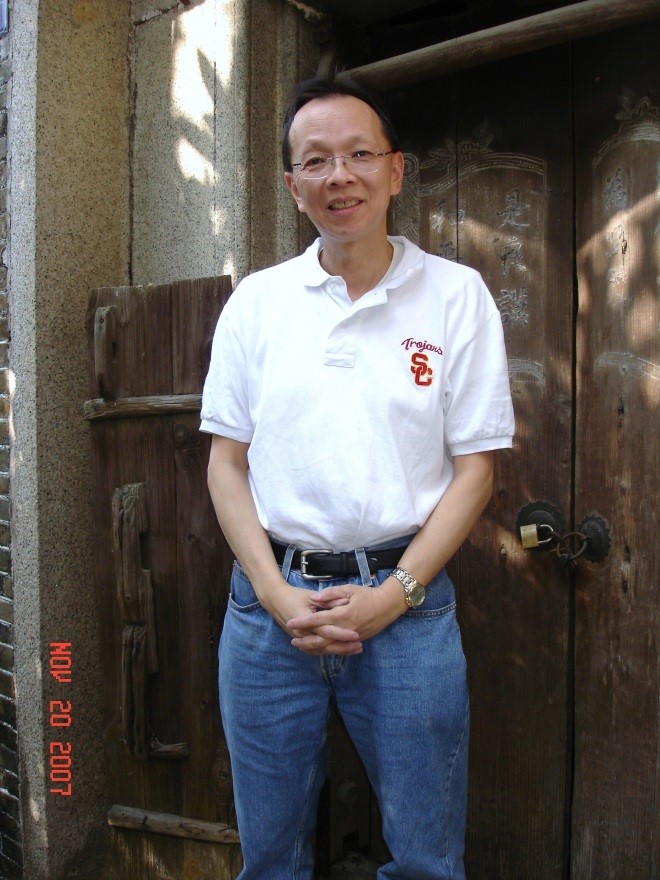 Zhang Weiming in front of his ancestral house in Long Gang Li
Zhang Weiming in front of his ancestral house in Long Gang LiMy old gray brick house in a poor village is in dilapidated condition. The roof leaks during every heavy rainstorm, and the wood frame and floor have dry rot. But this ancestral house has a special place in my heart and in my mind. Zhang Peilan, built this Gold Mountain House from the fortune he made in Gold Mountain, as opium purveyor and gambling lord in Boston Chinatown. Furthermore, my father was born here. My father studied here and played with friends outside the house. He explored the groves, forests, and hills near the Village. Three generations of Zhangs lived in this simple house until 1955. This old house is my tangible link to the past — a physical bond with Long Gang Li, my ancestral hometown.
During the clamor, I also met Zhang Yongchong, an elderly man who is the grandson of my father’s paper father. Zhang Guoxiang (Quock Hung Chong), his grandfather, escorted Zhang Baoshen during his entry to Port of Boston in spring 1932. I was quite stunned to meet Zhang Yongchong, for he represented a solid link to the past of seventy-five years ago.
I met another elderly man, Zhang Liucai. His grandfather, Zhang Peimu, was a business partner of Zhang Peilan. Together with two other partners, they operated Da Xin dry goods store in Baisha in Taishan County. Zhang Liucai clearly remembered my great-grandfather as a child.
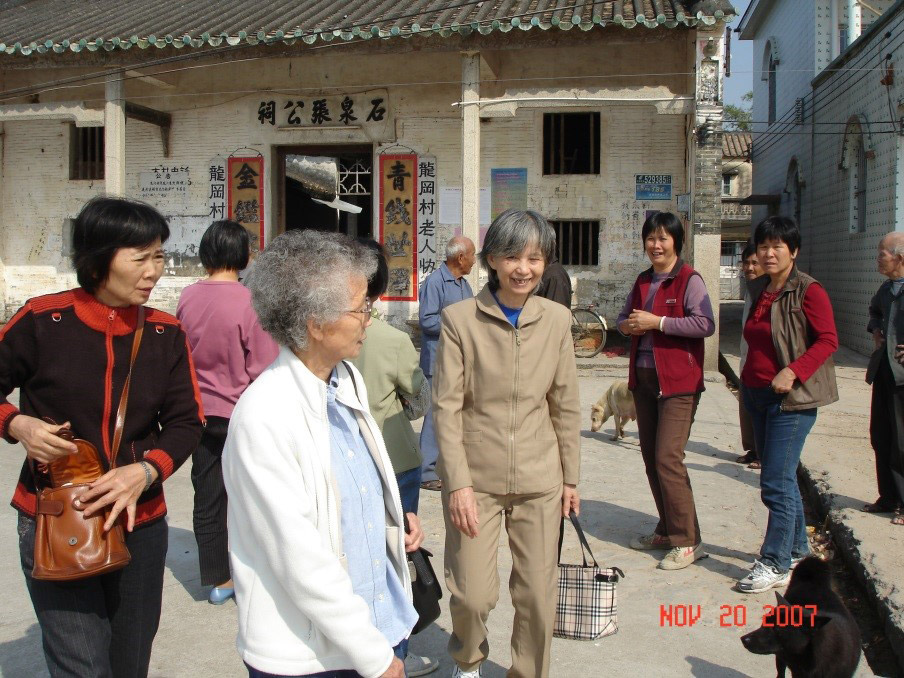 Eager homecoming of Zhang Weiming in the square of Long Gang Li
Eager homecoming of Zhang Weiming in the square of Long Gang LiDiscovery (2008)
My second Kaiping Journey was the summer on June 30, 2008. I met Zhang Baoqing along with Zhang Fuchang, her father, and Huang Ruijuan, her grandmother. They gave me a copy of the Zhang Clan zupu, family register. I was elated to obtain this invaluable treasure. The zupu cover shows a master and his driver in a chariot with his horse. This vintage document showed that our male lineage dates back to 778 A.D. during the reign of Emperor Tang Daizong of the Tang Dynasty when Zhang Cheweng founded our family line. He was an imperial officer of the fifth rank.
Zhang Clan zupu shows the names of Zhang Bingyao (great-great-grandfather), Zhang Peilan (great-grandfather), Zhang Xishou (grandfather), and Zhang Baoshen (father). As Zhang Weiming, I represent the forty-third generation of the Zhang males. I felt well connected with my Zhang ancestors who span from 778 A.D. through forty-four generations in China, Southeast Asia, and Americas, with its legacy across thirteen centuries.
We climbed the Zhang Clan Diaolou on the east end, which protected the villagers from bandits during turmoil of early 20th century. From atop of the Diaolou, I was mesmerized by vista of this ancient Village, the surrounding tropical landscape, and the lush rolling hills. I intimately bonded with this ancient land of my Zhang ancestors, an idyllic paradise.
As we descended from the Diaolou, Zhang Youxin, an elderly man rushed to greet me. He was a classmate and dear friend of Zhang Baoshen. Uncle Youxin excitedly described my father’s life in the Village before he departed for Gold Mountain, America, in spring 1932. He was so overjoyed to meet the son of Zhang Baoshen who had left the Village 76 years ago. I too was astonished with this moment.
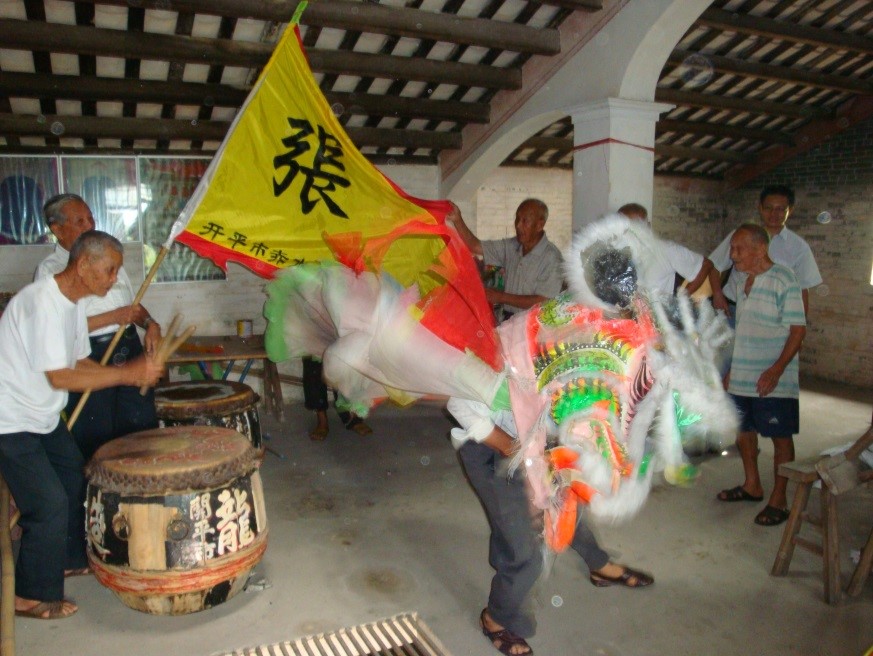 In Culture Kingdom Garden, Zhang elders celebrate return of their fallen leaf, Zhang Weiming
In Culture Kingdom Garden, Zhang elders celebrate return of their fallen leaf, Zhang WeimingI felt more connected to my Zhang ancestors when we hiked a dirt trail up the solemn Fei E Shan, Hill of the Flying Swan, to visit the tombs of past generations. Shaped like a swan, the Hill symbolizes graceful love. With a falling drizzle, we walked through a rustic monsoon rainforest of eucalyptus and ferns. The song of tawny cicadas shrilly echoed in the rainforest. When we arrived, we saw blue swallows and black butterflies flew above us. The tombs amid the ferny field were laid out in Feng Shui fashion facing Ping Hu Ping Lake below Mount of Eight Immortals Crossing the Sea. The delicate rain was a good omen on this summer day.
In front of their tombs, I respectfully respected Zhang Peilan and Huang Shee, my great-grandmother, by bowing three times. The tomb of Liang Shee, first wife of Zhang Xishou, was nearby. Above their tombs, my ancestors (thirty-seventh, thirty-eighth and thirty-ninth generations) are buried. I had journeyed from Gold Mountain to respect them. I felt a powerful spiritual affinity here. I collected ferns, earth, and rocks that surrounded the tombs as keepsakes from these sacred grounds.
We went to the Culture Kingdom Garden, where the Zhang elders celebrated my humble homecoming in grand style as a returning fallen leaf. They vigorously performed a Xingshi, Lion Dance, while joyfully beating drums, gongs, and cymbals and waving the bright yellow Zhang Clan flag. This ceremony marked the first return of our family since spring 1932, when Zhang Baoshen left the Village. When the elders accepted me as a member of Zhang Clan. I was deeply touched by their kind gesture. This marvelous moment affirmed my Zhang ancestral roots in soulful, spiritual and hearty ways.
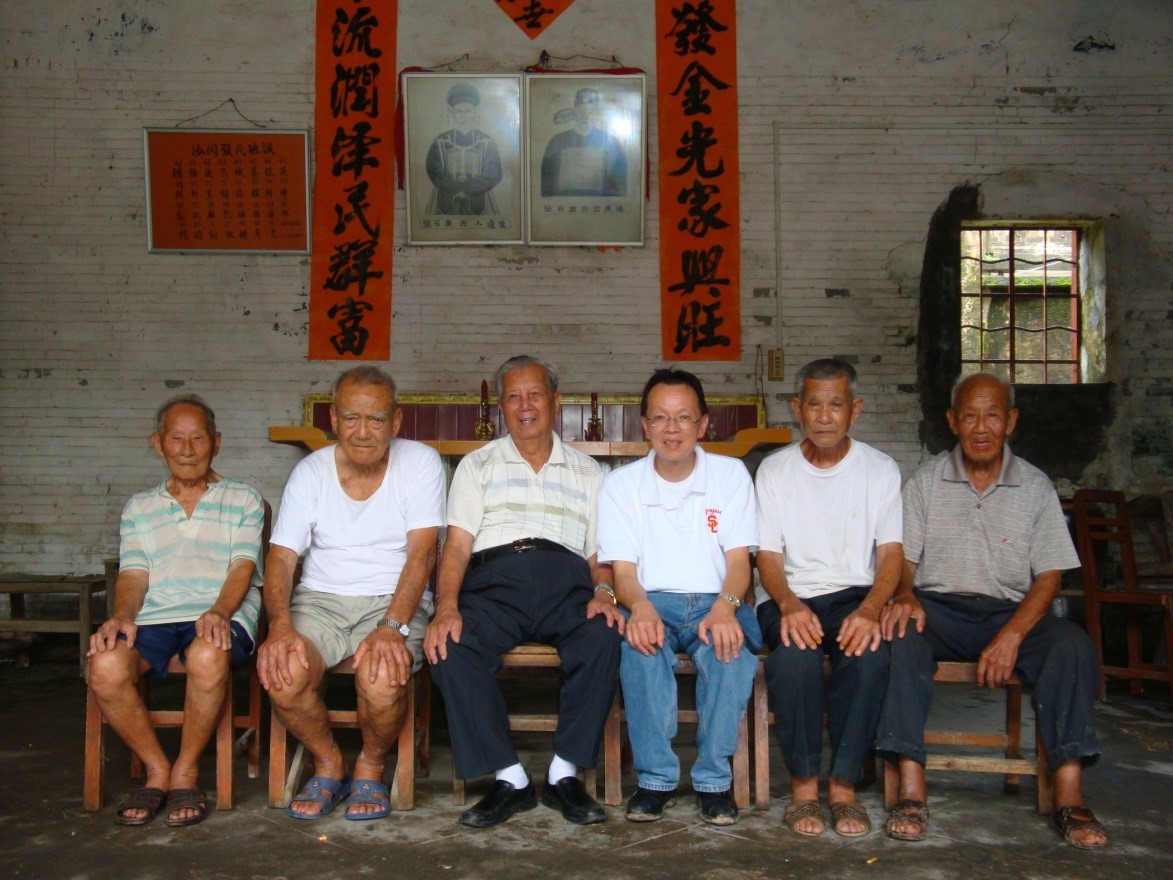 Zhang Weiming with Zhang Youxin and classmates of Zhang Baoshen in Zhang Shiquan Temple
Zhang Weiming with Zhang Youxin and classmates of Zhang Baoshen in Zhang Shiquan TempleRespect (2009)
On the first day of my arrival in China in spring 2009, I hosted a banquet in at Pan Tower International Hotel for my Zhang and Yu (maternal) relatives and my friends. I reunited with my Kaiping Brothers: Zhang Yichao, Huang Zhenhui, and Liang Zhuowei. Zhang Li read aloud to the gathering my poem Kaiping: My Native Land.
We arrived at Long Gang Li. As we waited at the stony pavilion at outskirt of Long Gang Li, I heard the sounds of a pounding drum, a beating gong, and a clanging cymbal inside the Village. I was completely surprised when Zhang Guangye, the Village chief, led an entourage of ten in a Xingshi to celebrate my return. Zhang Huixin carried a pitchfork to eagerly ward off evil spirits. They proudly waved their yellow Zhang Clan flag and a red Xingshi flag. I was deeply humbled by this show of respect as a fallen leaf.
As we marched to the Zhang Shiquan Temple, the villagers waited for me. I was very proud and well excited to stand in front of the Xingshi troupe as they waved the bright Zhang Clan flag. I respectfully honored Zhang Shiquan, the Village patriarch, by bowing with smoky joss sticks and cups of rice wine.
After my reception, Zhang Guangye led me on an excursion of landmarks of Long Gang Li. We looked at three Diaolou, six shrines, and two banyan trees. There were shrines for gnomes for the old villages: Xiang Bei and Lian Tang Li. Near a pond: The Pond of Lotus with the God of the Land and The God of Grain. Another one: Lead a Long Life and Never Die and A God. Near the Zhang Clan Diaolou, I saw a shrine for Divinity of Grain and Earth.
At the Diao Ge watchtower, I found a plaque that read Donation List for Rebuilding Long Gang Li East Wen Ge. It included the names of Zhang Peilan and Zhang Xishou as donors.
Zhang Yongchang and Huang Meihua, the caretakers, then joined me in my ancestral house. I reviewed the inscriptions on the wood panel of the Zhang family altar as well as the shrines. I examined the three ancestral tablets and panel. The tablets proclaim Altars of Zhang Family Generations: Thirty-Seventh Generation Hua Chong and His Wife. The ancestral panel proclaims The Altar of the Thirty-Ninth Generation: Zhang Yao and His Wife and also mentions the fortieth, forty-first, and forty-second generations. They are an invaluable link to the past. I properly placed them at the Zhang family altar that was damaged during the Cultural Revolution.
During a crispy spring day of May 8, 2009, we held the Zhang ancestor respect ritual in Long Gang Li. The villagers greeted me with a glorious Xingshi to the sounds of drums, gongs, and cymbals. We proudly marched along a path lined with the colorful flags of Zhang Clan, Long Gang Kung Fu, Long Gang School, and Xingshi to the Zhang Shiquan Temple.
I humbly greeted the elders at the entry as I entered the Temple. The altar of the Village patriarch was lit by a pair of red candles. I honored Zhang Shiquan by bowing and leaving joss sticks, paper money, and rice wine at the altar. Two elderly ladies, Xu Lianti and Huang Caiyun, carefully managed the ancestral respect ritual. The Lion heartily entered the Temple to pay respect to our Zhang ancestors and bless the offering of baked geese and steam buns to Zhang Shiquan. It danced, pranced, and bowed in front of the Zhang Shiquan altar. Villagers lit firecrackers at the end of the ritual to scare the evil spirits away. My heart and my mind were jubilant in finally respecting the Zhang ancestors in my Kaiping Journey. I was simply overwhelmed by the significance of the moment.
In Chinese culture, ancestral respect is an important tradition. The good fortune of a person is associated with happiness of his ancestral spirits. Three bows show respect to one’s ancestors in heaven. A pair of red candles at the altar lights show the way out of darkness. Flowers symbolize respect and remembrance of ancestors. Food is offered to the ancestors. The smoke of joss sticks represents the ancestral spirits. Hell bank notes represent good fortune to the ancestors. Rice wine is poured on the ground for the ancestors to drink, and firecrackers to scare the evil spirits.
This humble day of Zhang ancestral respect required much preparation. Zhang Guangye made elaborate arrangements. Seven new granite tombstones were engraved for my ancestors at the Fei E Shan and workers cleared the overgrowth at the tombs. The food offering included baked geese, baked chicken, boiled duck eggs, barbeque pork, steamed buns, golden sponge cakes, and snacks, plus rice wine and beer.
At my ancestral house, I met four relatives from Hong Kong for the first time: Huang Cuixiao, Zhang Guoxiang, Zhang Suteng, and Zhang Supeng. Huang Cuixiao is the wife of the late Zhang Cemin, who died in late 2008. Zhang Guoxiang is their son: the forty-third generation. Zhang Peiyi, their ancestor, was the younger brother of Zhang Peilan, my great-grandfather. I showed them my collection of vintage photos from 1920’s. I was very joyful to meet these relatives — another connection to the past. In the parlor above us, I sensed that the spirits of our Zhang ancestors were happy with our family reunion. With Huang Cuixiao, we repeated the ancestral respect ritual in the parlor in front of the Zhang family altar.
During the late morning, about 50 people trekked to the sacred Fei E Shan to respect the Zhang ancestors in the tombs. Two porters carried the offerings and supplies on the trail. We hiked through the monsoon rainforest of eucalyptus on the ferny ground. The Feng Shui master approved this day of respect on April 6, 2009. His marker read May the Project Go Smoothly.
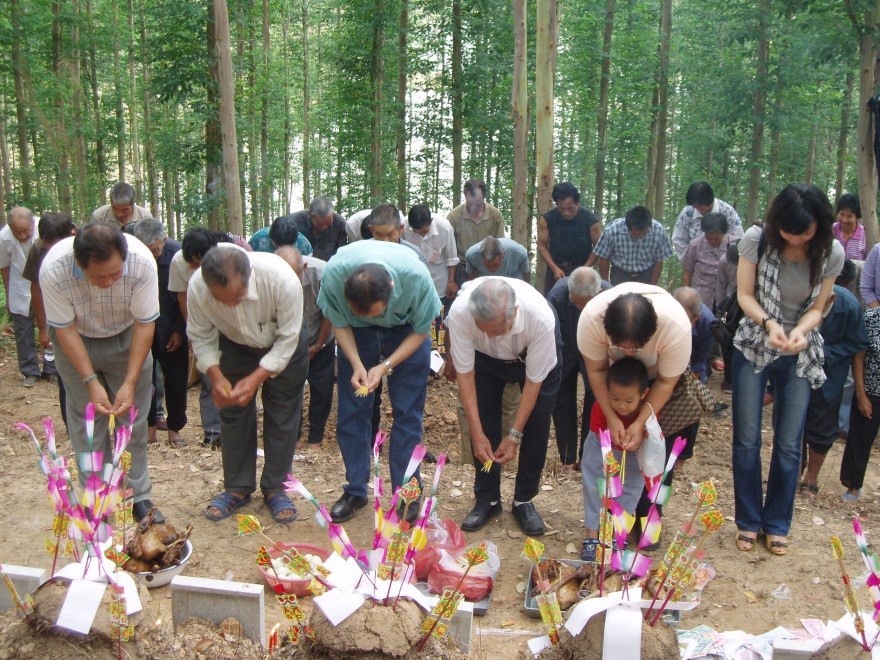 Zhang ancestral ritual held on Fei E Shan
Zhang ancestral ritual held on Fei E ShanAt the tombs on the ferny slope, we offered many plates of geese, pork, eggs, and buns to five generations (thirty-seventh to forty-first) of Zhang ancestors in two rows of tombstones.
Top row:
- Zhang Huadai (37th generation)
- Zhang Chuncan (38th generation)
- Zhang Chunzan (Cheun Saan Jeung) (38th generation)
- Zhang Bingyao (Bein Yiu Chung) (39th generation)
- Zhang Xishou’s (Moi Chung's) wife (41st generation)
Bottom row:
- Zhang Peilan (Hoy Lun Chung) and his wife (40th generation)
- Zhang Peiyi’s wife (40th generation)
Each tombstone read Long Gang Li Generations – Rebuilt in 2009. Burning red candles and joss sticks were placed in front of the tombs. Paper tomb flowers adorned the tomb mounds in display. Paper money lay on the ground for burning. Everyone repeated the ancestral respect ritual and bowed three times with joss sticks, paper money, and rice wine. I scattered bits of bread and egg. Zhang Guangye quickly passed out the lucky money. Healthy, Wealthy, Happy and Come Back, it said. We reverently feasted on the food for our lunch.
During a pensive moment, I touched the coarse tombstones of my eight ancestors. In poignant solitude, I sensed their gentle presence. I smelled the sweet fragrances of the wildflowers, soapwort, redbud, and eucalyptus of the monsoon rainforest. In serenity, I saw the towering peak of Shi Jin and gazed upon crystal Ping Hu as it shimmered during the late afternoon.
As I marveled at the panorama of the Fei E Shan, I was spiritually impressed by the Chinese tradition of ancestral respect. I was humbled as we respected my Zhang ancestors in Long Gang Li.
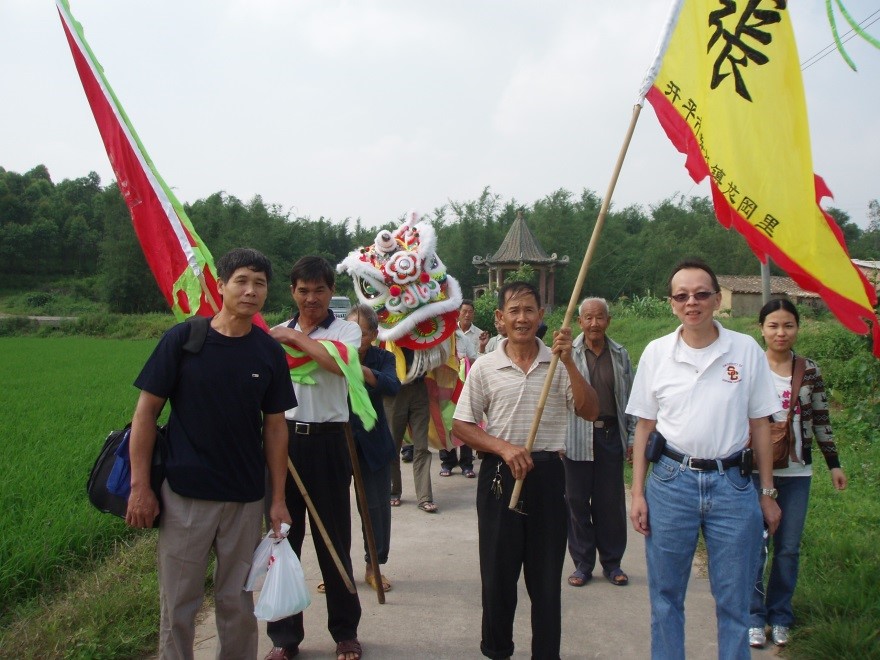 Zhang relatives of Long Gang Li rejoice at return of Zhang Weiming
Zhang relatives of Long Gang Li rejoice at return of Zhang WeimingMuse (2019)
My soulful Kaiping Journey to Long Gang Li has led me to my spiritual awakening in search of my Zhang clan ancestral roots. Through this unforgettable Kaiping Journey, I have gained and absorbed knowledge of my Chinese heritage in Kaiping. My ethos has radically transformed in myriad ways, since January 30, 2003, when my friend, John Thomas Killip, committed suicide in despair in Monterey, California.
My very essence had truly transcended during this fantastic odyssey. From the insolent and surly young American boy who resented the traditions of the past. To a humble and reverent mature Chinese man who respects his Zhang clan ancestors.
Now, I clearly realize that my Zhang clan ancestors have always etched a subliminal influence on my life. They are always in my blood, in my bones, and in my thoughts. With tremendous pride, I am an American with Chinese roots.
A precious part of my heart always dwells in Kaiping, for I deeply value my Zhang relatives and intimate friends there. Upon my return to Gold Mountain, I constantly muse about my Zhang clan ancestors in Kaiping — especially the ancestral respect ritual at Long Gang Li and Fei E Shan.
Adrift in America, I have finally arrived in full circle as a fallen leaf, indelibly rooted in Long Gang Li, with my Zhang clan ancestors, during My Kaiping Journey – From Gold Mountain to Dragon Hill Village.
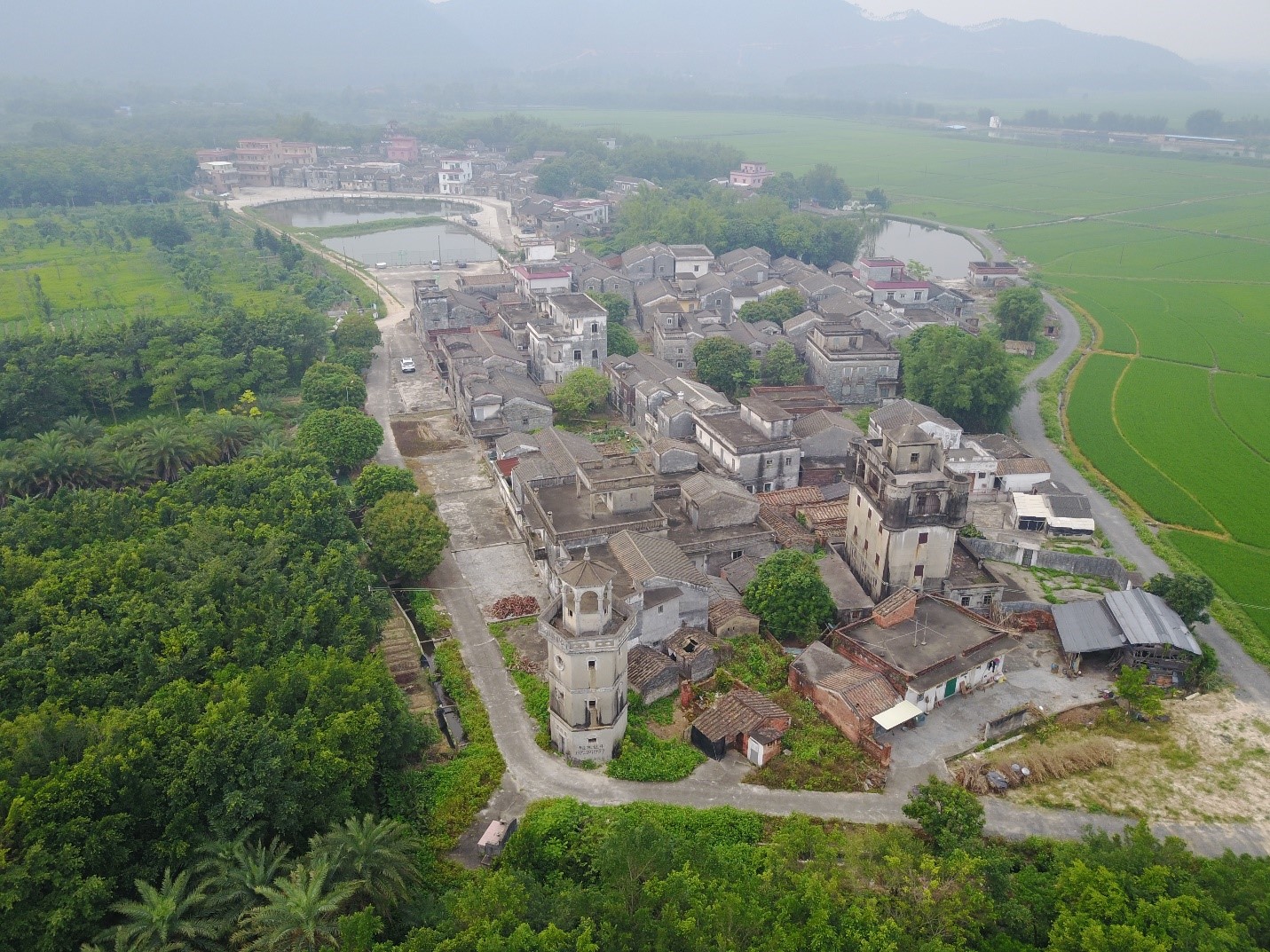 Drone view of Longgangli (1).
Drone view of Longgangli (1).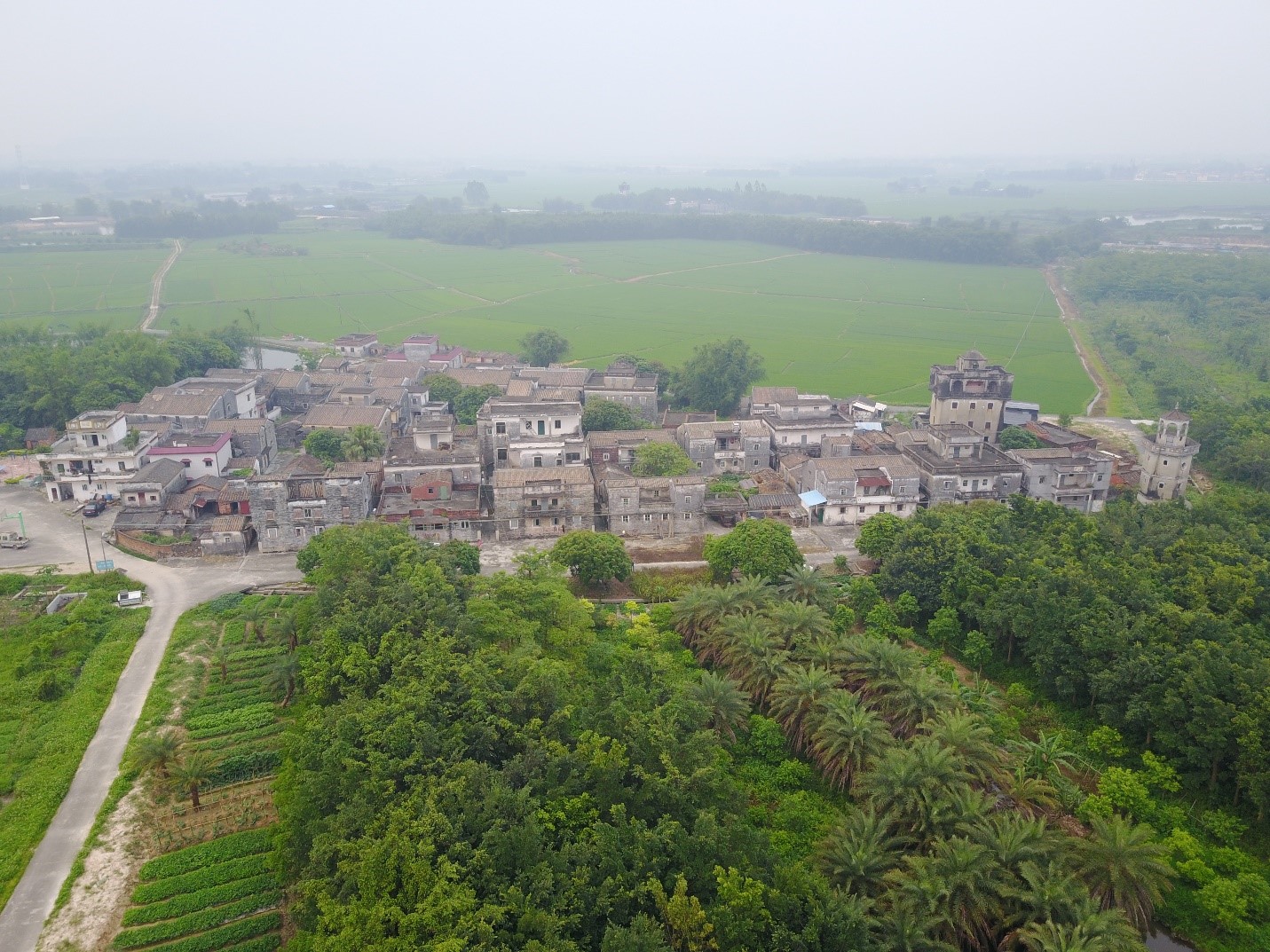 Drone view of Longgangli (2).
Drone view of Longgangli (2).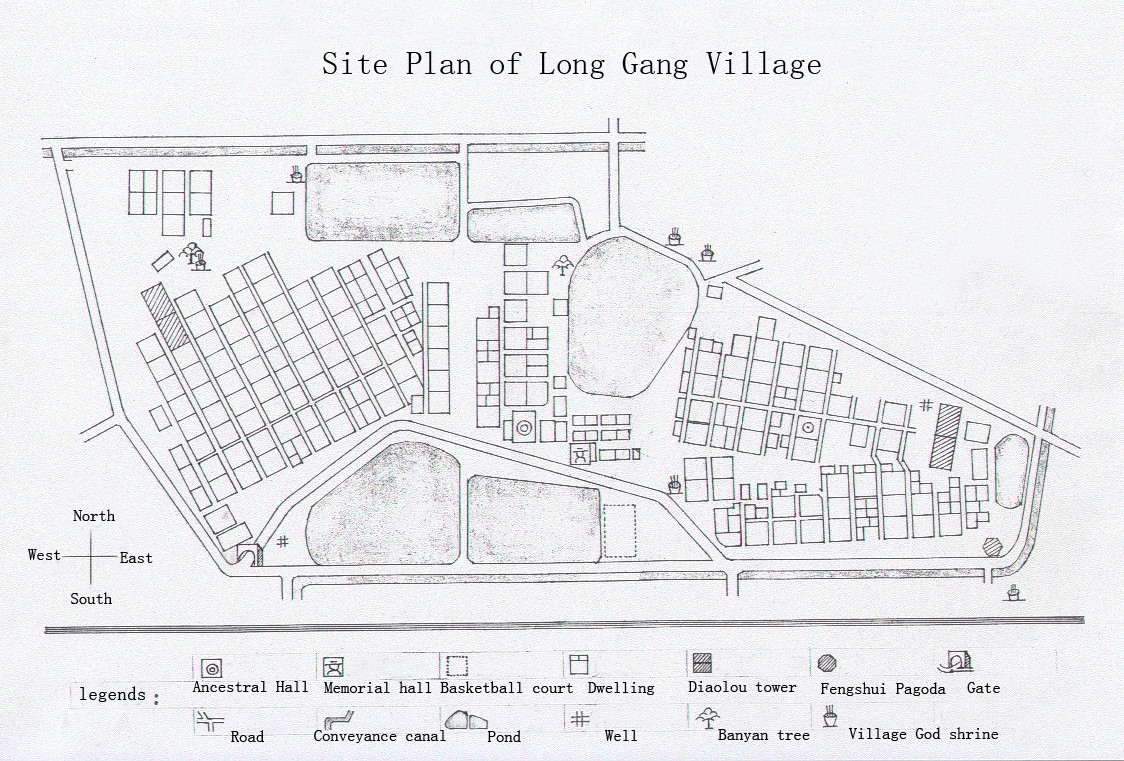
Glossary
Bamboo Rod (Jook Sing) – A metaphor for an overseas Chinese from America.
California Gold Rush – Discovery of gold in California (1848–1855) in northern California and Sierra Nevada goldfields.
Canton (Guangzhou) – A mega port city on South China Sea in Kwangtung in Cathay.
Cathay – Ancient name of China.
Central Pacific Railroad Company – A railroad company that built rail route between California and Utah, as western segment of Transcontinental Railroad, with Chinese railroad workers.
China Clipper – Martin M-130 four-engine flying boat, built for Pan American World Airways, that inaugurated the first commercial transpacific airmail service from San Francisco to Manila in 1935.
China-Meshi – A Nikkei (Japanese American) style of Chop Suey.
Chinese Exclusion Act – American federal law, signed by President Chester Arthur on May 6, 1882, that prohibited all immigration of Chinese laborers to America, until 1943.
Chop Suey – A popular Cantonese cuisine in America.
Diaolou – A tall fortress tower, made of reinforced concrete, that was a fusion of Chinese and Western cultures, in Hoyping.
Fei All Sam (Fei E Shan) – Ancestral tombs of Chong generations, known as Hill of the Flying Swan, near Yung Lew Gong.
Fallen Leaf – A metaphor for a returning sojourner from America to China.
Gum Saan (Gold Mountain) – Cantonese nickname for California and British Columbia by Chinese seeking gold and wealth.
Hoyping (Kaiping) – A city in the Chu Kiang Delta of Kwangtung in Cathay.
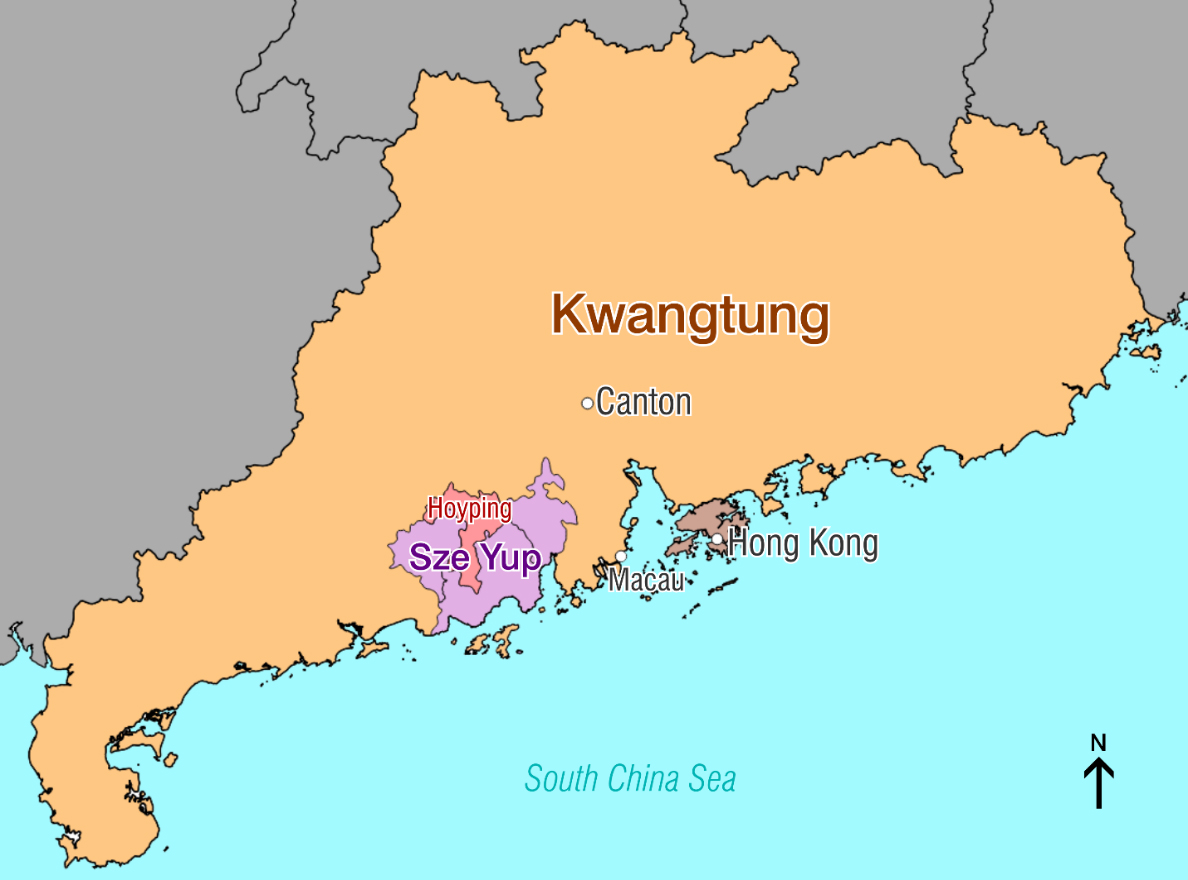 Hoyping in Kwangtung of Cathay
Hoyping in Kwangtung of CathayKongmoon (Jiangmen) – A prefecture-level city in Kwangtung which is home of Sze Yup.
Kwangtung (Guangdong) – A province in Cathay near South China Sea.
Qingming – An annual spring tradition to remember ancestors by sweeping their tombs.
Sye Yup (Wuyi) – Four counties of Sunwui (Xinhui), Toishan (Taishan), Hoiping (Kaiping), and Yanping (Enping) in the Chu Kiang (Zhujiang) (Pearl River) Delta, where early Chinese pioneers came from.
Tam Kiang (Tanjiang) – The main river flowing through Hoyping to South China Sea.
Tong – A criminal gang in Chinatown. Hip Sing Tong and On Leong Tong fought in many Tong wars across America.
Transcontinental Railroad – First 1,912-mile continuous railroad line constructed between 1863 and 1869 that connected the eastern American rail network at Omaha, Nebraska with the Pacific coast at Oakland, California.
Yung Lew Gong (Long Gang Li) – Ancestral village in Hoyping, known as Village of Dragon Hill, of Raymond Douglas Chong.
CONTACT INFORMATION
RAYMOND DOUGLAS CHONG (ZHANG WEIMING)
Mobile: 1.510.915.9810
Email: [email protected]
WeChat ID: raymonddouglaschong